- Customize Trip

- TripAdvisor Awards 2018/2019/2020/2021/2022
- WhatsApp & Viber +977 9851072590
- Mail Support [email protected]
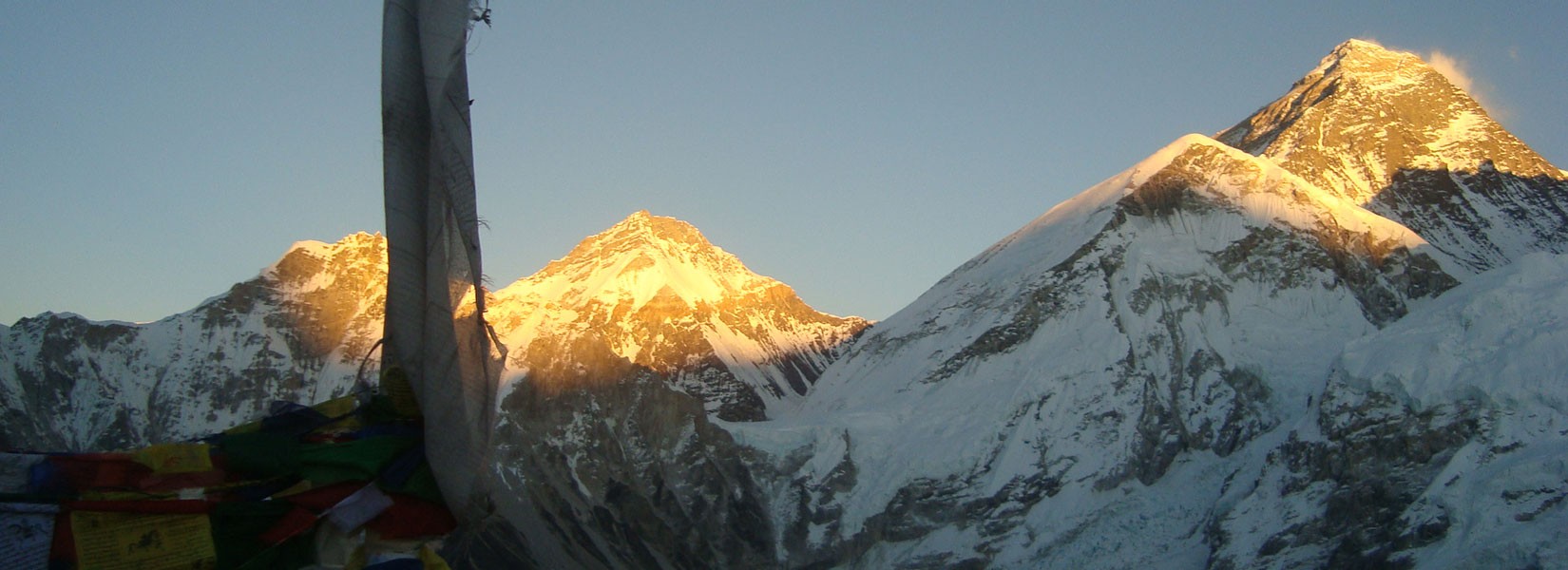
- Everest Base Camp Trek in March
- You are here:
- Travel News

Everest Base Camp Trek in March: Weather, Travel Tips, Packing List and More
- Dec 31, 2021
Table of Contents
Everest base camp trek in march .
Trek to Everest Base Camp during the March month is the ultimate time for high altitude walkers in Nepal Himalaya kingdom. March month is the beginning of spring in this season everything invigorates a new life of nature, the trekking trail will be quiet and offer you an amazing experience of the Everest base camp trek.
While the climate in the mountains is still cold and may still be a problem in some places. The environment is very fresh and able to see very clear mountain vistas. The meadows and forest will be in full bloom with riots of colors of wildflowers specially rhododendron is the national flower of Nepal.
You will be completely enjoying your EBC trek, trekkers hit the trail in larger numbers again in March as well are much good reason to do this trip, here’s what you need to know more details about the trek to Everest Base Camp in March .
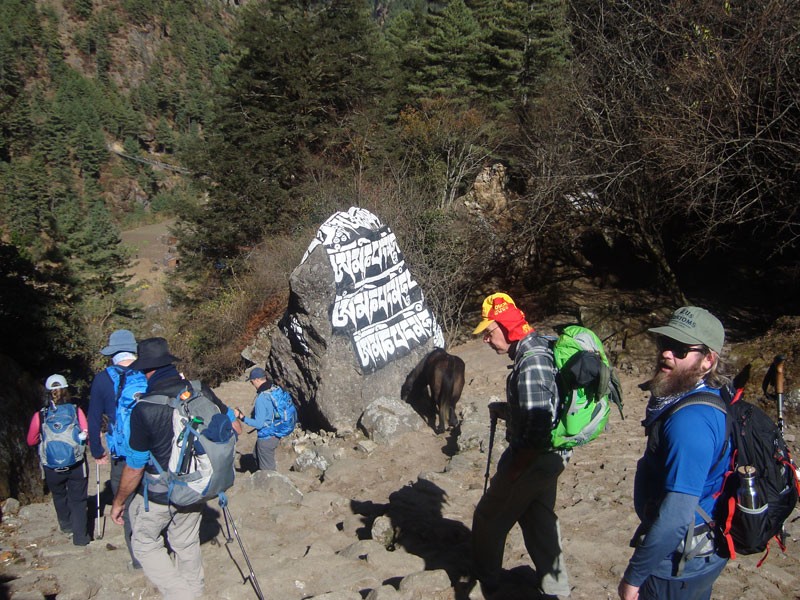
Weather
It is not a month for rain, meaning a very good chance to have beautiful weather and can able to see a clear mountain view along with your trekking to Mt. Everest base camp at 5,364m | 17,593ft . March month s just being the transition from the winter season to spring and will be very fresh weather condition and still, some major trek high passes trek route could be covered by snow. The temperature approximately could be at Everest base camp almost 7 degrees that all in depending on the weather condition.
All the EBC trekkers can enjoy day trek weather night and the morning feels still cold but mountain views are very clear and could able to share your Everest base camp trek experience in good adventure trip and wonderful mountains view in March month trek to Everest Base Camp. There are other benefits for trekkers can enjoy with their hike exploration of Sherpa homeland, and valley in beautiful weather but do not keep in your mind the temperature in the EBC route is unpredictable.
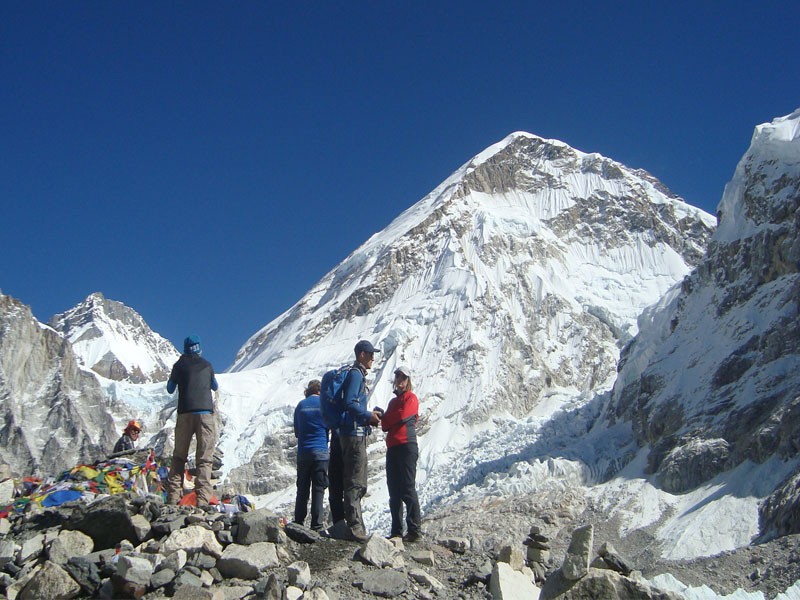
Travel Tips
As per my previous experience, providing you the following Tips about Everest Base Camp Trek in March grab it then share your different experiences with us.
Accommodation, Food, and Cost
Trek to Everest Base Camp in March month would not busy as much as April and May. You can find almost similar lodge-teahouses accommodation on the trek route of EBC beside Lukla and Namche Bazaar both places can able make the overnight sleep in a fancy hotel. Trekking with a good through best local trek operator manages all standard lodges along the EBC trek period.
You can eat breakfast and lunch at the same place where you sleep overnight if you do not eat the same lodge your room bill costs go up to lunch at different Sherpa restaurants day by day and you require to eat Nepali hygienic food as well can find western continental Chinese. Overall daily meals: breakfast, lunch, and dinner cost you approximately USD 20-22 dollars per person per day through Nepalese style.
Advance Well Prepared
Before starting your trek in the high altitude of Everest base camp you need to prepare well in advance! Because the weather in the Everest region is could in morning and night so, you can wear a layer of clothes so that you can add or remove your clothes based on weather conditions.
As you have a very good dream to reach Everest base camp at 5,364m, you require to do in advance morning exercise such as morning walk and cycling it means our muscle and body is fit for trekking 5-6 hours a day along the EBC trek.
Start Your Trek in Early
As per global O’clock in Nepal Everest trek region the March month day is short, the night will be longer, while we require to walk every day 6-7 hours walk before reaching Everest base camp and you need also extra time break for the daily lunch break, soft drink break if you start your trek every day early after the breakfast as per your EBC trek itinerary you will get enough hours time for exploration even more details which is also top tips for you.
Acclimatization
For high altitude trek such as Everest Base Camp-Kalapatthar 5,545m hike, you require at least two rest days (acclimatization) before reaching the EBC which days will help you to your better achievement and require drinks to hydrate regularly to cope with altitude sickness as well the process of acclimatization slowly increases the level of oxygen in your body. Do not make the whole day sleep in the two rest days period you need to ascending at least 300-400 up then descend at your overnight stop point, drinks 3-4 letters clean water help you to get more advantage entire your trek.
Trip Advance Booking
March month is not a busy season, after the 2nd of the week, the trek trail will be started crowds by mass of trekking group sometimes unable to find the accommodation after the Namche. This affects your trekking experience, not in good condition. To get rid of these problems you must select your trek itinerary and book as early as possible for your trip secure advance booking which makes your EBC trip comfortable and never feels again of a bad situation.
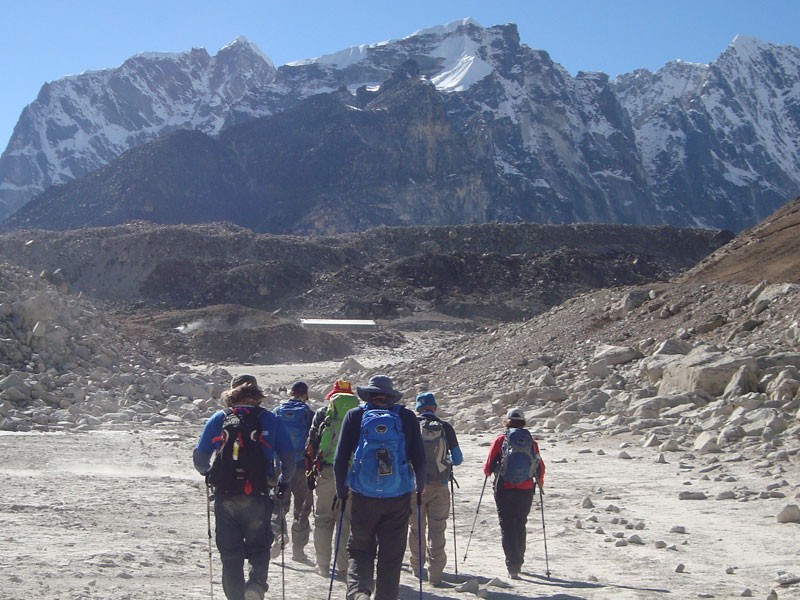
Packing List What to Bring
As we are planning to do the trek during march month, the winter season just passed, and still have a chance to get the cold at high altitude trek routes. Everest Base Camp Trek equipment is very important to know before packing your list in baggage, even though teahouses usually provide blankets but we recommend you bring your own warm sleeping bags. Blankets at teahouses aren’t washed very often due to high altitude and busy season time. A warm down jacket is also necessary for the trek to Everest base camp in March.
It is our great pleasure to recommend in the following EBC trek equipment that what to bring with you while you are doing Everest base camp trek in March as well as you can look up and shopping in Kathmandu-Thamel after your arrival in Nepal but time is also important. Also bring good merino and synthetic fiber clothing to keep you warm in the evenings and nights, as well as woolen hats, gloves, socks, and scarves. Sunscreen is also a must however, Visit this link for your Packing list: Recommend EBC trek equipment
Events In March
The Everest region is mostly Tibetan Buddhist in culture and religion, and several of Nepal’s various exciting festivals come from Hindu traditions, so are not widely celebrated in the mountains zone. If you are planning a trek in Nepal in March, you can share your experience on of the following festivals in Kathmandu before or after your EBC trek .
Hindu traditional Nepalese festival typically follows a lunar calendar, so some festivals that fall in March one year may be in February of April the next. The festivals that often fall in March that you can meet in the following during your Everest base camp trek
Maha Shivaratri
Shivratri-the night of Lord Shiva: This is one the greatest festivals of Hindu religion, celebrated in honor of Lord Shiva. A great religious fair takes place in the Pasupatinath Temple (UNESCO world heritage site) and thousands of people from all over Nepal and India visit this temple they are fast the whole day and celebrate at night. On this day more than a thousand Sadhus (Hindu holy men) are gathered to worship Lord Shiva at Pashupatinath Temple that day and night will be special smoking merriment.
Ghodejatra is known as the festival of horses. It is one of the most exciting festivals in Kathmandu city. Horse face and other sports take place at Tundikhet on this day in other parts of the city the various deities are carried shoulder-high on wheels chariot (Khat) with the accompaniment of traditional music. Mainly this festival performs horse by Nepal army.
This is an interesting festival in Nepal which is known as the festival of colors. People are playing and enjoying throwing different colors between the people of group, families together celebration, they do celebrate this festival two days one for the hilly region, and another for Tari belt.
Popular Trek in Everest Region
Everest Base Camp Helicopter Trek 10 Days
EBC Short Trek 12 Days
Everest View Trek 11 Days
Classic Everest Base Camp Trek 16 Days
Gokyo Lake Renjo La Pass Trek 15 Days
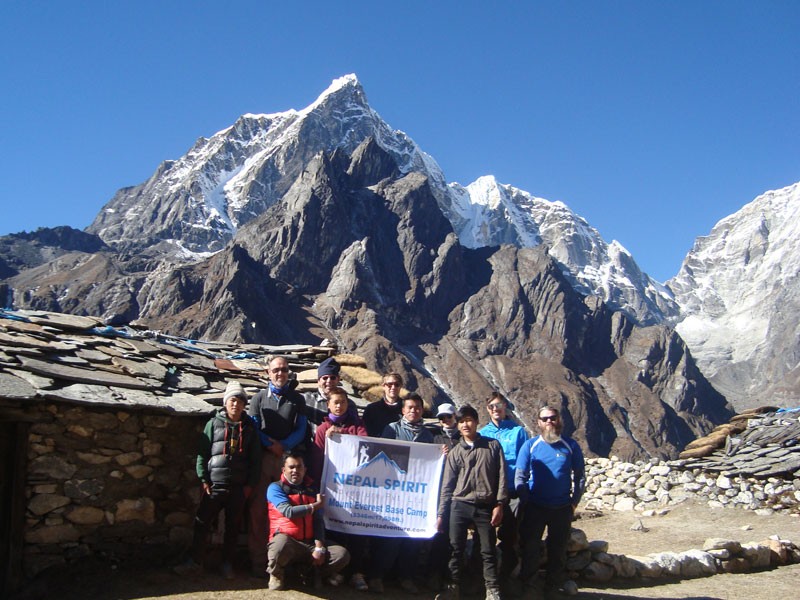
Trek in Nepal Himalaya on high altitude foothill walking is not easy but people have a dream to reach the world’s highest base camp once in a lifetime. In this trek, if you are preparing perfectly for your trekking then you will be successful to reach Everest base camp at 5,364m. You walk slowly from Lukla to EBC with having enough high altitude acclimatization days, book your EBC trek with an expertise Nepal base trek company.
Friendly and experienced trek guides and staff only can make your trip a comfortable and easy journey and start this adventure trek you need to take a short flight from Kathmandu to Lukla. The Lukla flights are normally scheduled before 12 pm; sometimes the flight could be delayed due to frequent changes in the climate of Lukla. But don’t worry flight is scheduled after the climate is favorable for the flight or could be scheduled for the next day.
During the Everest Base Camp Trek in March, the average walking period for trekkers is 5-7 hours per day. If you are uncomfortable with this situation you can apply Luxury Everest Lodge Trek or start the trek slowly from Lukla to Everest base camp then take a helicopter flight to Kathmandu that would be also another advantage of a lifetime experience taking a helicopter flight from a high altitude Gorakh Shep (5170m/16962ft) to Kathmandu which require you 11 night 12 days from Kathmandu to Kathmandu call Everest Base Camp Helicopter Trek
- Everest base camp trek
- Everest Base Camp Trek Tips
Quick Inquiry
Recent post.
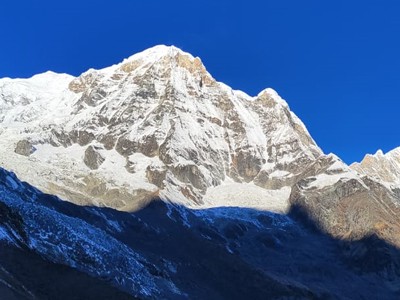
Complete Guide Trek Annapurna Base Camp
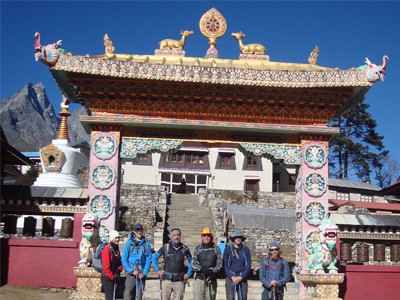
Tengboche Monastery in Khumbu
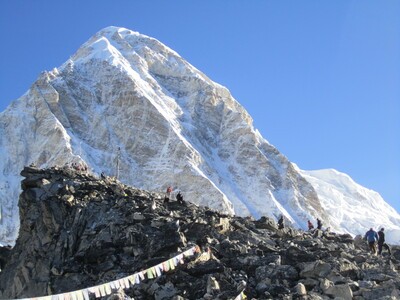
How Long is Perfect for Everest Base Camp Trek
Related posts.
- Chungsi Cave Upper Mustang Nepal
- Everest Base Camp Trek
- Nepal Trekking Season
- News and Events
- Travel & Trekking
- Travel Trekking Insurance
- Trek and Festival
- Trekking and Tour
- Why Everest Trek in October
Himalayan Bloom: Best Spring Treks in Nepal - 2024 Learn More
Kathmandu 44600
Get In Touch With Us
+977-9851098382
Everest Base Camp Trek in March
Have you dreamed of conquering the trek to Everest Base Camp ? There’s no better time than March! As an experienced trekking agency, we highly recommend the Everest Base Camp trek in March, embracing the glorious spring weather.
Temperatures start rising, promising sunnier skies, colorful rhododendrons, and clear mountain views. The warmer climate cuts down the extreme cold even at higher altitudes above 5000m, closer to base camp.
And with fewer crowds than in April, you get to immerse fully into unique Sherpa culture along the trails dotted with historic monasteries and small villages
But don’t underestimate the epic 14-day journey – it requires fitness to handle the uphill climbs plus sensible precautions for acclimatization at higher altitudes.
Join us to tick off that bucket list dream of Everest base camp trek amid picture-perfect frames. A once-in-a-lifetime experience awaits this March!
Table of Contents
Why March is Ideal for Everest Base Camp Trek
If you dream of seeing Mount Everest up close, doing the Everest Base Camp (EBC) trek should be high on your bucket list! And the perfect time to tick it off is March. Wondering why? Read on!
Warmer Weather
In March, winter chills start fading in the Himalayas. This makes walking more pleasant, especially at higher altitudes closer to EBC. You won’t have to worry much about extreme cold or snowfall.
Clear Blue Skies
Another perk of March is clearer skies compared to other months. This gives uninterrupted views of Mount Everest and surrounding peaks like Lhotse, Nuptse, Ama Dablam, and Thamserku.
You can enjoy the view in its full glory! No more cloud cover blocking those jaw-dropping Himalayan vistas.
Enough Time to Get Fit
Trekking to EBC at 5,364 m is tough. You need time to get exercise fit before that.
Starting your training routine in January gives you two full months for that. By March, you’ll be strong enough to take on those steep uphills comfortably.
Fewer Crowds, Lower Costs
March is just before the start of peak season in April. So you’ll find fewer crowds on the trails and tea houses.
This lets you fully soak in the charm of Himalayan villages like Namche Bazaar. Bonus – costs of guides, accommodation, food etc also remain lower!
For More Information, Check Out: When is the Best Time for the Everest Base Camp Trek?
Weather in March
Everest Base Camp Trek in March is an excellent month to visit the Everest region. The weather starts to get warmer, but it is still comfortable for trekking.
Temperatures
The average high temperature in March is about 15°C during daytime. At night, it can drop to around -5°C. So you need to carry warm clothes.
At higher altitudes near Everest Base Camp, it remains quite cold. Temperatures can range from -15°C at night to 5°C during the day.
March is quite dry in the Himalayan region. There are very few rainy days. Skies remain clear most of the time. Very little chance of snowfall at lower elevations.
Strong winds start dying down by early March. This makes it easier to trek and enjoy the views without getting too cold.
March Temperature during Everest Base Camp Trek
Other Insightful Reads Include: Best Spring Treks in Nepal
Classic Everest Base Camp Trek Itinerary
Travel tips.
Though March brings warmer temperatures, you still need to plan carefully for the Everest Base Camp trek. If executed well, an Everest Base Camp trek in March will provide amazing rewards – gorgeous sunny days, stunning views, and a thrilling personal accomplishment.
Plan Carefully
Planning is key to a successful Everest Base Camp trek in March. Make sure to check the detailed weather forecasts before finalizing your trip and gear to pack accordingly.
Invest in good quality trekking gear like sturdy hiking shoes, trekking poles, UV-ray protective glasses, etc. Proper planning and packing based on expected March temperatures and trail conditions will help immensely.
Start preparing your body several months prior through strength training and cardio workouts. Go for uphill hikes carrying weights in your backpack to imitate the steep gains you will encounter en route to base camp.
Building fitness through practice walks is vital to acclimatize better and avoid injury when trekking for long 7-8 hr days on the EBC trail in March.
Acclimatize Properly
Make your Everest Base Camp trek in March safer by giving your body adequate time to acclimatize. Take at least 2 rest days in villages like Namche Bazaar to adjust to the high-altitude environment before proceeding to higher elevations.
Following this acclimatization protocol is crucial to do the strenuous trek comfortably and minimize the risk of altitude sickness.
Carefully pack clothing and gear that matches March temperatures and climate. Even though days are warmer, carry enough insulating layers and waterproof jackets as some parts may still have snow. A suitable day pack is essential.
Prepare for Basic Living
Understand that teahouse accommodations on the trail provide basic lodging and food. But they offer an incredible experience showcasing authentic Sherpa hospitality and culture.
This culture and hospitality is integral to the Everest region’s uniqueness. Embrace this simple mountain lifestyle during your March trek.
You may also like: Everest Base Camp Trek Packing List
Everest Region Treks in March
The Everest region offers some of the most spectacular treks during the month of March. As the winter snow starts clearing, the mountain scenery is at its best, with clear blue skies and relatively stable weather. Some of the most popular multi-day treks that can be done in March include the following:
1. Everest Base Camp Trek – 14 Days
The most popular trek is the 14-day Everest Base Camp trek. This involves trekking to Everest Base Camp and climbing Kala Patthar to get dramatic views of mountains like Everest, Lhotse, Nuptse, Ama Dablam, and more.
2. Everest Base Camp Trek via Gokyo Lakes – 17 Days
Another great option is the 17-day Everest Base Camp trek via Gokyo Lakes, where you hike to the Gokyo Valley to see the spectacular turquoise blue lakes before continuing to Everest Base Camp.
3. Everest Base Camp Heli Trek – 12 days
If short on time, there is the 12-day Everest Base Camp Heli trek – you fly back by helicopter from Gorak Shep after reaching Base Camp, saving the time needed to walk back down.
4. Everest 3 Passes Trek – 19 Days
For adventurous trekkers, the 19-day Everest 3 passes trek involves crossing 3 high mountain passes – Renjo La, Cho La, and Kongma La for an incredible challenge.
5. Everest Base Camp with Island Peak Climbing – 18 Days
You can also combine Everest Base Camp with climbing 6,183 m high Island Peak on the 18-day Island Peak Climbing trek if you have some basic technical climbing experience.
6. Everest Panorama Trek – 9 Days
For those seeking a short trek, there is the 9-day Everest Panorama trek to Kala Patthar and other viewpoints.
What’s on in March
March brings colorful cultural festivals to the Everest region that vibrantly bless your trek.
As spring blooms, Hindus celebrate Maha Shivaratri by singing devotional songs and lighting lamps in Lord Shiva’s name. It commemorates the powerful forces governing the universe.
This month’s full moon also brings the Fagu Purnima, which the famous Holi Festival in Nepal marks. You’ll see locals covered in brightly colored powders as part of Holi, the festival of colors and love. The festive mood makes for a joyful experience as you trek through local villages.
For those seeking a unique Holi adventure, opt for specialized Holi treks in Nepal .
Observing these wonderful festivals lets you connect deeper with the Nepalese culture while taking on the adventure.
And there you have it – the excellence of an Everest Base Camp trek in March. Whether it’s the warmer dry weather, spectacular views unobstructed by clouds, or experiencing the spiritual Holi festival, a March teahouse trek to base camp simply can’t be matched.
The gradually ascending summer allows you to acclimatize better while avoiding brutal winter conditions. You’ll return not just with memories lasting forever through each glorious step but also with a newfound strength that stretches your limits.
Come Chase your Everest dream under glorious blue heavens this March. A life-affirming adventure atop the world’s highest peak happily awaits!
About Glorious Eco Trek Nepal
Known for their top-notch service and attention to detail, Glorious Eco Trek Nepal leads trekkers on breathtaking journeys through the towering peaks and rolling hills of the Himalayas.
Make an Enquiry
Your Full Name
Phone Number
No. of person
Your message (If any)
Privacy Overview
+977 9841319155
Everest Base Camp Trek in March: Weather, Route, and More
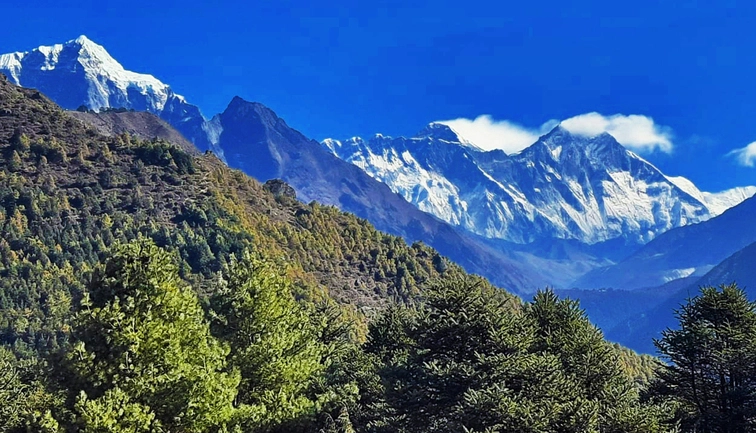
Wondering when to trek the Everest Base Camp ? Well, then the best answer is March. Yes, trekking to the Everest Base Camp Trek in March is one of the best times of the year to opt for the EBC trek. From the stunning landscapes, clear skies, and breathtaking views to the magical mountain vistas, March offers the most wonderful trekking experiences as a whole.
March marks the beginning of the spring season in the Himalayas. The whole Khumbu valley comes alive once again breaking the end of the winter season. The snow begins to melt, revealing the majestic Himalayan peaks beneath. These towering giants shine in the sun, offering awe-inspiring views that are a true feast for the eyes. Frozen lakes thaw and transform into stunning turquoise pools, reflecting the sky above and adding to the allure of the landscape.
So, in this blog, we will discuss in depth about the various aspects of trekking to the Everest Base Camp Trek in March.
But before that let’s have a look at the major highlights of the Everest Base Camp Trek in March.
- Ideal trekking weather with comfortable temperatures.
- Spectacular landscapes with blooming rhododendrons and clear skies.
- Unobstructed views of majestic Himalayan peaks.
- Cultural immersion with Sherpa festivals.
- Opportunity for wildlife sightings.
- Reduced risk of extreme cold.
- Picturesque lakes and rivers along the route.
Weather Conditions and Temperature in March
In March, the Everest Base Camp Trek welcomes adventurers with a fascinating blend of weather conditions. This month marks the transition from the harsh winter season to the rejuvenating spring, known as “Bashant Ritu” in Nepal. During the day, temperatures are relatively warm, reaching approximately 17 degrees Celsius (62.6°F), creating a comfortable atmosphere for trekking. However, as the sun sets and the mornings arrive, the mercury plunges, often dipping to as low as -7 to -12 degrees Celsius (19.4 to 10.4°F). This shift necessitates warm clothing to combat the chilly nights.
Talking about the weather conditions, what makes March particularly enticing for trekkers is its reputation as a dry season, boasting low humidity levels and minimal rainfall. These conditions result in nearly constant clear skies, providing unobstructed views of the awe-inspiring mountain vistas. While precipitation is scarce, early March may occasionally surprise trekkers with snow showers at higher altitudes, adding an element of adventure to the journey.
Perhaps the most captivating aspect of trekking to the Everest Base Camp Trek in March is the clarity of the skies, which provides trekkers with a front-row seat to the grandeur of the Himalayan peaks. The absence of fog or dense cloud cover allows for crystal-clear views, including the iconic Mount Everest, Lhotse, Nuptse, and Ama Dablam among many others. Additionally, these clear skies translate to fewer Lukla flight disruptions, enhancing the overall trekking experience.

Main Attractions of the Everest Base Camp Trek in March
Blooming Rhododendrons and Vibrant Wildlife:
March brings life back to the Khumbu Valley. The rhododendron forests come to life with colorful blossoms, creating a stunning contrast against the snowy peaks. Along the trekking trail, flowers of all shapes and sizes bloom, painting the terrain with shades of red, yellow, and purple. The sweet fragrance of wildflowers fills the air, creating a sensory symphony that envelops trekkers in a natural paradise.
With the arrival of spring, the region’s wildlife also becomes more active. Trekkers may have the chance to spot various Himalayan species, including pheasants and musk deer, as they venture out in search of food and mates. The sighting of these creatures adds an element of adventure to your trek.
Festivals and Cultural Insights:
March often coincides with the colorful and vibrant festivals celebrated by the Sherpa community, such as Losar (Tibetan New Year). Participating in these celebrations can provide you with a deeper cultural understanding of the region and a chance to interact with the warm-hearted locals who call the Khumbu Valley home. You might even get the chance to witness traditional dances and ceremonies that are an integral part of Sherpa culture.
Avoiding Crowds:
Unlike the busier trekking months of April, May, October, and November, March provides a much quieter experience than those months. The trekkers are just starting to flow in which makes the trails less crowded, allowing you to relish the tranquility of the Himalayas and connect with fellow trekkers in a more intimate setting. It’s an excellent time for those seeking a peaceful escape in nature.
Food and Accommodations
One of the advantages of trekking to Everest Base Camp in March is the easy accessibility of the accommodations because the EBC route is not as busy as in April. All the hotels, lodges, and teahouses start to open as soon the March begins. Hence, you can fully immerse and experience the trek without having to worry about getting the accommodations or booking the rooms beforehand.
Accommodations throughout the Everest region offer cozy rooms equipped with essential dining facilities. These rooms include basic amenities such as beds, pillows, blankets, towels, and other necessities to cater to the needs of trekkers. It’s worth noting that most teahouses provide rooms on a twin-sharing basis. However, for those seeking more privacy, single private rooms are readily available, at a slightly higher cost than the standard rate.
Furthermore, the teahouses in the Everest region boast a delectable array of dishes to satiate your appetite. Whether you prefer vegetarian or non-vegetarian options, you’ll find a variety of flavorful meals to enjoy after a long day of hiking. These dishes are carefully prepared to provide the necessary nutrition and energy to sustain you on your trekking journey.
Other recommended trekking routes in March
In addition to the classic Everest Base Camp Trek, the Everest region in March offers a wide array of trekking options to suit various preferences and time durations. Whether you have limited time or seek extended adventures, Everest caters to all trekking enthusiasts.
For those with a shorter duration available, the Everest View Trek, spanning 6-10 days, is an excellent choice. This trek provides a comparable trekking experience to the Everest Base Camp journey. While you won’t reach the Base Camp, you’ll still be treated to awe-inspiring views of Everest and other majestic mountains, all while enjoying the scenic beauty of the region.
As for additional side trips, two popular options include the Gokyo Lake Trek and the Ama Dablam Base Camp Trek. The turquoise Gokyo Lake and the stunning Ama Dablam offer unforgettable vistas that are truly worth experiencing at least once in a lifetime.
For those with a strong desire for a hardcore adventure, consider the Three High Pass Trek or engage in peak climbing. March is generally an accessible time for peak climbing in the Everest region, with options like Island Peak , Lobuche Peak , and Mera Peak . These endeavors provide the ultimate challenge and reward for adventure seekers, allowing you to conquer some of the region’s most iconic peaks.

Everest Trek Difficulty in March
March stands out as one of the most favorable months for trekking in the Everest region. Nevertheless, the level of trek difficulty remains contingent on an individual’s fitness and readiness. The trail’s rugged terrain, undulating landscapes, and diverse geography bestow both adventure and challenges upon trekkers. Undoubtedly, altitude emerges as the primary determinant of Everest Base Camp trek difficulty , with one’s mental and physical well-being playing pivotal roles. Whether you are a seasoned trekker or a novice, the trek’s inherent challenges cannot be circumvented.
However, trekking in March offers a notable reduction in difficulty when compared to the winter or monsoon seasons. During this time, the trails are clear of snow, ice, and mud, ensuring a smooth journey. The warmer weather adds to the trek’s suitability, allowing you to explore comfortably. To reduce the risk of altitude sickness , it is essential to maintain proper hydration and adopt a deliberate walking pace. Additionally, the option of hiring porters to shoulder your backpacks can alleviate the physical strain.
In general, the Everest Base Camp trek in March is not a challenging trek. With adequate guidance and meticulous preparations, virtually anyone can undertake this remarkable journey with confidence.
What to pack for the Everest Base Camp Trek in March?
Packing for the Everest Base Camp Trek in March requires careful consideration due to the varying weather conditions and the need to stay comfortable while hiking at high altitudes. Here’s a comprehensive list of what to pack:
Moisture-Wicking Base Layers: Lightweight, moisture-wicking tops and bottoms to keep you dry and warm.
Insulating Layers: Fleece or down jackets to provide warmth in colder conditions.
Waterproof Jacket: A durable, waterproof, and windproof jacket to shield against rain and cold winds.
Trekking Pants: Comfortable, quick-drying trekking pants with zip-off options for versatility.
Warm Hat and Gloves: Insulated gloves and a warm hat to protect against the cold.
Thermal Socks: A few pairs of moisture-wicking and insulating socks.
Hiking Boots: Sturdy, waterproof, and well-fitting hiking boots with good ankle support.
Gaiters: To keep snow, rocks, and debris out of your boots.
Accessories:
Sunglasses: Polarized sunglasses with UV protection to shield your eyes from the bright mountain sun.
Sunscreen: High SPF sunscreen to protect your skin from the intense mountain sun.
Lip Balm: Moisturizing lip balm with SPF to prevent chapped lips.
Headlamp/Flashlight: A reliable headlamp or flashlight with extra batteries for evening use.
Trekking Poles: Collapsible trekking poles for added stability during the hike.
Buff or Neck Gaiter: Versatile for covering your face, neck, or head as needed.
Backpack and Gear:
Backpack: A comfortable, sturdy backpack with a rain cover for carrying your essentials.
Sleeping Bag: A good-quality, cold-rated sleeping bag suitable for the trek.
Water Bottles or Hydration System: At least two reusable water bottles or a hydration reservoir to stay hydrated.
Toiletries:
Toothbrush and Toothpaste: Compact and travel-sized options.
Soap and Shampoo: Biodegradable soap and shampoo for eco-friendly use.
Wet wipes and toilet papers
Passport and Permits: Keep your passport, permits, and photocopies in a waterproof bag.
Snacks: High-energy snacks like energy bars, nuts, and dried fruits.
Cash: Carry some Nepali Rupees for expenses along the way, as ATMs are limited.
Trekking Maps and Guidebook: Handy for navigation and information about the trek.
Tips for the Everest Base Camp Trek in March
Trekking to Everest Base Camp in March is a rewarding adventure, but it comes with its own set of challenges and considerations. Here are some valuable tips to help you make the most of your trek:
1. Start Your Trek Early:
Begin your trek early in the day to take advantage of the clear morning skies and minimize the risk of afternoon cloud cover obstructing mountain views.
2. Layer Your Clothing:
March weather can be variable. Layer your clothing so you can easily adjust to temperature changes throughout the day. This allows you to stay comfortable as you ascend to higher altitudes or if the weather unexpectedly shifts.
3. Stay Hydrated:
Dehydration is a common issue at high altitudes. Drink plenty of water throughout the day to stay well-hydrated, and consider using a hydration system for easy access to water while walking.
4. Walk Slowly and Steadily:
The higher you go, the thinner the air becomes. Walk at a slow, steady pace to acclimatize properly and reduce the risk of altitude sickness.
5. Acclimatize Properly:
Plan rest days into your itinerary to allow your body to adjust to the altitude. Use these days to explore nearby villages or take short hikes to higher altitudes and then return to sleep at a lower elevation.
6. Hire a Local Guide and Porter:
Consider hiring a local guide who is familiar with the terrain and can help you acclimatize safely. Porters can carry your heavy backpack, reducing the physical strain on you.
7. Pack Snacks:
Carry high-energy snacks like energy bars, nuts, and dried fruits to keep your energy levels up while trekking.
8. Respect Local Culture:
Be mindful of the local culture and customs. Remove your shoes when entering homes or monasteries and ask for permission before taking photos of people.
9. Bring Sufficient Cash:
ATMs are scarce along the trekking route, so carry enough Nepali Rupees for expenses like food, accommodation, and incidentals.
10. Stay Warm and Dry:
Ensure you have proper rain gear and a waterproof cover for your backpack, as mountain weather can be unpredictable, and rain or snow showers are possible.
11. Be Prepared for Tea Houses:
Tea houses along the route offer simple accommodations and meals. Don’t expect luxurious amenities, but enjoy the unique experience of staying in these mountain lodges.
12. Train and Prepare:
Before your trek, engage in physical training to build your stamina and fitness. Cardiovascular exercises and strength training can help prepare your body for the demands of high-altitude trekking.
13. Respect the Environment:
Practice responsible trekking by disposing of waste properly and avoiding single-use plastics. Leave no trace to help preserve the pristine environment.
14. Obtain Necessary Permits:
Make sure you have the required permits for the trek. These include the Sagarmatha National Park Permit and the TIMS (Trekkers’ Information Management System) card.
15. Stay Informed:
Stay updated on weather conditions and trail conditions by talking to locals, your guide, or fellow trekkers.
By following these tips and trekking responsibly, you can have a safe and memorable journey to Everest Base Camp in March, soaking in the breathtaking beauty of the Himalayas while respecting the local culture and environment.
In conclusion , if you’re considering the Everest Base Camp Trek in March, don’t hesitate to reach out to us at Nepal Peak Adventure . We’re committed to providing you with the finest trekking experiences, and our team is available 24/7 to address any questions or concerns you may have. Your journey to the majestic Himalayas awaits, and we’re here to make it unforgettable.
Your email address will not be published. Required fields are marked *
Nepal Peak Adventure
Nepal Peak Adventure stands as a premier trekking and travel agency dedicated to curating exceptional and memorable journeys in the heart of the Himalayas.

Trekking & Climbing
- Everest Region
- Annapurna Region
- Langtang Region
- Manaslu Region
- Dolpo Region
- Short Treks
- Beginner's Level Climbing
- Intermediate Level Climbing
- Challening Level Climbing
- Legal Documents
- Trekking Guides
- Climbing Guides
- Celebration
Bhagwan Bahal Street, Thamel, Kathmandu- Nepal
What’s App: +977 9841319155
+(977) 9841319155

- Terms & Conditions
- Privacy Policy
How To Do The Everest Base Camp Trek In Nepal
The Mount Everest Base Camp Trek in Nepal is one of the world’s best bucket list hikes. In less than 2 weeks, you can trek to the foot of Mt Everest and other snowy peaks in the Himalayan mountains.
The good news is that it’s not a super difficult hike, and you don’t need a big budget to do it. The EBC trek is worth it for the fun and accomplishment alone, but you also get views of the Himalayas that are out of this world.
This travel guide will explain how you can do the Mt Everest Base Camp hike independently (with or without a tour guide), along with a recommended packing list and everything else you need to know before you go!
Best Everest Base Camp Tours
First of all, if you’d rather skip the hassle of planning your own EBC Trek, Klook has Everest Base Camp Tours starting as low as $900 USD for a full 12-day trek.
You may be able to find something cheaper than this once you land in Kathmandu, but booking online with a vetted tour company has some big advantages, and the reviews on their website are very positive.
We’ve used Klook for lots of tours and activities around the world, and they’re great! Highly recommended.
Book Now: Everest Base Camp Tours

When To Do The EBC Trek
The Mt Everest region has 4 different trekking seasons:
- March – May: High season. Best weather, with stable temperatures and bright sunny days, but the trails can get crowded. During these months you may share the EBC trail with pro climbers on the way to go summit Everest.
- June – August: Monsoon season. There’s a lot more rain during these months, and the trails are mostly empty.
- September – October: Clear days and busy trails. This is one of the most popular trekking seasons.
- November – February: Coldest season, but the weather is stable and dry. The trails are mostly clear.
I trekked in early February, and even though it was nice having the trail mostly to myself, the cold in the evenings and mornings was straight up misery.
My home state of Missouri can get very cold in the winter, but the cold has just never been my thing. If I could go back and change it, I would definitely do my Everest Base Camp hike later in the season.

Everest Base Camp Weather
Temperatures on the Mt Everest Base Camp Trek can range from 5 °C (40 °F) to 20 °C (70 °F) depending on month, and as low as -30 °C (-22 °F) at night during the winter months.
If you trek during the warmer months (Mar-May and Sep-Oct), the cold is not a big problem and shouldn’t be hard to cope with. Winter is a different story. Your snot will freeze in your nose at Gorak Shep.
Sunshine is key for winter trekking in Nepal, and thankfully you should have lots of sun in most months outside of the monsoon season. On my February hike, I often found myself shedding all my layers while trekking because I was heating up in the sun.
If you do your Everest Base Camp hike during the winter, the biggest issue is staying warm in the evenings and at night. For this, you’ll definitely want a top quality down jacket and sleeping bag.

All About Everest Base Camp Trekking
My everest base camp itinerary.
- Day 1: Kathmandu to Lukla to Benkar .
- Day 2: Benkar to Namche Bazaar .
- Day 3: Namche Acclimatization Day .
- Day 4: Namche to Deboche .
- Day 5: Deboche to Pangboche .
- Day 6: Pangboche to Dingboche .
- Day 7: Dingboche Acclimatization Day .
- Day 8: Dingboche to Thukla .
- Day 9: Thukla to Gorak Shep .
- Day 10: Everest Base Camp .
- Day 11: Kala Patthar to Gorak Shep to Pheriche .
- Day 12: Pheriche to Namche .
- Day 13: Namche to Lukla .

If you ever need motivation to keep going on the Everest Base Camp hike, just look at how much the porters are carrying!

Mount Pumori as seen from the Kala Patthar viewpoint, just a short distance from Mt Everest Base Camp.

Ama Dablam, one of my favorite mountains on the Mt Everest Base Camp Trek.
EBC Trek Packing List / Gear
This isn’t a complete list of everything to bring on a Mt Everest Base Camp Trek, and you may have to change things up a little depending on what month you go, but these are just some of the basics.
You can find most of this gear in Kathmandu, but in my opinion you’ll get higher quality and a wider selection if you order online.
- Beanie: I only wore this at night, but it definitely helped keep my ears warm.
- Down Jacket: Bring the biggest, warmest DJ possible. This is your most important piece of gear. You can use it as an extra cover at night.
- Fleece Sweater: This is the only jacket you’ll need to wear while trekking most days, especially if it’s sunny.
- Shirts: Something comfy with quick dry material.
- Trekking Pants: Something lightweight and breathable.
- Thermal Underwear: May not be needed if you trek in the warmer months.
- Gloves: I only wore these at night, but they definitely helped keep my hands warm.
- Socks: Merino wool is best for staying warm and stopping moisture.
- Headlight: Smart to have at least a small one, just in case.
- Tumbler: 1 liter water bottle to refill daily on the trek.
- Sunblock: It’s easy to sunburn at high altitudes. A small bottle is plenty.
- Sunglasses: Good for snow. May not be necessary unless you plan to hike a mountain pass like Cho La.
- Hat: I wore old faithful throughout the hike.
- Watch: An altimeter watch would be fun to play with here.
- Camera: Duh. You can’t do the Mt Everest Base Camp Trek without taking lots of pictures.
- Power Bank: Bring a big power bank and you might only need to recharge it once on the whole trek.

Everest Base Camp Trek Cost
For a 13 day trek, I paid about $21 USD per day for food, drinks, and room. Porter/guide was an extra $25 per day, although it’s not a requirement. Flights to Lukla were $330 return, but again not a requirement if you hike in.
You can read the sections below for more info on the daily trekking costs and what you get for your money. It’s not a very expensive trek, all things considered!
Keep in mind, these numbers are from 2020. They’ll go up a little over time. Exchange rates may also vary, so check the latest rates .

The flight to Lukla from Kathmandu is $165 USD each way. You can shop for flights to Lukla at Skyscanner.
If your budget is tight or you have extra time, you can skip this flight by hiking from Jiri to Lukla rather than flying. It only adds a couple days to the itinerary.

Guide / Porter / Solo
You can do the EBC trek with a guide, porter, OR independently (solo).
A guide will show you the way to Mt Everest Base Camp and help with lodging, navigation, advice, taking pictures for you, etc. A porter-guide will do these same things and also carry a 20 kg (45 lb) pack for you.
A porter or guide is NOT a requirement to do this hike, especially if you go in the warmer months when you may not need as much gear. In 2023, they were supposedly introducing a guide requirement for EBC, but so far that has not been enforced at all, thankfully.
With that said, there are some good advantages to hiring a guide, and it’s pretty cheap by Western standards. A porter is only $15 or $20 USD per day, and a porter-guide is $25 per day. A popular arrangement is to hire one porter for two hikers, splitting the cost and still making things easier for both of you.
In the end, this all depends on your budget and hiking preferences.

Hiking Fees
If you’re hiking EBC independently, you’ll need to be aware of two fees you have to pay near the start of the trek.
There’s a local government tax that they’ve now started collecting in Lukla. This one is currently 2,000 Rupees ($17 USD).
There’s also an Everest park fee/ticket you have to pay at the Sagarmatha National Park entrance just beyond the small village of Monjo, Nepal. This one is currently 3,500 Rupees ($30 USD).
No TIMS card is needed anymore for independent hikers. That fee has been retired for the Mount Everest Base Camp Trek.

Accommodation & Amenities
Throughout the Everest Base Camp hike, you’ll stay and sleep at small guesthouses along the way, called teahouses.
This is where you get your meals and drinks for the trek, along with the occasional amenities like showers, charging, or WiFi. The teahouses start out decent, but quickly get more shabby as you go further up the trail.
You have to pay for everything you use, of course, and the prices get quite high as you go, because everything has to be hauled up on the backs of the poor porters.

Guesthouses
The teahouses on the EBC trek are cold and dingy, with drop toilets and cracks in the walls. Don’t expect luxury.
Most rooms are free as long as you buy your meals there (the meals are how they make their money). If you stay at a lodge and don’t eat there, you’ll be expected to pay for the room.
In some cases, I was charged 500 Rupees for a room on top of my meal costs. I’m not sure why some teahouses do this and others don’t, but I never paid more than 500 Rupees for a room, and most were free with the meals.

Food & Drink
I’m happy to report that the food and drinks on the Everest Base Camp hike are top notch, especially after you’ve worked up an appetite trekking.
You have western food choices, or the standard local staples like veggie fried rice, steamed momos (dumplings), and mushroom soup. Everything was hot and fresh. Meal prices for these ranged from 250 to 750 Rupees depending on altitude. Not too bad.
For drinks I tried hot chocolate, lemon/apple/mint tea, and occasionally bottled water for my tumbler. These ranged from 100 to 400 Rupees. If you want to avoid plastic bottles, there’s usually boiled water available and this is safe to drink too.
Getting enough water on the trek is never a problem. Just fill up a 1 liter tumbler in the morning, and this will last you until evening, especially since you’re likely to pass more tea houses along the trail as you’re hiking throughout the day.

Showers are only available at a few lodges, depending on the season and how high up you are, and they cost 600 to 1200 Rupees. In the winter, water higher up will be frozen most of the time.
I never had a shower on my February EBC trek, and that seems to be the norm (although I got one or two opportunities in Namche). Yes, it’s gross. I could smell myself by trek’s end, and it wasn’t pretty.
But aside from the fact that I hate to fork out money for something as basic as a shower, I also never really got close to other people for very long on the trek, so I didn’t feel too guilty about it.
Most days were cold enough that the thought of stripping down for a shower was not really appealing, either. Your best bet is baby wipes and deodorant.

WiFi / Cell Service
WiFi costs anywhere from $5 to $10 USD per day if you buy it from the teahouses.
Alternatively, you can buy a 10 GB/30 Day Everest Link WiFi card in Namche Bazaar and use this for the entire EBC trek. During my Mount Everest Base Camp Trek the WiFi was down across the whole region, so unfortunately I wasn’t able to use either of these options.
I bought an Ncell local SIM card in the Kathmandu airport and had 3G service for half the days of the Everest Base Camp hike. Coverage is still improving in the area, so if you need to stay connected I’d definitely bring a local SIM.

Electricity
All of the teahouses on the way to Mt Everest Base Camp sell outlet charging for electronics, and the prices range from $2 to $10 USD for a full charge, depending on how far up the trail you are.
The key is to bring a big power bank and then use this to charge all of your other electronics (phone, camera, etc). I did this and only paid once to recharge my power bank on the whole trek.

How Much Cash To Bring
Everything you buy during the Everest Base Camp hike (meals, WiFi, charging, etc) will have to be paid for with cash. Credit cards won’t work. There are no ATMs outside of Lukla and Namche Bazaar (Days 1-4), and even the ATMs there are not reliable.
What this means is that you’ll have to withdraw enough cash (Nepalese Rupees) at an ATM in Kathmandu to cover your entire trek. The ATM fees will bite you, and I hate to carry large amounts of cash, but it’s not really avoidable here.
All up, I spent about $20 USD (2,400 Rupees) per day on the Mount Everest Base Camp Trek, and never spent more than $25 USD in a single day. With that said, I didn’t splurge on WiFi, showers, charging, or alcohol. The only things I bought were the bare necessities: room, food, and drinks.
If you hire a porter/guide, you don’t need to factor that into your daily cash carry. That’s paid before the trek starts. But do reserve a little cash for a decent tip.

Mount Everest Base Camp Trek Difficulty
I’m not going to lie, this is a difficult trek. And if you do it in the winter like I did, it’s even harder. With that said, if you are in decent shape, determined, and obey the guidelines for altitude sickness prevention (more on that below), then you’ll have no problem reaching base camp.
There is a lot of elevation gain and loss on this hike. At times near Lukla, the constant ups and downs will make you feel like you’re hiking a roller coaster, but the trail is never too steep or dangerous. After Namche, it’s mostly a slow uphill plod.
This trek has been completed by old seasoned hikers in their 70s, and young kids in their pre-teens. It’s also been flunked by healthy 20-30 somethings who try to push through it quickly without enough acclimatization to altitude.
Patience and discipline are key for trekking to Everest Base Camp. Slow and steady wins the race here.

Trekking Distance
The one way trekking distance from Lukla to Mt Everest Base Camp is about 65 kilometers (40 miles).
That means the total roundtrip distance of an EBC Trek is about 130 kilometers, even if you don’t do any of the detours.
Don’t let that scare you off. It’s a lot of hiking, but every step is worth it.

Altitude Sickness
By far your biggest danger on the Mount Everest Base Camp Trek is altitude sickness, also known as Acute Mountain Sickness (AMS).
No one is immune to this, and it doesn’t matter how fit you are. If you gain altitude too fast, you can get sick and in some cases even die. Plenty of people have died from AMS on the EBC Trek.
The problem is that overzealous hikers push the envelope on this hike all the time, and a lot of them end up needing a very expensive helicopter evacuation to lower ground.
The best way to avoid altitude sickness is to go slow . At altitudes above 3,000 meters (10,000 feet), don’t increase your sleeping elevation by more than 300-500 meters (1,000-1,500 feet) per night.
Every 1,000 meters (3,000 feet) you should also spend a second night at the same elevation. If you get a bad headache, dizziness, or nausea, descend to a lower altitude until you feel better. As long as you follow these general guidelines, you shouldn’t have any issues.
You can take Diamox (acetazolamide) on the trek for extra AMS prevention. This medication can be found in Kathmandu or Namche. I bought mine in Namche and it seemed to help my headache and slight foggy feeling. I didn’t have any side effects aside from the usual tingling toes/fingers.

Everest Base Camp Altitude
The Mount Everest Base Camp altitude is 5,364 meters (17,598 feet). At this elevation, there is 50% of the oxygen at sea level.
However, most treks also go to Kala Patthar, a viewpoint even higher than base camp where you can get the best views of Mount Everest.
The elevation at Kala Patthar is 5,644 meters (18,519 feet). From there, you’ll be rewarded with an incredible panorama of Mount Everest and other icy peaks like Pumori, Lhotse, and Nuptse.
Happy travels!

If you’d rather skip the hassle of planning your own EBC Trek, Klook has Everest Base Camp Tours starting as low as $900 USD for a full 12-day trek.
You may be able to find something cheaper than this once you land in Kathmandu, but booking online with a vetted tour company has some big advantages, and the reviews on their website are very positive for this Mt Everest Base Camp tour.
More Nepal Travel Tips
Hopefully you were helped by this guide for the Everest Base Camp Trek. Let me know in the comments below if I can help answer any questions.
Don’t forget to check out my complete Nepal Travel Guide with tips, info, photos & more!
You may also like
How to visit dhigurah island: budget paradise in maldives, 10 best hikes in aruba: family friendly trails, how to visit tanjung puting national park in indonesia, sanur bali travel guide: 23 best things to do, coron vs el nido: which is better all differences explained, banggai islands travel guide & itinerary for sulawesi.
So much useful detailed information.
Thanks for the straight forward information. Beautiful photos

Leave a Comment Cancel Reply
Save my name, email, and website in this browser for the next time I comment.

Himalaya Discovery Adventures
Everest Base Camp Trek in March
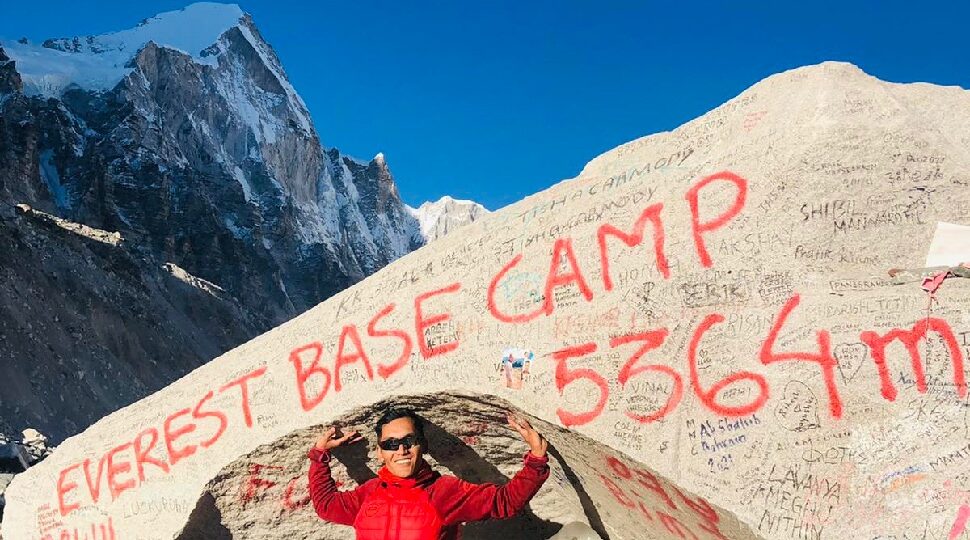
March is the starting of spring, one of Nepal’s two high season. While temperatures in the high Himalayas are likely to be chilly. Hikers hit the trails in big number again in March, and there are several good reasons to do so. Here’s everything you need to know about hiking to Everest Base Camp in March.
Everest Base Camp Weather in March
Rain is uncommon in March, so clear mountain views in the Everest region is great. However, as temperature goes up throughout Nepal, especially the second half of the month, humidity rises. You’ll still get good clear views, but they won’t be as crisp or as reliable as they were in the winter.
The advantage is, of course, that March has warmer temperatures than January or February . While snow may remain at higher altitudes, and unexpected snowfall can break plans at any time, many trails will be thawing out by this time.
You should still prepare for chilly weather—temperatures in Namche Bazaar, for example, can drop below -3°C in the night. But they can also be as high as 12°C.
Everest Base Camp Trek: Crowds & Costs
While March isn’t as busy as April, guesthouses on the classic Everest Base Camp (EBC) route fills up quickly during this time. Trekking with a professional Sherpa guide is one way of preventing this, as they will book you into a decent lodge, although the options will be limited due to how busy the trails are.
Alternatively, you might choose an offshoot of the EBC trip that explores the same area but takes a less traveled route. Some ideas are given below.
Routes Recommendations
The classic Everest Base Camp trip is famous for a reason—but it is incredibly popular. There are numerous alternative routes in the Everest area that overlap with EBC but take you down quieter paths if you prefer quieter routes and views unobstructed by other trekkers’ heads.
Some of the more off-the-beaten-path camping expeditions are not recommended in March as temperatures at higher altitudes may still be cold, especially at night, and snow could be a concern. However, as March marks the start of the spring trekking season, many teahouses will reopen after their winter break, providing better accommodation choices than in January or February.
The Gokyo Ri trek diverges towards the blue waters of the trail’s nickname glacial lakes. The Tengboche Monastery trek leads you to one of Nepal’s most important Buddhist monasteries, from which you can see the spectacular Ama Dablam.
The Dingboche journey is similar but extends a little further to the little Dingboche village. The Ama Dablam Base Camp trek is also a great way to explore a place that many people seem to miss when trekking in this area.
Trekking peaks are usually accessible again in March, so if you want a more difficult challenge than a simple trip and have prior high-altitude climbing experience, a trekking peak is a suitable beginning to Himalayan climbing. Island Peak (20,305 feet/6,189 m) is a difficult but not too technical climb.
The journey to get there follows much of the classic EBC trek, so if this is your first time in the region, you can get the best of both worlds by following a popular route and going somewhere less visited.
What You Should Bring?
While the good teahouses normally provide blankets, it’s always a good idea to carry your own sleeping bag. Teahouse blankets aren’t washed very often, so they’re best used as a top layer, above your own cozy sleeping bag.
While a winter-weight sleeping bag will most likely be useful, they are quite bulky. Combining a three-season sleeping bag with teahouse woolen blankets should sufficient, as long as you also have appropriate clothing .
Down jackets are good because they are lightweight and easily packed away during the day if you get too warm while walking. Bring woolen hats, gloves, socks, and scarves, as well as good merino and synthetic fiber clothing to keep you warm in the evenings and nights.
Getting There and Away
Flying from Kathmandu to Lukla is the shortest way to reach the Everest region. Although rainfall is normally low in March, Kathmandu is especially smoggy and dusty in the run-up to the monsoon in June, which could cause flight delays.
Domestic flights between Kathmandu and Lukla will also fill up quickly in March, so book as far in advance as possible.
Know more how to get to the Lukla
If you’re looking for a longer adventure and wish to walk (nearly) the entire distance, take the trail from Jiri to Lukla. The ‘Pioneers’ Route’ was named after the trekking route that early Western mountaineers used to reach the Everest region before Lukla’s airport was built. Jiri is located approximately one day’s journey from Kathmandu.
Festivals and Events in March
The Everest region is mainly Tibetan Buddhist in culture and religion, and many of Nepal’s most interesting March festivals are based on Hindu traditions, so they are not widely celebrated in the mountains.
However, if you plan a trip in Nepal in March, you can join one of the following Kathmandu festivals before or after your trek. Traditional Nepali celebrations usually follow a lunar calendar, therefore certain events that fall in March one year may fall in February or April the next. Festivals that so often fall in March are:
Ghode Jatra is a Kathmandu-specific celebration during which the Nepal Army races horses at the parade ground (Tundhikhel) to ward off the demon Gurumapa.
Maha Shivaratri is especially vibrant at Kathmandu’s Pashupatinath Temple, where thousands of sadhus (Hindu holy men) gather to worship Lord Shiva.
Holi is a spring festival in which water and colorful powders are thrown around in celebration.
Our Top EBC itineraries in March
- Everest Panorama Trek – 11 Days
- Gokyo Ri Trek – 14 Days
- Everest Three Passes Trek – 16 Days
- Everest Base Camp and Climb Island Peak – 20 Days
More Useful Information
- Everest Base Camp in January
- Everest Base Camp in November
- Best Time to Time to Trek Everest Base Camp
- Nepal in April
Do you have any question about trip to Nepal?
- Solo Traveller
- Number of child (if you have child in your family/group) (Optional)
- When will you be traveling?* * Day 1 2 3 4 5 6 7 8 9 10 11 12 13 14 15 16 17 18 19 20 21 22 23 24 25 26 27 28 29 30 31 Month 1 2 3 4 5 6 7 8 9 10 11 12 Year 2025 2024 2023 2022 2021 2020 2019 2018 2017 2016 2015 2014 2013 2012 2011 2010 2009 2008 2007 2006 2005 2004 2003 2002 2001 2000 1999 1998 1997 1996 1995 1994 1993 1992 1991 1990 1989 1988 1987 1986 1985 1984 1983 1982 1981 1980 1979 1978 1977 1976 1975 1974 1973 1972 1971 1970 1969 1968 1967 1966 1965 1964 1963 1962 1961 1960 1959 1958 1957 1956 1955 1954 1953 1952 1951 1950 1949 1948 1947 1946 1945 1944 1943 1942 1941 1940 1939 1938 1937 1936 1935 1934 1933 1932 1931 1930 1929 1928 1927 1926 1925 1924 1923 1922 1921 1920
- How many days do you have?* *
- Give your trip a short title* *
- Private Trip
- Bellow 200$
- 200$ - 500$
- 500$ - 800$
- 800$ - 1200$
- 1200$- 2000$
- 2000$ and above
- Describe your trip* *
- Full Name* *
- Your Email* *
- Country* * Afghanistan Albania Algeria American Samoa Andorra Angola Anguilla Antarctica Antigua and Barbuda Argentina Armenia Aruba Australia Austria Azerbaijan Bahamas Bahrain Bangladesh Barbados Belarus Belgium Belize Benin Bermuda Bhutan Bolivia Bonaire, Sint Eustatius and Saba Bosnia and Herzegovina Botswana Bouvet Island Brazil British Indian Ocean Territory Brunei Darussalam Bulgaria Burkina Faso Burundi Cabo Verde Cambodia Cameroon Canada Cayman Islands Central African Republic Chad Chile China Christmas Island Cocos Islands Colombia Comoros Congo Congo, Democratic Republic of the Cook Islands Costa Rica Croatia Cuba Curaçao Cyprus Czechia Côte d'Ivoire Denmark Djibouti Dominica Dominican Republic Ecuador Egypt El Salvador Equatorial Guinea Eritrea Estonia Eswatini Ethiopia Falkland Islands Faroe Islands Fiji Finland France French Guiana French Polynesia French Southern Territories Gabon Gambia Georgia Germany Ghana Gibraltar Greece Greenland Grenada Guadeloupe Guam Guatemala Guernsey Guinea Guinea-Bissau Guyana Haiti Heard Island and McDonald Islands Holy See Honduras Hong Kong Hungary Iceland India Indonesia Iran Iraq Ireland Isle of Man Israel Italy Jamaica Japan Jersey Jordan Kazakhstan Kenya Kiribati Korea, Democratic People's Republic of Korea, Republic of Kuwait Kyrgyzstan Lao People's Democratic Republic Latvia Lebanon Lesotho Liberia Libya Liechtenstein Lithuania Luxembourg Macao Madagascar Malawi Malaysia Maldives Mali Malta Marshall Islands Martinique Mauritania Mauritius Mayotte Mexico Micronesia Moldova Monaco Mongolia Montenegro Montserrat Morocco Mozambique Myanmar Namibia Nauru Nepal Netherlands New Caledonia New Zealand Nicaragua Niger Nigeria Niue Norfolk Island North Macedonia Northern Mariana Islands Norway Oman Pakistan Palau Palestine, State of Panama Papua New Guinea Paraguay Peru Philippines Pitcairn Poland Portugal Puerto Rico Qatar Romania Russian Federation Rwanda Réunion Saint Barthélemy Saint Helena, Ascension and Tristan da Cunha Saint Kitts and Nevis Saint Lucia Saint Martin Saint Pierre and Miquelon Saint Vincent and the Grenadines Samoa San Marino Sao Tome and Principe Saudi Arabia Senegal Serbia Seychelles Sierra Leone Singapore Sint Maarten Slovakia Slovenia Solomon Islands Somalia South Africa South Georgia and the South Sandwich Islands South Sudan Spain Sri Lanka Sudan Suriname Svalbard and Jan Mayen Sweden Switzerland Syria Arab Republic Taiwan Tajikistan Tanzania, the United Republic of Thailand Timor-Leste Togo Tokelau Tonga Trinidad and Tobago Tunisia Turkmenistan Turks and Caicos Islands Tuvalu Türkiye US Minor Outlying Islands Uganda Ukraine United Arab Emirates United Kingdom United States Uruguay Uzbekistan Vanuatu Venezuela Viet Nam Virgin Islands, British Virgin Islands, U.S. Wallis and Futuna Western Sahara Yemen Zambia Zimbabwe Åland Islands Country
- Phone Number (Optional)
You May Also Like...
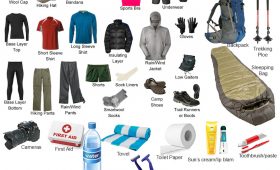
Everest Base Camp Trek Packing List
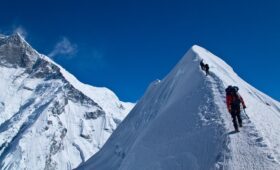
Climbing Island Peak
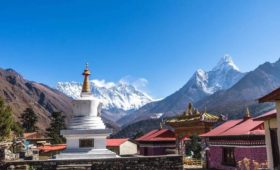
Everest Base Camp Trek in December
Leave a reply cancel reply.
Your email address will not be published. Required fields are marked *

“I was born and raised in Nepal, nearby Everest region. I am proud to be a native Sherpa, and I have been a Mountain guide over a decade now. Following my passion, I decided to start helping travelers with their travel plans! I think life is a journey, a trip where you collect experiences when you share with other people and with nature.”
Privacy Overview
Trekking and Peak Climbing in Nepal
- Regd. No.:63295/065/066
- Tourism Licence:1632
- VAT No.:303818070
Home » Everest Guide » Everest Base Camp Trek in March
Everest Base Camp Trek in March
Everest Base Camp Trek is one of the most exciting base camp adventures in the world. This classical trekking route in Nepal takes you to the magnificent Himalayas of the Khumbu region. If you are considering this once-in-a-lifetime experience, then you might be wondering what might be the perfect timeframe for the exploration. Although Himalayan explorations in Nepal are most ideal during the peak seasons, spring and autumn, the Everest Base Camp Trek in March offers astonishing prospects that you have never seen before.
Nestled between the end of the winter and the peak of spring, allurements of this month simply outshine others. March houses the climatic conditions of the autumn for a comfortable trekking experience and offers the spectacular landscapes of the spring season. This month, which rings the bell for the awakening of the blooming season, takes you on an unforgettable journey across the breathtaking Himalayan region that is slowly molding from snow blankets to the fur of lush bloom.
Everest Base Camp Trek in March- Trek Overview
Your exciting Everest Base Camp Trek in March kick starts with a heart-throbbing scenic flight from Kathmandu (1,350 meters) to Lukla (2,800 meters). Then, after landing at Lukla you will commence your trekking adventure and follow the banks of the Dudh Koshi River to reach Phakding (2,610 meters).
You will then move along with your ascending charming trails heading toward the Sherpa Capital, Namche Bazaar (3,445 meters). After enjoying acclimatization day at Namche you will continue to further elevation jump points of this trek like Tengboche (3,850 meters), Dingboche (4,350 meters), Lobuche (4,950 meters), and Gorakshep (5,160 meters), the last settlement in this trekking route.
The further part of this journey will take you to the goal of this exploration, Everest Base Camp (5,364 meters), and the vantage point of the Khumbu Valley, Kalapatthar (5,554 meters). After concluding this exciting trekking adventure at the base of Everest, you will then retrace your steps all the way back to Lukla on the same route for a flight back to Kathmandu .
Why Everest Base Camp Trek in March?
Ideal climatic conditions.
During your Everest Base Camp Trek in March, you will be greeted with the most favorable climatic conditions in the spring season. Due to bits of winter still lingering around during the first part of the month, the freshness is simply outstanding.
The temperature of the trekking region in Everest hovers around 12°C to 18°C during the month of March. So, you will be able to enjoy an incredible trekking adventure in mild temperatures like autumn. The daytime temperatures at the trekking trails are warm and during the evenings and early mornings, refreshing cool breezes make the experience refreshing.
However, as the temperatures at the alpine altitudes can drop upto -10°C during night. So, make sure to pack different sets of layers for a comfortable exploration.
Clear Mountain Views
The Everest Base Camp Trekking route rewards the explorers with stunning views of the Himalayan peaks like Everest, Lhotse, Makalu, Cho Oyu, Nuptse, Pumori, Thamserku, Ama Dablam, and other incredible peaks. So, naturally, you would want the month with the best visibility to relish the magnificent views of these Himalayan gems during your exploration.
March the dark horse of the spring season offers the most spectacular views of these grandeur peaks. Thanks to a stable climate and lower precipitation, you will be able to see the incredible Himalayan vistas of the region, as far as your eye can reach.
Scenic Landscapes
There might be hardly anyone who is not familiar with the bloom spring season brings. The visuals are especially stunning on the Himalayan region that comprises sub-tropical to alpine regions.
Most people choose the spring season for its enthralling colorful trail and opportunity to encounter the magnificent flora and fauna of the Himalayan region. However, this exciting trek in March introduces you to a unique phenomenon of the natural cycle.
During your Everest Base Camp Trek in this month, besides the natural allurements of nature’s peak season, you will also encounter the magical moments of nature’ transition. The snow-clad landscapes slowly start to wither away as the bloom of spring gradually extends it territory. This incredible phenomenon of nature in the Himalayas can only be witnessed in this month.
Less Crowded Trails
The start of March officially ends the reign of the winter season. The winter slowly starts to disappear in the background leaving stage to the nature’s ally. However, as the transition process isn’t immediate, the bits of peak Himalayan season are still left around at the corners.
So, the temperature unlike the peak autumn month of October can be slightly chilly during March. Most trekkers avoid this starting month of the spring season aiming for slightly warmer weather conditions. That’s why the trekking trails are less crowded than in the latter months of the season.
You will able to enjoy a serene exploration opportunity on the isolated trail. This also adds more room to your interaction with locals as well as exploration of highlights where you normally would have to be considerate of the crowd behind you.
Wildlife Encounter
You will have more chances of encountering Himalayan flora and fauna in this season than to moderate crowds. Unlike getting spooked by the mainstream crowd, the endangered wildlife of the region are roaming close to the trekking trails relishing the spoils of the peak season.
Also, the migratory birds looking for a warm nestle flock from all around the world to Nepal. So, this starting month of the spring season also offers an incredible opportunity for bird watching as well.
Incredible Photography Opportunity
Thanks to the diverse landscapes of this trail comprised of lush forested regions, high hills, wide pastures, and glacial moraines, the photography prospects of this month are quite extensive. On top of that, the wildlife and birdlife of the Himalayan region that are enjoying the warmth after a long winter are more visible during this starting month of spring.
Your close encounter with these incredible species of the Himalayas will create spectacular photogenic opportunities. If you are a landscape photography enthusiast, the perfect shots of the pristine peaks across the stunning colourful visuals of the blooming season will also be something magical.
- Full Name *
- Country * Afghanistan Åland Islands Albania Algeria American Samoa Andorra Angola Anguilla Antarctica Antigua and Barbuda Argentina Armenia Aruba Australia Austria Azerbaijan Bahamas Bahrain Bangladesh Barbados Belarus Belgium Belize Benin Bermuda Bhutan Bolivia Bonaire, Sint Eustatius and Saba Bosnia and Herzegovina Botswana Bouvet Island Brazil British Indian Ocean Territory Brunei Darrussalam Bulgaria Burkina Faso Burundi Cambodia Cameroon Canada Cape Verde Cayman Islands Central African Republic Chad Chile China Christmas Island Cocos Islands Colombia Comoros Congo, Democratic Republic of the Congo, Republic of the Cook Islands Costa Rica Côte d'Ivoire Croatia Cuba Curaçao Cyprus Czech Republic Denmark Djibouti Dominica Dominican Republic Ecuador Egypt El Salvador Equatorial Guinea Eritrea Estonia Eswatini (Swaziland) Ethiopia Falkland Islands Faroe Islands Fiji Finland France French Guiana French Polynesia French Southern Territories Gabon Gambia Georgia Germany Ghana Gibraltar Greece Greenland Grenada Guadeloupe Guam Guatemala Guernsey Guinea Guinea-Bissau Guyana Haiti Heard and McDonald Islands Holy See Honduras Hong Kong Hungary Iceland India Indonesia Iran Iraq Ireland Isle of Man Israel Italy Jamaica Japan Jersey Jordan Kazakhstan Kenya Kiribati Kuwait Kyrgyzstan Lao People's Democratic Republic Latvia Lebanon Lesotho Liberia Libya Liechtenstein Lithuania Luxembourg Macau Macedonia Madagascar Malawi Malaysia Maldives Mali Malta Marshall Islands Martinique Mauritania Mauritius Mayotte Mexico Micronesia Moldova Monaco Mongolia Montenegro Montserrat Morocco Mozambique Myanmar Namibia Nauru Nepal Netherlands New Caledonia New Zealand Nicaragua Niger Nigeria Niue Norfolk Island North Korea Northern Mariana Islands Norway Oman Pakistan Palau Palestine, State of Panama Papua New Guinea Paraguay Peru Philippines Pitcairn Poland Portugal Puerto Rico Qatar Réunion Romania Russia Rwanda Saint Barthélemy Saint Helena Saint Kitts and Nevis Saint Lucia Saint Martin Saint Pierre and Miquelon Saint Vincent and the Grenadines Samoa San Marino Sao Tome and Principe Saudi Arabia Senegal Serbia Seychelles Sierra Leone Singapore Sint Maarten Slovakia Slovenia Solomon Islands Somalia South Africa South Georgia South Korea South Sudan Spain Sri Lanka Sudan Suriname Svalbard and Jan Mayen Islands Sweden Switzerland Syria Taiwan Tajikistan Tanzania Thailand Timor-Leste Togo Tokelau Tonga Trinidad and Tobago Tunisia Turkey Turkmenistan Turks and Caicos Islands Tuvalu Uganda Ukraine United Arab Emirates United Kingdom United States Uruguay US Minor Outlying Islands Uzbekistan Vanuatu Venezuela Vietnam Virgin Islands, British Virgin Islands, U.S. Wallis and Futuna Western Sahara Yemen Zambia Zimbabwe Country
- Number of Travellers *
- Phone Number
- Approximate Date Day 1 2 3 4 5 6 7 8 9 10 11 12 13 14 15 16 17 18 19 20 21 22 23 24 25 26 27 28 29 30 31 Month 1 2 3 4 5 6 7 8 9 10 11 12 Year 2025 2024 2023 2022 2021 2020 2019 2018 2017 2016 2015 2014 2013 2012 2011 2010 2009 2008 2007 2006 2005 2004 2003 2002 2001 2000 1999 1998 1997 1996 1995 1994 1993 1992 1991 1990 1989 1988 1987 1986 1985 1984 1983 1982 1981 1980 1979 1978 1977 1976 1975 1974 1973 1972 1971 1970 1969 1968 1967 1966 1965 1964 1963 1962 1961 1960 1959 1958 1957 1956 1955 1954 1953 1952 1951 1950 1949 1948 1947 1946 1945 1944 1943 1942 1941 1940 1939 1938 1937 1936 1935 1934 1933 1932 1931 1930 1929 1928 1927 1926 1925 1924 1923 1922 1921 1920
- Send us your enquiry *
- Solve (6+6=?) & submit button will appear *
You may also like:
- Salleri to Everest Base Camp Trekking
- Everest Base Camp Trek Via Jiri
- 12 Days Everest Base Camp Trek
- Everest Base Camp Cho La Pass Gokyo Trek Return By Helicopter
Difficulty of Everest Base Camp Trek in March
The Everest Base Camp Trek has been labeled a moderately difficult trekking adventure. Thanks to the milder hurdles along the trekking route, even a complete beginner can partake in this exploration.
You won’t have to overcome any technical regions on this route and won’t need any kind of mountaineering gear. However, this is still a high Himalayan exploration that takes you to the remote and secluded part of the Himalayas. So, you will still need to prepare well to overcome the challenges in this exploration.
In this highest base camp trekking adventure in the world, you will start your trekking adventure from Lukla (2,800 meters), after Kathmandu to Lukla flight. Then moving along your gradually ascending trail, you will reach the highest point at Kala Patthar (5,554 meters). So, there is risk of altitude sickness is high if a proper acclimatization process is not followed.
Similarly, the total trekking distance you have to cover in this exploration is 130 km (80 miles). So, you will trek for about 6-7 hours on average during your adventure. The experience can be exhausting if you haven’t trained properly for the expedition.
Is This Trek Suitable for Me?
Reaching the foothills of the tallest snow-clad peak on earth is a dream of many trekking enthusiasts. If you are fond of Himalayan trekking, you certainly do have this iconic exploration on your bucket list.
So, if you are worried whether moving along with this classical trekking route in the Himalayas might be right for you or not. Rest assured, the trekking trails are not as draining or as strenuous as a mountain expedition.
This is also a fully guided expedition, your guides will take care of you and all your logistic details. You will also receive porters who will significantly reduce your baggage weight. Thus, you will have a comfortable time following the exciting trails that don’t have any technical demands.
There are also no age restrictions in this trial and if you have a basic fitness, that is more than enough. The success percent of Everest Base Camp Trek sits at 95% to 97% . If you make the right preparations and train properly, then the success rate certainly pushes all the way to 100% .
Training and Preparation for Everest Base Camp Trek in March
Although the minimum recommended period for the high Himalayan trekking adventure ranges from 4-8 weeks , you should design your preparation based on a thorough physical assessment. If you do a proper physical assessment, you will be able to create an effective training plan working on your weak points.
You can either consult a professional trainer or do some practice hikes for a better understanding of the areas that you have to improve for the trek. During your Everest Base Camp Trek in March, you will reach a significant altitude pulling off long hours of trekking.
So, the major focus of your training should be on the strength and endurance part. If you want to make the experience even more comfortable and include exercises that can improve the overall acclimatization process during your trek, you should also include cardiovascular/stamina exercises in your training.
Strength and Endurance Training Exercises: Push up, pull up, deadlift, squat, bicep curl, calf raise, leg extension, overhead press, tricep dips, bench press, upright row, glute bridge, etc
Cardiovascular/Stamina Exercises: Running, swimming, cycling, dancing, rowing, jumping rope, high knees, jumping jack, mountain climber, lunges, aerobic, etc
Permits for Trek
For your Everest Base Camp Trek in March, you will need to acquire three permits. These permits are mandatory for the exploration of the Everest region as you will trek across protected and restricted areas.
- Khumbu Rural Municipality Permit
- Sagarmatha National Park Permit
- Trekkers’ Information Management System (TIMS) Card
As you go deeper into the restricted areas of the Khumbu region during your exploration, you will need to get the Khumbu Rural Municipality Permit. This permit costs approximately US$ 25 and you will have to get it at Lukla or at Monjo checkpoint.
Sagarmatha National Park Permit on the other hand gives you access to freely explore the protected areas of the Himalayas, this permit costs around US$ 30 . This national park permit can be acquired from either the Tourism Board Office at Kathmandu or Monjo.
Finally, the TIMS Card is a helpful tool that lets authorities keep track of your trail. As it registers checkpoints in your trekking route, the authorities can swiftly take appropriate measures in case of emergencies. This permit costs approx. US$ 17 .
What Kind of Accommodation Can You Expect in March?
The month of March marks the beginning of the spring season. So, the teahouses/lodges during the trekking period start preparing to receive the mainstream guests for this month. As you will be the first wave of guests after the long winter, the accommodation facilities are spacious and peaceful as well.
If you are the lucky first batch after winter, the teahouses may also provide a few more extra amenities in your honor. Generally, during your Everest Base Camp Trek in March, you will spend 11 nights at the teahouses in the Everest region and 3 nights at Kathmandu.
You will be able to enjoy luxurious services and amenities during your stay at the hotel in Kathmandu. Whereas, the teahouses/lodges along your trekking trail offer a standard level of services. As Everest is a mainstream trekking region in the country, you can also enjoy a luxurious mode of trekking experience for extra cost.
Food and Beverages
One of the best things about doing trekking adventures in Nepal is the exploration of the unparalleled delightful delicacies that are hard to achieve in a single itinerary plan. During your Everest Base Camp Trek in March, you will be able to enjoy wide culturally diversified tasty, and healthy dishes.
Your exciting Himalayan exploration will introduce you to the wide range of regional items that represent different cultures/traditions in the country like Dal Bhat, Gundruk, Gundruk, Dhindo, Chapati, Thukpa, Shyaphale, Chhoyela, Bara, Momo, Chowmein, etc. Besides that, you will also be able to enjoy other Asian and Western dishes like Pakoda, Paratha, Tingmo, Samosa, Pizza, Spaghetti, Macaroni, Steak, Soup, Curry, etc.
** Note: Vegan and vegetarian food options are also available at the lodges/teahouses on the trekking trail. The chefs also take personal requests if you want to exclude any ingredients from your meal**
In the beverage line, the drink diversified range is in close competition with the food menus. From traditional buttermilk, Tongba, and Chhyang to juice, cold drinks, and hard drinks, you will be able to relish a wide range of refreshments during your trek.
However, we don’t recommend bottled water and canned juice during this trip due to the environmental hazards they bring. You should also avoid drinking alcoholic drinks in your trek as they complicate the acclimatization process.
Also, don’t forget to consume 3-4 liters of water at least during each day of the trek. You will lose a significant water proportion of your body during long hours of trek, so it is necessary to maintain a healthy level. Meeting the hydration quota during each day of your trek will also help you keep altitude sickness at bay.
What About Health and Safety?
Your safety and well-being is our first and foremost priority. So, your Everest Base Camp Trek in March will managed and led by an experienced and government-licensed guide. All of our guides are exceptional leaders in their respective fields and are also trained for first aid as well as altitude sickness-related responses.
During your Himalayan exploration, your guide will check your physical conditions throughout each single day. Your guide will check how well you are acclimatizing to the rising altitudes and your overall general health.
Thus, in case of any kind of health issues, your guide will coordinate with the head office to make a proportional decision. We can also arrange the oxygen bottles if any of the guests feel like they need them.
Cost of Everest Base Camp Trek
The cost of the Everest Base Camp Trek standard package can range somewhere between US$ 1,300 to US$ 5,000 . The cost of your package depends on the duration of your trip, explorations of nearby highlights around the region, and the level of services and amenities.
Exciting Nepal has brought the best value and exciting package for this incredible exploration, 14 Days Everest Base Camp Trek at just US$ 1,350 . This is the most ideal trekking package that doesn’t miss out on any exploration of the region and comes at the best market value price. When it comes to the integrity of the services and customer satisfaction, it is our core business module and we don’t compromise on anything. So, we guarantee a safe and remarkable trekking experience in this classical trekking route of the Himalayas.
Your trekking package cost will include all general expenses like accomodation facility at Kathmandu (2 nights) and in the trek, all land transportation, domestic flight (two way), cost of guides and porters, government expenses, and our official service costs.
The expenses like international airfare, insurance, visa, tips, and personal nature expenses (snacks, drinks, laundry, charging, etc) are not covered by your trek cost.
What to Pack for Everest Base Camp Trek in March?
It is not possible to enjoy a high-altitude Himalayan exploration without proper layers and the right gear/equipment. During your Everest Base Camp Trek in March, you will traverse across diverse climatic zones, the lower trails are relatively warmer while night temperatures can hit minus degrees at alpine altitudes. So packing the right layers to tackle the climatic barrier is significant to make the experience.
Similarly, you will trek on remote rugged trails of the Himalayas for long hours. Gear and equipment that can assist you in reducing the difficulty level will certainly contribute to the overall enjoyability of the exploration.
However, as the weight limit for porters is 15kg per trekker, make sure to pack light without excluding the essentials.
Packing Suggestion for Everest Base Camp Trek
For Head and Upper Body
- Sun hat/ brim hat
- Woolen/knitted hat, beanie
- Light gloves
- Insulated or heavy woolen gloves
- Tshirt, shirt
- Insulated vest
- Lightweight jacket, fleece jacket
- Windproof/waterproof jacket
- Down jacket for minus degrees
For Lower Body and Feet
- Cotton pant
- Hiking shorts
- Windproof/waterproof trousers
- Heavy woolen or insulated trousers
- Socks of several thickness layers
- Trekking boots
- Waterproof gaiter
- Sports or training shoes
- Crocks or sandals
Personal Hygiene/Toiletries
- Toothbrush, toothpaste
- Small mirror, nail clipper
- Sunscreen cream, body lotion
- Bar soap, shampoo, oil
- Wet wipes, tissue, and toilet paper
- Foot powder
- Insect repellent
- Water purification solution
- First aid kit
- Personal medication
- Female hygiene products
Gear/Equipment
- Trekking poles
- Ankle support
- Sleeping bag
- Backpack/daypack
- Sunglass (UV protection)
- Camera, binoculars
- Universal charger
- Map, compass
- Journal, magazine
** Note: Bring enough cash changed to local currency for snacks and other shopping during the trek. The ATMs along the route can be unreliable at times**
Some Helpful Tips for Trek
- Always follow the guidelines and suggestions of guides and porters, they are familiar with the region like the back of their hand
- Stay hydrated and acclimatize properly
- Eat a balanced diet to fuel yourself for long hours of trek, even if you feel a loss of appetite at higher altitudes
- Make sure to train properly within the recommended period, your comfort level is determined by the preparation you make
- When ascending to higher altitudes, pay proper heed to any kind of symptoms that are related to altitude sickness
- If you are facing any difficulties communicate with your guide immediately
- Don’t consume cigarettes and alcohol during the trek, not only you are at risk under the influence at higher altitudes, but it also makes acclimatization harder
- Seek insider tips from forums or experienced trekkers
- Learn basic first aid skills and pack altitude sickness medications
- Lastly, take your time and enjoy the exciting exploration

Eagle Eye Treks And Expeditions

Everest Base Camp Trek in March

With March, spring just kicks in making it a great time to be here in Nepal. The peak trekking season begins with March, but Everest base camp trek in March in early half can be a lot quieter and peaceful.
Everest Base Camp is a popular destination. You can expect it to be a bit crowded with trekking enthusiasts from all over the world. March-May and September-November are the best times of the year to trek to Everest Base Camp .
During spring the skies are clearer and the weather is merrier. There is a wonderful blend of the sun and the wind this time of the year. The days are longer and you get more time to enjoy your trip.
March is the time when the snow melts and flowers bloom beautifully. In Nepal, you will get to experience the beauty of nature and the greenery as well in this time.
The entire journey takes about 12 days to complete. The journey starts after the 45 minutes flights from Lukla. From Lukla, you will start the trek.
Highlights of Everest Base Camp in March

Scenic Beauty
The clarity speaks for itself in March. There are fewer clouds which makes the view more clear and crisp.
You will start off from a scenic flight to Lukla. After Lukla, you will trek towards Namche Bazaar which will be on the third day of the trek. You will stay here for acclimatization because the altitude increases and climate starts getting colder.
The majestic Mount Everest is not the only one. You will witness the most gorgeous view of Nuptse, Changtse and Kala Patthar. Mount Ama Dablam is also visible.
From Dingboche, you will witness Mount Makalu, Cho Oyu, Cholatse, Pumori and Mahalangur peaks. You will walk past the Khumbu glacier which is the highest glacier in the world. And few hours past Gorak Shep you can climb the Kala Patthar for the view of Mount Everest up close.
Flora and Fauna
The beauty involves not only the panorama of the mountains but lots more.
It all starts with the beautiful waterfalls and rich forests. You will walk very close to the Dudh Koshi river. The Sagarmatha National Park, you will walk through on the trail, has a very rich forest.
And in March Rhododendrons bloom making the environment surreal. The view of the contrasting colors or red and green is vibrant with the pristine mountains in the background.
Varieties of plants come alive and the biodiversity thrives this season. Some of which are snow-leopard and Himalayan wolves.
Less Crowd, More Chances
March is a shoulder month. So, the inflow of trekkers during March is just not that high yet. This gives you ample time to rejoice the solitude.
A lesser crowd also refers to a more peaceful environment. And you won’t have to queue for foods just yet.
Spots like Tenzin Norgay Sherpa Monument, Gorak Shep, Khumbu Glacier, Kala Patthar are less crowded. This means that you will have more space and focus on the place to explore rather than the crowd.
Do you have any question or Confusion?
- Full Name *
- Your Email *
- Contact No.
- Nationality
- Your Message *
Weather of Everest Base Camp Trek in March

The weather in March is perfect for trekking to Everest Base Camp. It is so because the temperature just begins to rise after the chilly winters.
It is also a favorable time of the year because it is still not overcrowded with trekkers.
In March, the temperature can be 12 to 15 degree during the day and 5 to -10 degree at night.
The temperature at night can vary completely than that of the day. It is so because the wind makes a lot of difference.
Lukla and Namche Bazaar are warmer than the Base Camp. The colder areas are Dingboche, Lobuche and Gorak Shep. Monsoon starts only by the end of May so chances of rain and snow are quite less.
Furthermore, the weather has an influence on other factors as well. Spring welcomes trekkers from all over the world. Also, the flowers, birds, and animals are blissful this time as well. The skies are clear and the visibility is magical.
We recommend you to dress up in layers. Not only does it reduce your load but also you can take it off if the weather is on the warmer side.
Accommodation in Everest Base Camp in March
With March, the teahouses begin to prepare for the peak season. So you will enjoy a lot of discounts and fresh food during March. And, as Everest region is a house of many tea houses you will find many of them for the comfortable food and accommodations during the trek.
As the number of trekkers tends to increase rapidly by the mid of March, you need to be sure that you pre-book your treks. Else you might end up in a pickle.
Packing for Everest Base Camp Trek in March

Although spring might be fresh and relieving, there are certain things to focus on as well. There will be bugs and mosquitoes as this is their time to dwell in nature.
Not only this but the mountain weather cannot be reliable. For this, we encourage you to dress in layers. You can take off the outer layer when it is hot and put it back on when colder. This will also make your packing lighter.
Since there will be more air breezing, your skin and lips might get chapped. This can also be irritating for some people. So, it is necessary to carry moisturizers, sun blocks, and lip balms.
Everest Base Camp doesn’t only have the unreliable climates but also has altitude changes. So, it is necessary to stay hydrated all the time. It is best to carry a water bottle with you at all times.
When it comes to the gears, cameras and other equipment are something that no one will miss. Make sure you don’t miss out on the essentials.
March is a tricky time, it does start to get warm but is still colder in the higher altitudes. Packing can be quite a fuss. You will need to pack warm clothes as well as light clothes for the day.
Make sure you have your Everest Base Camp packing list all set. For addition of the basic necessities for March are as follows:
- Waterproof Backpack and rain cover
- Light and waterproof trekking socks and clothes
- Waterproof trekking shoes and gaiters
- Super dry Towel
- Personal hygiene kits
- First aid box
- Sleeping bag
Some Popular Treks in the Everest Region for March
Everest base camp trek via gokyo lake.
Everest Base Camp Trek via Gokyo Lake is also an ideal trek after visiting the Everest Base Camp. You will walk in off-the-beaten-paths across the typical Sherpa villages in this trek. This is a moderate trek and March is also the best time to visit.
This trek can take up to 18 days. You will go to the Gokyo Valley from Namche Bazaar to the glacial lakes under Cho Oyu. After this, you will reach Lobuche which will lead to the base camp trek route. Then you will head to Kala Patthar.
- It is one of the most exotic treks
- It is less crowded in March
- Opportunity to witness Mt. Everest, Mt. Lhotse, Makalu, and Cho Oyu
- Have the benefit of crossing Cho La Pass
Everest Three High Passes Trek
The Everest Three High Passes Trek is a perfect trek for mountain lovers. It is also called Everest Three High Passes Trek because you will pass through the three highest trekking passes in the world. You will pass through Kongma La Pass (5535 m), Cho La Pass (5420 m) and Renjo La Pass (5340 m).
This is an adventurous trek that challenges you to walk at high altitudes. You will walk on the foot on Everest Base Camp. In this trek, you will trek through Gokyo Ri (5357 m), Kala Patthar (5545 m) and Chhunkung Ri (5546 m).
You will also explore the remote areas of Nangpa La Valley, Sherpa village of Marlung and monastery village of Thame. The trek takes about 19 days.
The route involves altitude that is above 5000 meters and there are high chances of altitude sickness. So proper hydration and rest are important.
- Crossing three high passes in Everest Region
- Trekking to the footsteps of the base camp
- Experiencing Sherpa culture and settlement
- A chance to witness famous monasteries
- Passing through the highest marketplace in the world, Namche Bazaar
Trek to Everest Base Camp and Helicopter Ride Back
Another fun addition to March trek is the Trek to Everest Base Camp and Helicopter Ride Back . You can have the best of both worlds in this trip because you can enjoy both trekking and helicopter ride.
You will come to Lukla first with a scenic flight from Kathmandu. You will then trek towards Namche Bazaar which is where the magic begins. This trip will be for about 12 days.
You will visit a lot of monasteries including the Tengboche Monastery. You will also see the beautiful Ama Dablam from the top of Dingboche. And trekking through Kala Patthar will give you a very close view of Mount Everest.
The beauty of the wild forest, plants, and animals are another factor for complete entertainment. With that, you will also enjoy the local lifestyles of the Sherpas in many Sherpa villages on the trekking trails.
You will ride back to Kathmandu on a helicopter. The scenic flight will give you a mesmerizing view of beautiful landscapes and the villages as well. You will also see the monasteries from the sky above.
- Scenic flight of the helicopter
- Change to see Tengboche Monastery, one of the highest monastery
- Aerial view of the base camp and other beauty
- Walking past Kala Patthar
- Opportunity to witness and trek on the Khumbu Glacier
- Delightful Sherpa community
Everest View Short Trek

Everest View Short Trek is one of the finest short treks. Since the trek is short, it is easy as well. It is a trek of about 11 days and almost anyone can do it.
You will walk past the beautiful Sherpa villages and experience their lifestyle and traditions. Namche Bazaar, Tengboche village and other are the places where you can find the Sherpas. In Tengboche village, you can also witness the Tengboche monastery.
The photogenic views will give you plenty of memories to take back with you. This trek is best during spring and autumn. Mt. Ama Dablam, the most beautiful mountain of the world is one of the major element of this trip.
- Sherpa Culture and their lifestyle
- Namche Bazaar and the Buddhist ambiance
- Tengboche monastery
- Opportunity to pass through Sagarmatha National Park
- Opportunity to witness Mt. Ama Dablam
March is one of the best time to trek to the Everest Base Camp. This moderate trek will bless you with the package of nature, culture, and beauty. From the love of locals to the heartwarming food, you will have it all.
Love mother nature and it will love you back. You will leave with nothing but wonderful experiences and unforgettable memories.
For more details about the trek and more please contact us . We are happy to be at your service.
- Nationality *
You may also like...

Everest Base Camp Trek in August

Updates on EBC Trek and Helicopter Tour

Namche Bazaar to Everest Gokyo Trek
Main Navigation
Annapurna region.
- Mardi Himal Trek
- Annapurna Base Camp Trek
- Annapurna Circuit Trek
- Annapurna Panorama Trek
- Poon Hill Sunrise Trek
- Annapurna Sanctuary Trek
- Nar Phu Valley Trek
- Poon Hill Trek
- Annapurna Sunrise Trek
- Ghorepani Poon Hill Trek
- Ghorepani Ghandruk Loop Trek
- 4 Days Poon Hill Trek
- Annapurna Short Trek
- Poon Hill Annapurna Base Camp Trek
- Poon Hill Trekking package
- Short Mardi Himal Trek
- 5 days Annapurna Base Camp Trek
- 6 Days Annapurna Base Camp Trek
- 10 Days Poon Hill Annapurna Base Camp Trek
Everest Region Trek
- EBC Helicopter Tour with Landing - 1 Day
- Luxury EBC Trek with Helicopter Return - 5 Days
- EBC Trek with Helicopter Return - 10 Days
- Short Everest Base Camp Trek - 11 Days
- Short Classic Everest Base Camp Trek - 12 Days
- Classic Everest Base Camp Trek - 14 Days
- Everest Base Camp Luxury Trek - 14 Days
- Gokyo Lakes Trek -14 Days
- Short Comfort EBC Trek -13 Days
- Comfort Everest Base Camp Trek - 15 Days
- Gokyo Renjo La Pass Trek - 15 Days
- Gokyo Cho La Pass EBC Trek - 18 Days
- Everest Three High Pass Trek - 19 days
Manaslu Region Trek
- Short Manaslu Circuit Trek
- Tsum Valley Trekking
- Rupina La Manaslu Circuit Trek
- Manaslu Tsum Valley Trek
- Manaslu Trek
Langtang Region Trek
- Langtang Helambu Trek
- Tamang Heritage Trek
- Langtang Easy Trek
- Langtang Trekking
- Langtang Ganja La Pass Trek
- Langtang Gosainkunda Circuit Trek
- Gosainkunda Helambu Trek
Dolpo Region Trek
- Beni - Lower Dolpo Trek
- Upper Dolpo Trek
- Lower Dolpo Trek
Eastern Region
- Complete Everest Base Camp Trek Package
- Rolwaling Trek
- Makalu Base Camp Trekking
Newly Open Trekking
Kanchenjunga region trekking.
- Kanchenjunga Base Camp Trek
- Kanchenjunga Circuit Trek
- Everest Base Camp Helicopter Flight Tour with Landing
- Kathmandu - Pokhara Tour
- Nepal Overland Tour
- Nepal Trekking Tour
- Nepal Trekking with Jungle Safari Tour
- Nepal Cultural Tour
- Nepal Tour with Kids
- Kathmandu-Pokhara-Chitwan-Nagarkot Hiking Tour
Peak Climbing
- Island Peak Climbing
- Mera Peak Climbing
- Lobuche Peak Climbing
- Yala Peak Climbing
- Chulu West Peak Climbing
- Naya Kanga Peak Climbing
- Pisang Peak Climbing
- Shivapuri Nagarkot Trek
- Nagarkot Dhulikhel Namobuddha Trek
- Pokhara Sarangkot Trek
- Hiking and Meditation trip in Nepal
- Annapurna Skyline Trek
- Kathmandu City Sightseeing Tour
- Namo Buddha Day Hiking Tour
- Bhaktapur Half Day Tour
- Nagarkot Sunrise Day Tour
- Nagarkot Sunset Day Tour
- Nagarkot Day Hiking Tour
- Chandragiri Hill Half Day Tour .
- Boudha-Pashupati-Bhaktapur Full Day Tour
- Bhutan Spiritual Tour
- Bhutan Cultural Tour
- Bhutan Short Spiritual Tour
- Tibet Overland Tour
- Kailash Manasarovar Yatra
- Tibet Shangrila Tour
- Tibet Special Tour
- Tibet Introductory Tour
- Lhasa Everest Base Camp Tour
- Simikot Kailash Lhasa Tour
- Simikot Kailash Zhangmu Tour
- +9779851082484

Everest base camp trek in March: Weather, Tips, Events, Difficulty and Packing list
Everest base camp trek in march:.
Wouldn’t you be thrilled to stride in warm sunny day scented with blooming floras?
Table of Contents
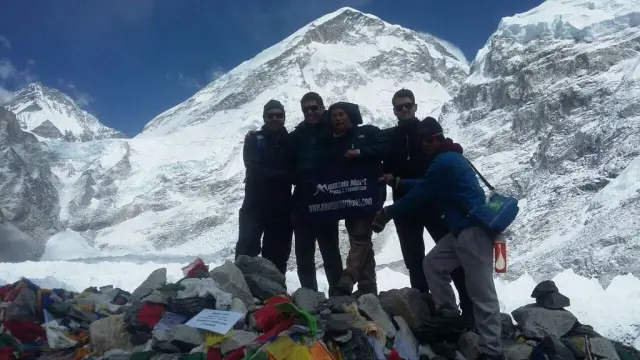
Start your trek in early
First of all, you need to start your trek early in the morning is the best idea because the days are short in the march. It also helps to reach the destination before the evening. Trekking almost 6 to 8 hours is not an easy task. You need a regular break to reach your destination. That’s why you need to start your trek in the early morning is necessary.
Well prepared in advance
Before the beginning of any trek, preparation is most important. The weather in the Everest region is cold in the morning and night. So you can wear a layer of the cloths so that you can add or remove your clothes based on the weather condition.
Regular acclimatization and hydration
Acclimatization is a must essential needs in the high altitude trek of the Everest Base Camp . The trekkers also need to drink water to hydrate regularly to cope with altitude sickness. The process of acclimatization slowly increases the level of oxygen in your body. It also helps you to adapt to high altitude conditions faster. Hydrating regularly maintains your body temperature as well as the oxygen level in your body. This helps you to get more advantages in your trek.
Book in advance
.webp)
In the Everest region , there are primarily Tibetian Buddhists in culture as well as in religion. In March there are various festivals that are come from Hindu traditions, so are not widely celebrated in the mountains. However, if you plan to travel to Nepal in the month of March, you can experience one of the following festivals in Kathmandu before or after your trek. Nepali festivals follow the lunar calendar, they are celebrated using tithi, not in the actual date, so some festivals that fall in March in one year may be in April or February the next. The festivals that usually fall in March are:
- Holi: This is the festival of color. In this festival water and color, the powder is thrown between the people or group in celebration.
- Maha Shiva Ratri: This is one of the greatest festivals of Hindu. In this festival, people worship god Shiva. This festival people are fasting the whole day and celebrated at night. On this day, thousands of sadhus (Hindu holy men) are gathered to worship Lord Shiva at Pashupatinath Temple (which is one of the UNESCO world heritage sites ) Kathmandu Nepal.
- Ghode Jatra: This is the festival only celebrated at Kathmandu Valley. This is the festival of a horse where the Nepal Army performs horse races at the Tundikhel.
Other popular treks in the Everest Region are:
- Classical Everest base Camp trek- 12 days
- Traditional Everest Base Camp trek- 14 days
- Comfort Everest Base Camp Trek-16 days
- Gokyo Lake Trek- 14 days
March is the month of the spring season, in this month the days are warm and clear and this is the favorable season for trekking. So the packing list must include the right gears, items, and gadgets according to the month. Please follow the link to know Everest Base Camp Packing List for March .
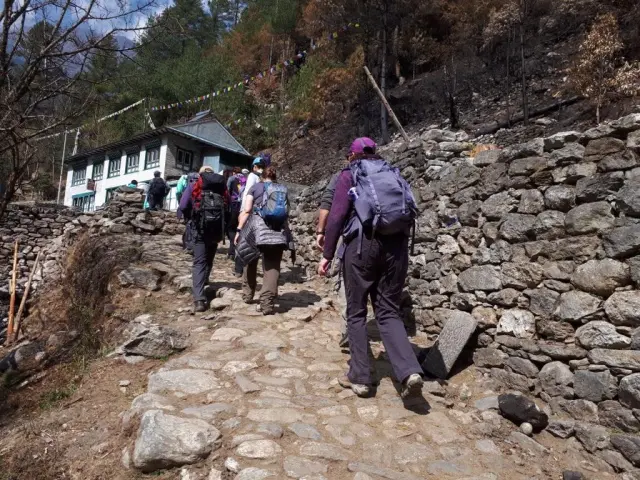
The flight is normally scheduled before 12 pm. Sometimes the flight is delayed due to frequent change of the climate of Lukla. But don’t worry flight is scheduled after the climate is favorable for the flight or is scheduled for the next day. In the Everest base camp trek , the average walking period for trekkers is 5 to 7 hrs per day. But if you are uncomfortable with this situation you can choose Luxury Everest Base Camp Trek with Helicopter Return or Everest Base Camp Luxury Trek . Everest base camp trekking is the high altitude trek (5364 m high). So there is the risk of high altitude sickness. If you have travel insurance, then you don’t need to worry about, there is the facility to chartered the helicopter for rescue in case of emergency.
Everest base camp trek in March is once in a lifetime opportunity for the trekkers like you. Perfect weather, clear blue skies with the wildflower, and greenery provide a pleasant trekking experience. The snow-capped mountains are one of the major attractions of the trek. The bustling, vibrant atmosphere of the tea houses, lodges along the trail will enthrall you. All in all, the exciting Everest base camp trek in March (EBC trek in march) is an excellent adventure for all travel enthusiasts who love to get lost in the tranquility of nature. Please contact us for any queries. Do you like this blog? Please feel free to provide your suggestion.
Other Categories
- Travel Information
Recent Posts
- Manaslu Circuit vs Annapurna Circuit Trek - Which is Best?
- Tips For Annapurna Trekking Packages
- Everest Base Camp Trek vs. Annapurna Base Camp Trek: A Comprehensive Comparison
- Luxury Lodge vs Normal Lodge Trek
- Langtang Valley Trekking
- How Much Does the Langtang Valley Trek Cost?
- Know Before Hiking Poon Hill: The Ultimate Poon Hill Trek Guide
- Everest Trekking Package for 2024/2025
- Top 7 Reasons: Why Everest Base Camp Trek is Popular Today?
- Where is Nepal located on the World Map? - Nepal Facts
- Where is Mount Everest Located?
- Where is Location of Mount Everest in the World Map?
- What is the death rate on Everest? [2022/23 Updated]
- What is Everest Base Camp Trek? - Our Top Tips for your EBC Trek 2022/23/24
- Trekking in Nepal in September - Is September a Good time to visit Nepal 2022/23/24?
Recommended - Boutique Hotel in Thamel, Kathmandu
Charming Newari Heritage Hotel in central Kathmandu, with a rooftop restaurant for stunning valley views.

We are associated with
Acceptable payments.
Find & Follow Us on
© 2011 - 2024 All rights reserved. Mountain Mart Treks & Expedition. Developed By: Xenatech Nepal .
Notice. This site uses cookies to optimize your user experience. By using this site, you are consenting to our use of these cookies. Check out our Privacy Policy and our Cookies Policy.

- Annapurna Base Camp Trek in March
- Annapurna Trek Guide
- Aug 29, 2019
- Index Adventure
Table of Contents
Annapurna Base Camp trek holds secret treasures for mountain lovers. March is the best time for trekking and to enjoy the magnetic mountain peaks. Starting in March, the ABC trekking trail will be crowded with a lot of trekkers.
March, the month of Rhododendron, is the time of spring season in the Annapurna region . While trekking in March, you will collect the fondest memories in a pleasant and moderate climate.
March is a shoulder month which brings an aromatic spring after the snowy winter.
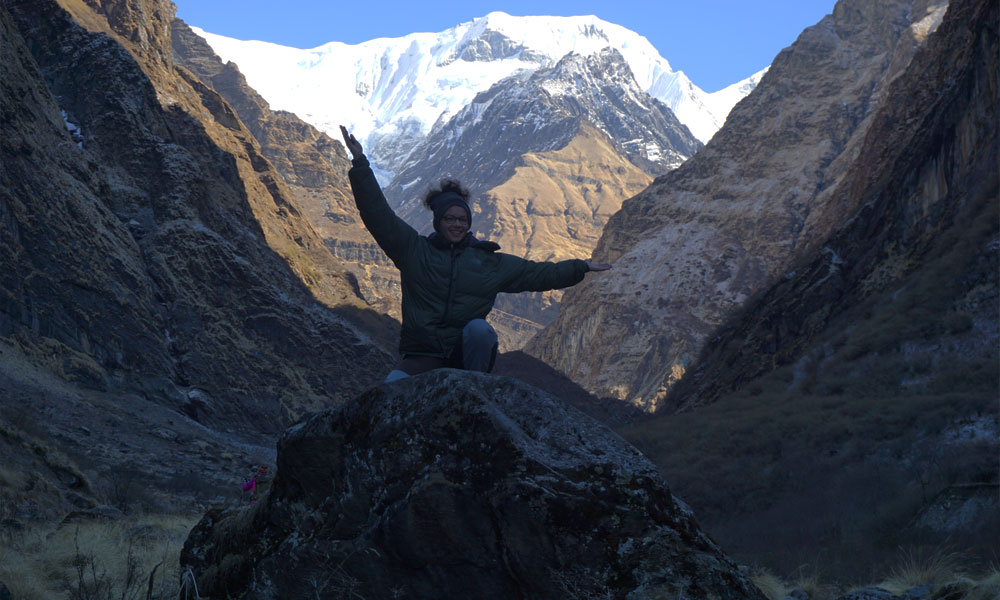
The trail will bloom with red and white Rhododendrons and many wildflowers found in this region. The trek summarizes the beauty of green terraced fields, quaint Gurung villages and a wide variety of flora and fauna.
The outstanding view of Mt. Annapurna (8091m), the 10th highest mountain in the world from the base camp (4130m) is precious. Moreover, the panoramic views of Mt. Machhapuchhre (6997m), Glacier Dome, Gangapurna (7454m), the unclimbed Fang (7647m), etc are awe-inspiring.
Highlights of Annapurna Base Camp Trek in March
- Distinct mountain views that leave you spellbound
- Enchanting sunrise view from Poon Hill
- A close panorama of the world’s highest mountains including Dhaulagiri and Annapurna
- Overnight at the Annapurna Base Camp
- Spectacular views of the glacier from Annapurna Base Camp
- A warm bath in hot spring at Jhinu Danda
- The silvery peaks glowing with the golden and orange tints during sunrise
- The Gurung Museum in Ghandruk
- Exotic floral and faunal diversity
- A peek into rich Nepali tradition and culture
- Trekking inside the Rhododendron forests of the Annapurna Conservation Area.
- Amazing forests, that come alive.
- Rhododendron forests in full bloom.
- Aroma of different flowers along the trekking trail will keep you enchanted.
Are you planning your Annapurna Base Camp Trek? Don't hesitate to contact us . Tell us your requirements, we can help you to make your trip memorable.
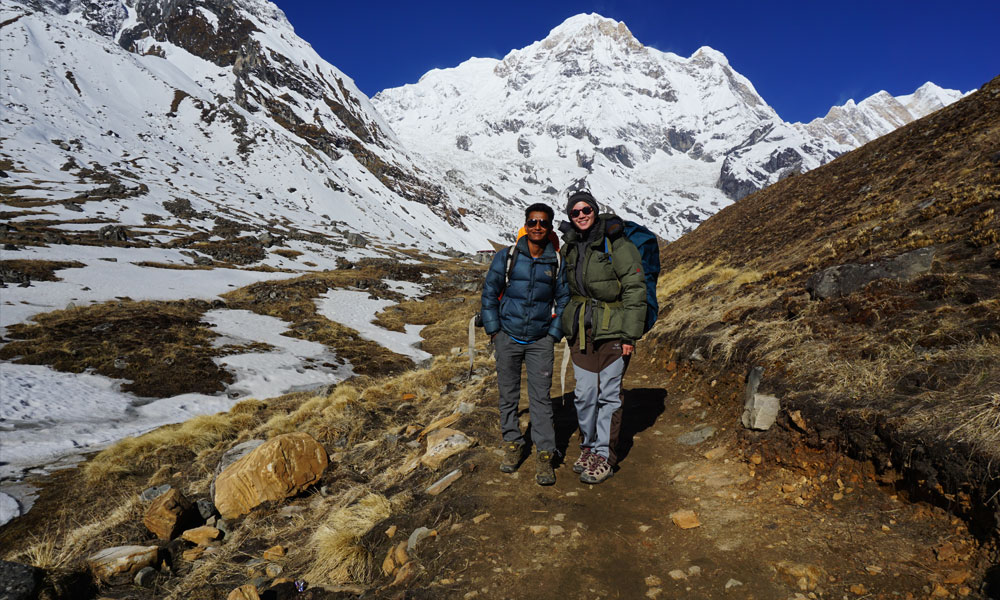
Annapurna Base Camp Temperature and Weather in March
March is the springtime in Nepal. The weather during March is perfect for an ideal trekking in the Annapurna region.
The warm weather in spring, the green forests, blossoms of various wildflowers including Rhododendron are truly fascinating. The bright red hills of Rhododendrons bring more trekkers in this month. The trekking trail is clean and dry with no snow. Watch out for the avalanche though.
March is a beautiful time for crystal clear views. The average daytime temperature at lower altitudes is around 10 degrees Celsius during sunshine. The higher you go, the colder it gets. As you ascend over the height of 4000m is you experience the freezing cold in the evenings and mornings. The daily maximum and minimum temperatures are around -4 to -8degree Celsius. While nights are usually just on freezing temperature of about -10degree Celsius.
How Difficult is Annapurna Base Camp Trek in March?
ABC trek is a moderate trek. It doesn’t need an advanced physical fitness level. Nor, it demands any previous trekking experiences. Anyone can do this trek and enjoy the pleasing time with nature.
March brings a dry, warm and stable weather in the Anapurna region. Adding colors of wildflowers to the beautiful hills, it adds joy to the trek. So, there is no risk of difficulties while trekking in ABC during March.
If you choose the Ghorepani trail to trek to ABC, your body gets adapted and acclimatized with high altitude along the trail.
Trekkers with previous trekking experiences can trek it in short period of time and more easily. During the ABC trek, will reach hit the highest elevation of 4130 meters from sea level. Some may feel symptoms of Altitude sickness, but if you walk slowly, maintain hydration, and take proper rest you can walk easily to the base of the giant peaks.
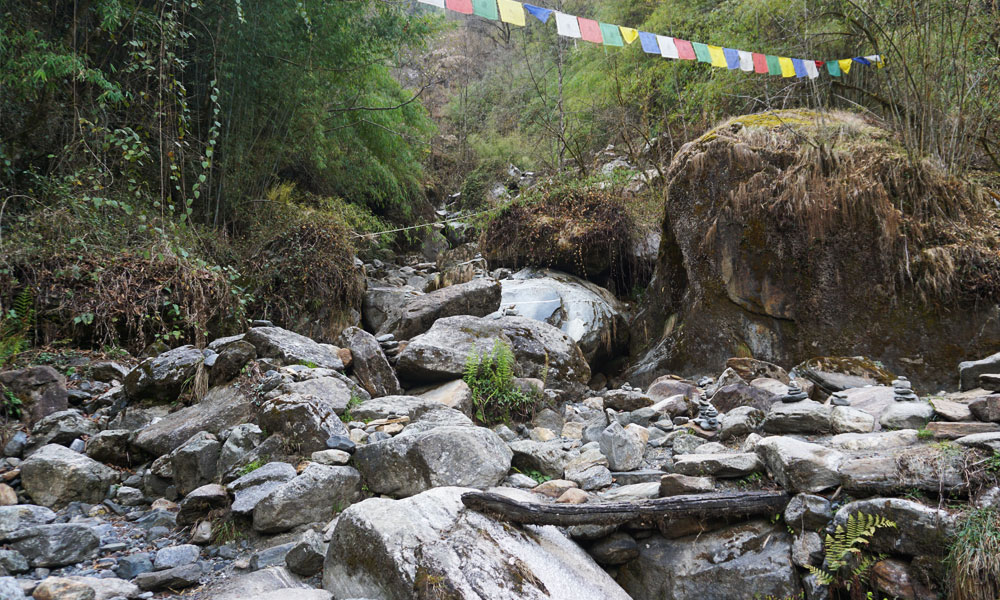
Meals and Accommodation during ABC Trek in March
Accommodations
March indicates the beginning of spring in the Annapurna region. It is the most trekked month after Autumn. The perfect weather and alluring natural beauty attract lots of trekkers during March.
In March, single rooms are easily available in Kathmandu, Pokhara and the trekking regions at the lower elevation. However, you will have fewer options for accommodation at higher elevations.
$2 is an average price per day for a stay in normal tea houses or lodges. You can take a small private room with twin beds. If you are large in number, you can book a dorm room with 4-6 beds.
The rooms are small but tidy. If you expect luxury accommodation, you can stay in the fancier hotels. They cost much more than general teahouses.
During ABC trek, locals expect you to eat where you stay. Teahouses make most of the money on food rather than on lodging.
The tea-houses where you stay serves a breakfast and dinner. They will serve you anything from the lodge menu (Menu has lesser options at higher elevation). Enjoy your lunch at some place on the way to the next destination.
You will have different food options to choose from. You can enjoy typical Nepalese food as well the more common international dishes. In common, you can have eggs, chapatti (a bread prepared in a local way), cereals with milk, and sandwiches for breakfast.
You can have potatoes, noodles, chowmein, momo, macaroni, pudding, Dal Bhat Tarkari, etc for lunch and dinner. Dal Bhat, a Nepalese dish, is the cheapest and most filling option in the food menu.
For drinks, you can have tea, coffee, plain warm water, or flavored hot drinks.
They do sell local as well as branded alcohols. If you drink, better drink while you are returning. (Alcohol and caffeine will increase the risk of AMS.)
On average, $25 per day will cover three meals. With this amount, you may choose anything to eat. It also includes many cups of hot beverage.
Trekking Permits and Costs for Annapurna Base Camp
To trek to Annapurna Base Camp, you will require two permits:
- Annapurna Conservation Area Project (ACAP) permit
Nrs.200 ( US $2 ), for SAARC countries
Nrs.3000 (US $30), for other nationals
- Trekkers’ Information Management System (TIMS) card
NRS. 2000 ( US $20)
You should also carry
- Copy of passport
- travel insurance
- Credit card ( in case of evacuation)
Trekking Gears Required During Annapurna Base Camp Trek in March
It is what you carry inside your trekking that determines your trekking experience. Whichever season you are trekking you must pack wisely. Instead of increasing the weight you must pack wisely.
Not having proper gears can be troublesome during long treks.
Listed below are the equipment that you should bring to Annapurna Base Camp trekking.
- Lightweight trekking boots . The trekking boots offer more safety during long treks. But, your shoes must be well fitting, light and comfortable.
- Two or more pairs of trekking socks . Trekking socks are better. But an ordinary pair of socks is also usable.
- Windproof jacket and trousers Keep in mind that you will see both the cold and warm temperature at ABC. So do not forget to pack down jackets and warm trousers as well.
- A set of thermals and trekking T-shirts.
- A lightweight sleeping bag.
- A trekking pole. Though easy, there are many ups and downs in this trek. A trekking pole can assist you throughout the hikes. (You can find yourself a sturdy stick in route)
- Sunglasses, sunscreen cream, and lotion
- A First Aid Kit including Oral Rehydration Salts (ORS)
- Iodine tablets, Airtight water bottle, long-sleeved shirt, lip balm.
- Toiletries– Toilet paper, hand sanitizer, water purifiers, moisturizer, toothpaste, and toothbrush.
- A map of Annapurna Base Camp
- Snacks and entertainment like books, cards, an iPad etc.
Some Extra Tips to Annapurna Base Camp Trek In March
- Weather changes frequently in high altitude areas. Bad weather can hit the Annapurna region even in March. So, be prepared and carry the necessary equipment for your trek.
- Spring is a busy season at Annapurna region. The trekking trails are more populated. Teahouses or lodges in the route may be already occupied. You may also have to stand in queues for meals. So, a book for accommodations earlier.
- You must start your trek right after an early morning breakfast. This helps you to reach your destination earlier. So, there are more chances to get the best rooms for overnight stays.
- The cold mornings and nights are harder to cope with. So, pack some warm clothes and other accessories during the trek.
- Do not worry about the heavy loads of your backpacks. You can hire a local porter to carry your loads.
- Maintain your own slow and steady pace during the trek. Do not rush. It isn’t a one day hike. So take proper care of your body.
- Hydrate yourself properly. Your body dehydrates faster as you ascend the higher altitudes. Drink safe and non-polluted drinking water. You can also carry fruit juices or some energy drinks with you.
- Take some extra snacks with you. They include energy bars, chocolates, and other instant energy providing foods.
- In cases you see any symptoms of Altitude Sickness , do not hesitate to notify your guide or a partner. Walk down to lower altitude and rest till you are fine.
- Carry enough cash with you during the trek. There are no ATMs in the ABC route.
- Public display of affection is not welcomed and wearing revealing dresses will earn you unwanted criticism.
- It is rude to click people without their will. Ask them first, if you want to click their pictures.

Final Say ,
You can never say no when you get an invitation of heavenly views of the majestic Himalayas in Nepal. March, is a perfect time for the Annapurna Base Camp Trek. If you can spare your time to trek in March, you should surely go for it.
Do you need additional information on this trek? Do you want to join this trip with us? If yes, contact us . We will be happy to customize our trip as per your convenience.
Send an Inquiry
Recent post.
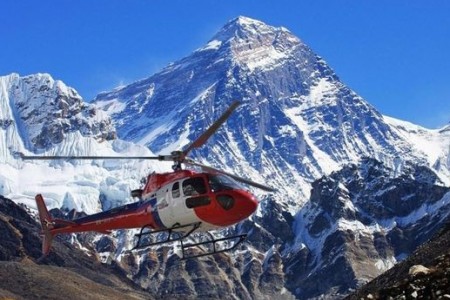
Why to choose EBC helicopter tour?

Safety tips for helicopter tour
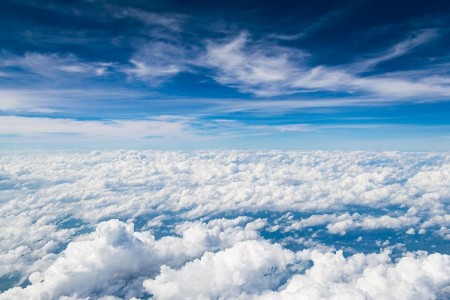
Flying to the top of the mount Everest
Related posts.
- Annapurna Circuit Trek Altitude Sickness Guide
- Annapurna Circuit Trek Weather and Temperature
- How long is the Annapurna Circuit Trek
- How to prepare for Annapurna Circuit Trek
- Annapurna Circuit Trek 15 Days
- Ghorepani Poon Hill Trek Weather
- Poon Hill Trek Cost
- Annapurna Helicopter Tour Cost - A Complete Guide
- Adventure Activities
- Bhutan Tour Guide
- Everest Trek Guide
- Kanchenjunga Trek Guide
- Langtang Guide
- Manaslu Trek Guide
- Mardi Himal Trek
- Mustang Guide
- Peak Climbing
- Uncategorized
- Visit Nepal Year 2020
Index Adventure Pvt. Ltd.
.webp)
Everest Base Camp Trek
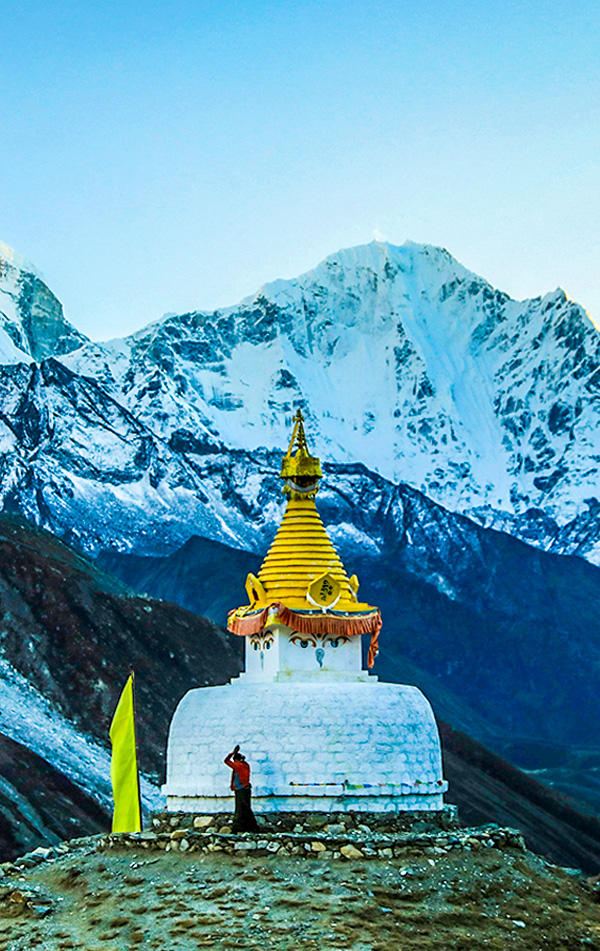
Kathmandu |
Kathmandu | Nepal
Max Altitude
Trekking Km
Help & Support
67000 /person $ /person.
- October-2024
- November-2024
- +5% GST (Goods and Services Tax)
- USD 1500 +5% GST for Non-Indians
- Services Kathmandu to Kathmandu
- Lukla flight, Food & Stay in Kathmandu included
Offload 5300
Backpack offload is optional
Choose add-ons during booking. If missed, log in and add them later.
Book off-load at least 10 days before the trek.
For offline bookings at the base camp, a convenience fee of Rs. 6000 applies.
Cancellations made before the trip date will receive a full refund.
For more information. Please complete this form.
Help & Support
Trek Name: Everest Base Camp Trek
Adventure Type: Trekking
Base Camp: Kathmandu
Season: Summer | Autumn |
Month: March | April | May | September | October | November |
Country: Nepal
Altitude: 18200 Ft.
Grade: Difficult
Rail Head: Kathmandu is not connected to any Railways
Stay: Hotel and teahouse
Food: Meals while on trek & at Hotel/Guesthouse (Veg & Eggs)
Location: Kathmandu
Distance: 108 Km.
Trail Type: One way trail | Camping in various locations, starting and ending at the different point.
AirPort: Kathmandu (Tribhuvan International Airport)
Why Everest Base Camp Is A Must-Do Trek
When it comes to trekking in the Himalayas, Mt. Everest is the most celebrated peak and not just in our country but all across the globe. For avid trekkers and mountaineers, getting up close to the highest mountain peak in the world is a once-in-a-lifetime experience. This classic trek takes place in the Bagmati Zone of Nepal and allows you to experience the immense beauty of the surroundings. Along your trek, you will get to witness 4 of the 6 highest mountain peaks in the world — Cho Oyu (8,201 m), Mt. Makalu (8,470 m), Mt. Lhotse (8,516 m), and Mt. Everest (8,848 m).
Everest Base Camp is a teahouse trek, which means you will stay at some of the highest villages in the world and get a close look at their cultures and traditions, and life in the remote corners of the Himalayas. Staying at the Sherpa villages you will get to learn a lot about the mountain lifestyle and how inextricably the people are connected to the mountains. There are many notable junctures throughout the trek and Kala Patthar is one such point. Standing at an altitude of 5,500 m it offers an astonishing view of Mt. Everest . EBC trek presents a wonderful opportunity to experience the grandeur of the Himalayas, the imposing challenge and thrill of the climb, and the charming culture of Nepal.
Trekking in Nepal is all about trekking amidst the biggest mountain ranges and on this trek, you will see mountains surrounding you. All along the way, you can feel the sense of legacy left behind by the greatest mountaineers. Crossing the route beyond Namche Bazaar, you will come across, Tenzing Norgay Stupa, a tribute to the great mountaineer, who was the first to scale Mt. Everest along with fellow mountaineer Edmund Hillary. Also, just near Dughla on Everest highway, there are memorials for distinguished mountaineers who dedicated their lives on the slopes.
Reaching Everest Base Camp means trekking through the traditional Sherpa villages, with warm and friendly villagers, hidden Gompas, picturesque mountain views, and exceptional natural beauty. Those who take part in such a trek will never forget the amazing experience.
About The Trek
Your journey will start at Kathmandu from where you will take a short flight to Lukla. The iconic trek starts at Lukla in the southern part and the trail weaves towards Namche Bazaar in the north. We will stay a day here, acclimatizing to the higher altitudes. It then diverges in the northeast direction towards Pheriche and Dingboche. Once we reach Dingboche, we will spend a day at Dingboche as a rest day. From Dingboche, the route continues to Lobuche. Everest Base Camp is a little further east from here and the Kala Patthar viewpoint can be seen towards the west.
There are other variations to the trek route as well, where the trek bifurcates towards Gyoko Ri early on at Namche Bazaar. The route then follows the left side to arrive at the Base Camp. Sometimes people also prefer trekking from Jiri village instead of Lukla, Jiri is a short bus ride away from Kathmandu. However, trekking from Jiri adds a couple of days to the trek as Jiri is considerably further away from Lukla. The EBC trek follows a gradual ascent up to the base camp, following which there is a steep descent. The entire journey lasts for 13 days and in between, we also have acclimatization days as well.
What Can You Expect At The Trek
It is a difficult grade trek. Trekking to the Everest Base Camp requires exceptionally high physical fitness and while the trek is not dangerous, you need to prepare well for it. A variety of factors add to the difficulty of the trek like the terrain, the duration of the trek, the distance covered every day, and the number of days spent at high altitude and a difficult exit in case of emergencies. While all trek is not especially tricky but it is surely an endurance test.
It is a high altitude trek and as such chances of AMS are quite high but with adequate hydration, proper rest, and a well-planned itinerary taking into consideration the acclimatization criteria will help counter such issues. Our trek leaders are mountaineering-certified individuals with a keen understanding of AMS and other high-altitude issues. They can detect the signs of AMS early on and adopt necessary measures for the prevention of the same. Our Trek Leaders are also all Wilderness First Aid Responders, who are diligent in handling emergencies.
The trek from Lukla to Everest Base Camp is 50 km and it takes 13 days to complete the trek starting from Kathmandu. To mitigate the risks of being at a higher altitude for such a long time, we have incorporated acclimatization and rest days in the itinerary. Mt. Everest can be spotted multiple times on the trek even in the initial part of the trial.
In cold conditions, batteries drain pretty quickly be it phones, cameras, or Kindles. Make sure to bring spare batteries with you. Some teahouses allow you to charge your phone and other electronics but they will charge you for it.
Be prepared for extreme weather conditions as the weather at high altitudes is unpredictable. Layer properly to regulate your body temperature and stay comfortable while trekking. When its sunny, the weather can get quite warm and you may even have to discard a couple of layers in the first few days of trekking, however, the temperature at night drops pretty quickly. Make sure to drink a lot of water to stay hydrated and avoid altitude sickness. Also, remember that sunburn happens much quicker at higher altitudes so always wear sunscreen and keep your sunglasses ready.
Accommodations at Everest Base Camp will be in teahouses in Sherpa villages or mountain lodges. Also, keep enough cash with you as there are no ATMs in Lukla. Also, if you want to do some last-minute shopping for trekking gear and equipment, Kathmandu is a good place to do so.
- Who can Participate
- Important Links
- How to Reach
- Trek Essential
Who Can Participate
Age; 15 years.
Experience of any high altitude trek, at least 1 treks of 4,000m/13,100ft.
The climber must be fit and have sufficient stamina to cover 5 km of distance in 30 minutes without stress.
The climber should be able to carry a 12-16 kg backpack.
Pulse rate at rest must be in between (60 to 90 beats per minute)
Blood Pressure Reading must be in between (DIASTOLIC 70 – 90, SYSTOLIC 100 - 140 mm Hg)
Respiratory rate at rest must be in between (12 to 20 breaths per minute)
Should not have Liver and kidney issues
Should not have Diabetes Mellitus, Bronchial Asthma, Heart problems, Hypertension etc
No pacemaker implant
People with the Sinus issues, Epilepsy please contact to trek coordinator before booking the trek
If your BMI is not normal, Please contact our Trek coordinator before Trek booking.
Medical & Disclaimer Form (Mandatory Documents) Click here to download Medical & Disclaimer Form
- Government Employees can avail the benefit of Special Casual Leave (SCL) when you join us for a trekking expedition. As per the rules of the Pay Commission, Special Casual Leave can be availed for up to 30 days in a calendar year for trekking/mountaineering expeditions through a registered organization. Trek The Himalayas is a registered adventure tour operator by Indian Mountaineering Foundation (IMF) and Ministry Of Tourism (MOT)
- Trekkers have to apply for leave at least 20 days before trek departure date,
- This service is exclusive to Indian government employees and is applicable only for treks within India.
- Do mail at info@trekthehimalayas to apply and mention your booked trek date and trek name.
Junior trekkers (below 15 years) should have a company of parents/guardians.
Trekkers between 15 to 18 years can come solo with the disclaimer form signed by parent/guardian.
- Medical & Disclaimer Form (Mandatory Documents) Click here to download Medical & Disclaimer Form
Exercise For Difficult
Fitness Regime For:
Calculate Your Bmi
Your BMI value is
Congratulations, your body is in good conditions!
Arrive At Kathmandu
- Altitude: 1,400 m/ 4.600 ft.
- Spend the day exploring Kathmandu.
- A short briefing session in the evening.
- Stay: in hotel (included in cost).
Welcome to trekkers’ paradise, Nepal. Nepal is characterized by beautiful Himalayan summits, rich natural biodiversity, and beautiful culture and history. Once you arrive at Kathmandu airport, you can take a taxi to the booked hotel in Kathmandu. There are loads of taxis available at the airport and you can easily find one to drop you off at the hotel. Once you check-in to the hotel, you can freshen up, and in the evening, you will receive a briefing session where you will learn about the trek and your schedule for the upcoming days. If you have any questions about the trek, then you can clear them at the time of the briefing session. Post the briefing session, you can explore Kathmandu and do some last-minute gear and equipment shopping if you want.
Note that, from April 2019 most flights have been diverted to Ramechhap airport due to construction and crowding at Kathmandu Airport. Ramechhap is a small Airport Ramecchap in Manthali and 4 hrs drive away from Kathmandu. In this case, your flight will be booked for the next day. So take an early night flight to Kathmandu and get ready to leave Kathmandu City by 1 o’clock so that you can take an early morning flight from Ramechhap airport.
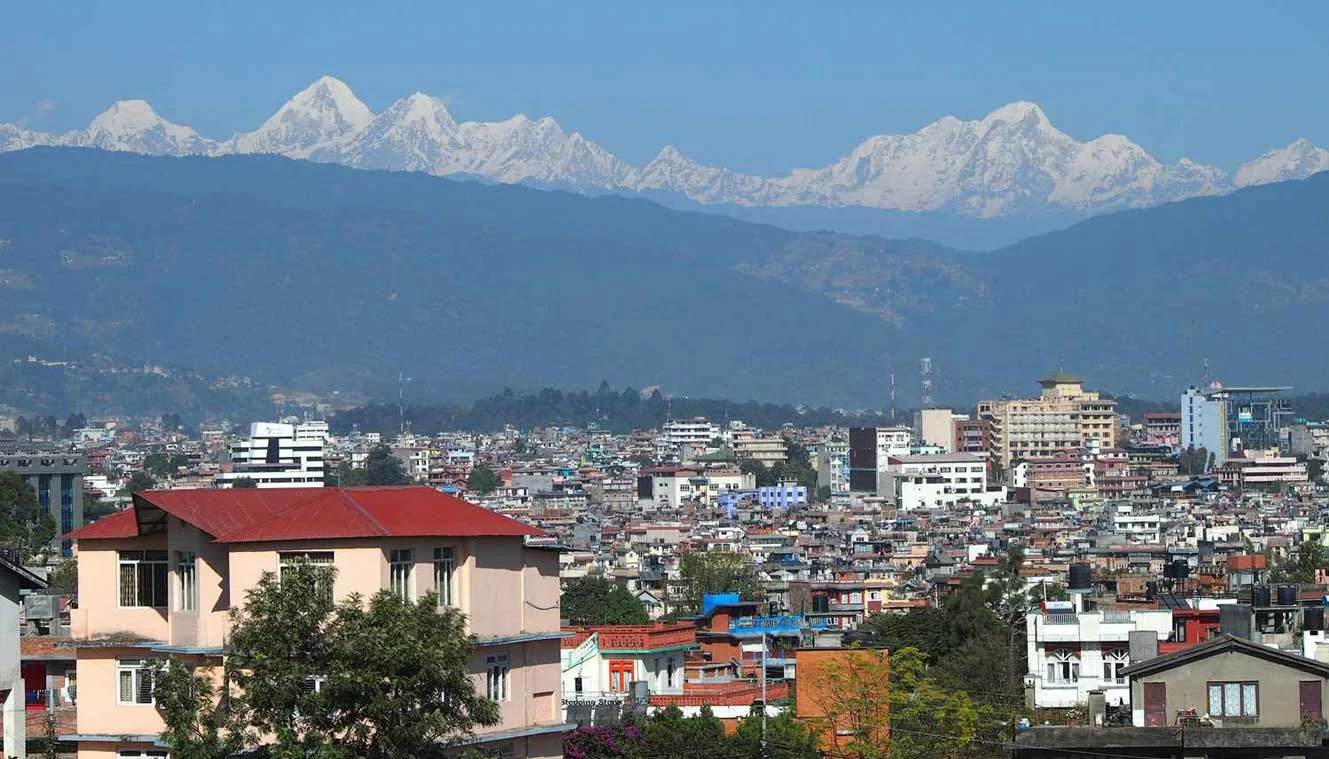
Fly to Lukla, Trek To Phakding | Enjoy A Scenic Flight Journey
- Altitude: Lukla - 2,850 m/ 9,350 ft; Phakding - 2,600 m/ 8,500 ft.
- Altitude Gain: 1200 m/ 3,900 ft.
- Early morning flight to Lukla (30 minutes).
- Trek to Phakding: 9 km | Duration: 4 to 5 hrs.
- Easy and gradual descent.
- Cheplung village lies en route from where you can see Mt. Khumbila.
- You can buy or refill your water bottles from teahouses on the way.
Get ready for a beautiful flight from kathmandu or ramechap to Lukla. Its a short flight of about 35 minutes that will take you over a panoramic landscape. On these flights, the planes are quite small but the journey is quite scenic. Our representatives will meet you at Lukla airport and this is where your trek towards Everest Base Camp starts.
After arriving at Lukla, we will start our trek towards Phakding after some refreshments. The trail is 9 km long and passes through Nepali mountain villages, green mountains, suspension bridges, and forests to Phakding. It takes about 4 to 5 hrs to complete the trek. From Lukla, the trek begins with a gradual ascent, with a few ups and downs along the way. Along the route, you will witness amazing views of Kusum-Kanguru as you cross a suspension bridge on your way. After a short climb, you will arrive at Ghat Village and after another one and a half hours of gradual walking, you will arrive at Phkading. En route, you will also spot boulders that are carved with Buddhist Prayers. We will stay overnight in Phakding.
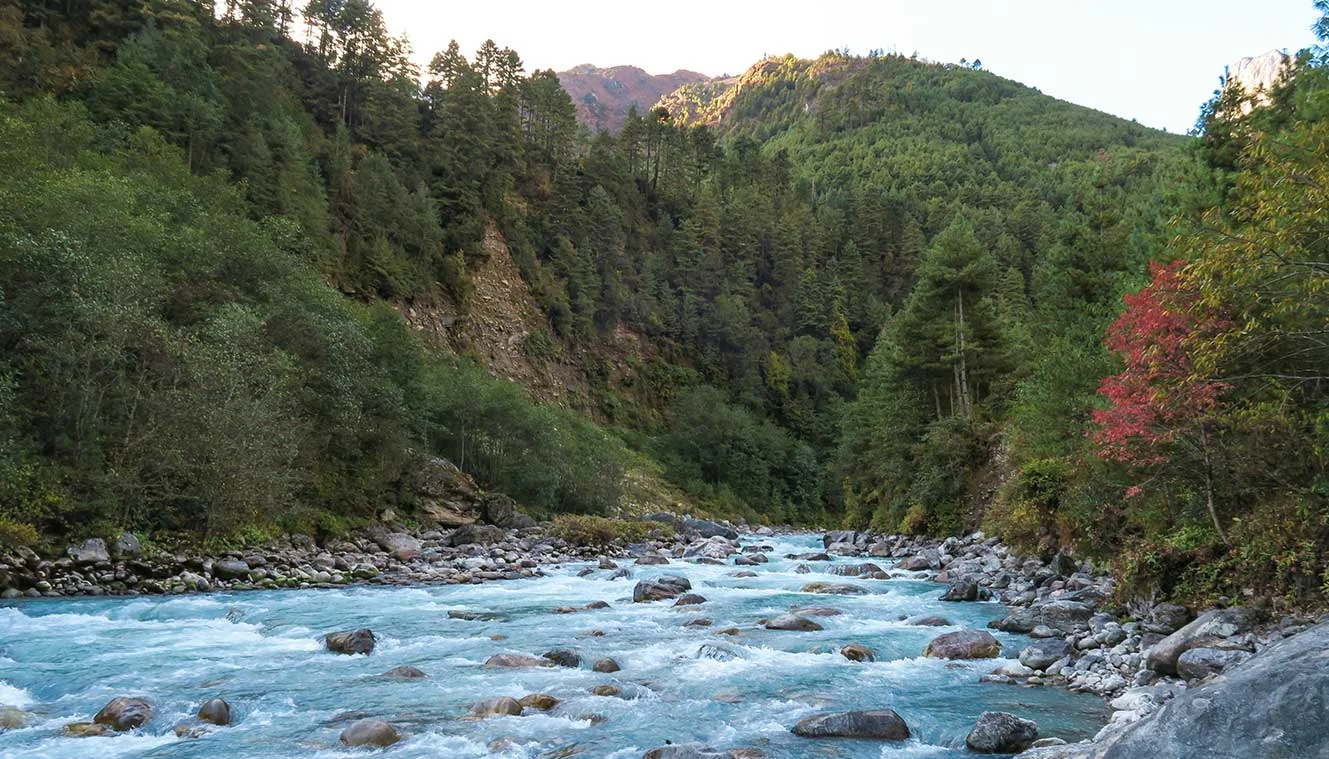
Phakding To Namche Bazaar | A Major Trading Hub In Khumbu
- Altitude: 3,450 m/ 11,300 ft
- Trek: 10 km | Duration: 7 hrs.
- Altitude Gain: 850 m/ 2,800 ft.
- Moderate level of climb and steep climb before Namche Bazaar.
- Namche Bazaar is the capital of the Khumbu region.
- You will get the first views of Mt. Everest today.
- You will spot Kongderei and Thamserku peak.
- Monjo village is the mid-point of the trek.
- A swiss suspension bridge on Dudhkosi River. It is one of the major attractions.
- Dudhkosi River is considered as the lifeline of the Khumbu Region.
- Today you will enter into the Sagarmatha National Park (a UNESCO World Heritage Site).
Post breakfast, we will start our trek towards Namche Bazaar. The route today is surrounded by green mountains and will take you through suspension bridges over the Dudh Koshi and Bhote Koshi rivers. Before entering the Sagarmatha National Park, you will have to obtain permits and then the trail follows a steep ascent before arriving at Namche Bazaar. Namche Bazaar is an important trading hub of the Khumbu region.
We will start our trek early in the morning from Phakding and soon you will cross a suspension bridge over the Dudh Koshi River, the walk from here is easy and pleasant with short uphill and downhill climbs. You will cross another suspension bridge over the Bhote-Koshi River. It is a busy area and you may notice a multitude of trekkers and porters here. After a 20 minute climb from this area, you will arrive at Monjo. Monjo is a pit stop for many trekkers and many people also camp here. At Monjo, you will see interesting watermills that are used to grind barley, a staple diet of the Sherpas. Monjo is situated right below the majestic Thermasarkhu peak (6,608 m) and quite close to this village is the entrance to the Sagarmatha National Park.
Treading along the Dudh Koshi River, you will arrive at the Sagarmatha National Park. At this point, your trekking permit will be checked and the officials will keep a record of all the trekkers going ahead. Sagarmatha is a UNESCO World Heritage Site that showcases stunning mountain views and rich biodiversity. Here, you may spot rare Himalayan species like snow leopard and the lesser panda. The presence of Sherpa settlements with their unique culture makes the trek even more interesting. A gradual walk from Sagarmatha National Park will lead you to Namche Bazaar. From Namche Bazaar, you will catch the first glimpses of Mt. Everest. Namche Bazaar is a historic trading center of the Khumbu area and you can stock up on essentials from this point. At night we will stay here at a guesthouse.
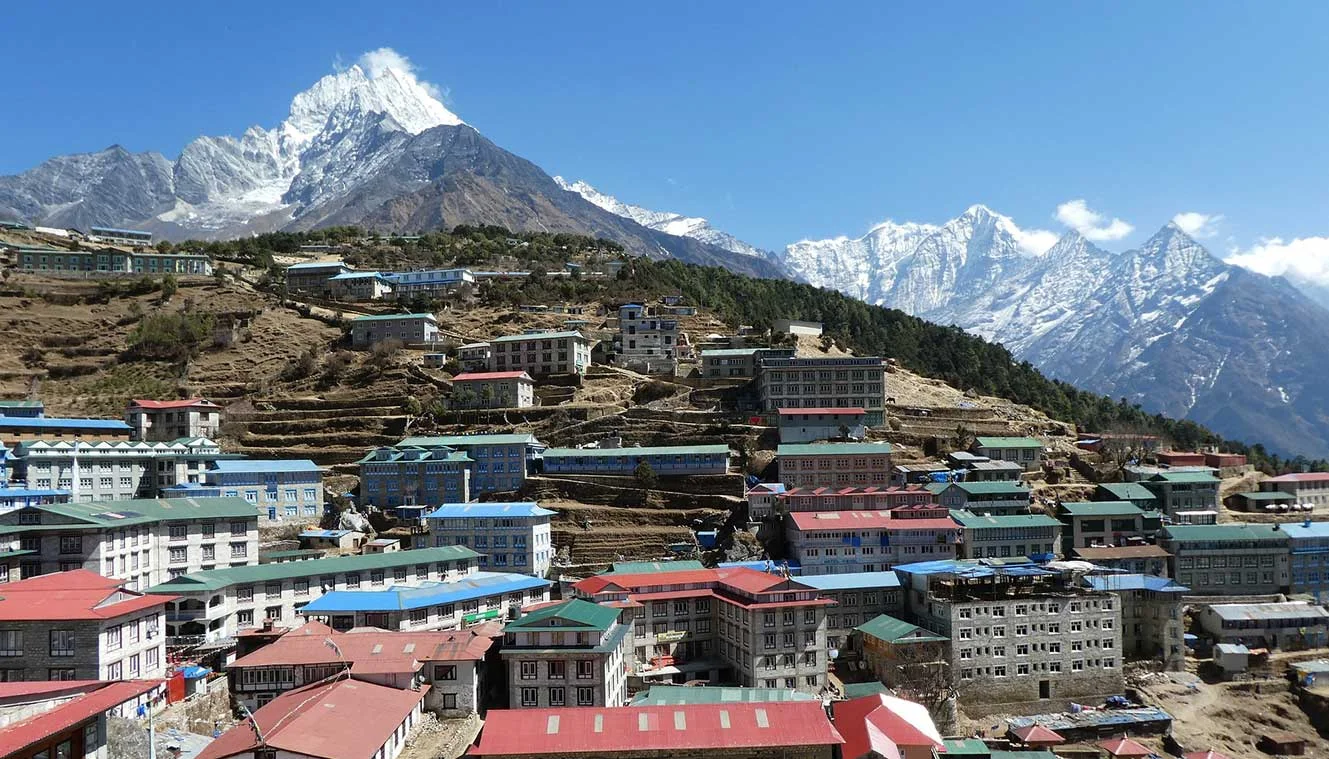
Acclimatization Day | Explore Namche Bazaar
Wake up to the beautiful views of the highest Himalayan peaks and enjoy a delicious breakfast. Today we will stay in Namche Bazaar allowing our bodies to acclimatize to high altitudes. You can spend the day exploring the surroundings and enjoy the culture and hospitality of Nepal. Namche Bazaar is a commercial hub so you can do any last-minute trek shopping from here. The market has a vibrant atmosphere and there are a couple of restaurants and coffee shops as well.
You can do a short hike to Sagarmatha National Park headquarters. From here, you can get a good view of Ama Dablam, Mt. Everest, and other Khumbu peaks. Sherpa Cultural Museum is close by and lies just above Namche Bazaar. The museum gives you a fair amount of details about the history of the Himalayas, the geographic and cultural aspects, mountaineering history, and information about the various flora and fauna in the region. You will see many pictures of Tenzing Norgay and Edmund Hillary from their climb and maps detailing their trails as well. In the evening, take acclimatization walks around the market, preparing your body for higher altitudes. Soak in the Nepalese Buddhist culture, food, and traditions. Namche Bazaar gained popularity during the time when Tibetan salt was traded for grains from Nepal\\s lowlands. Nowadays, you can see a roaring trade of rugs, clothing, dried meat, and salt in the village center. There are many shops that also offer locally made handicraft items, you can buy them as souvenirs or gifts for your friends and families. You will stay the night at a guesthouse in Namche Bazaar.
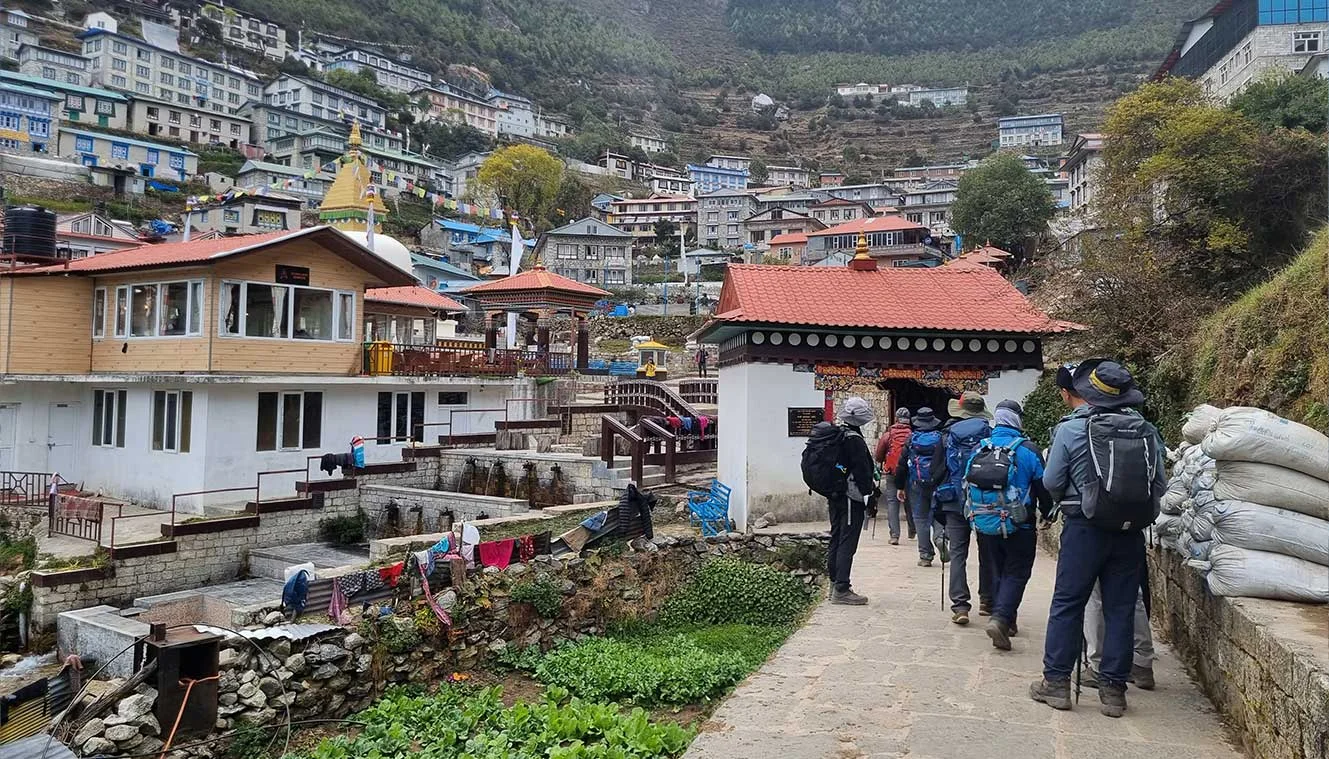
Namche Bazaar To Tengboche | Visit The Largest Buddhist Monastery Of Khumbu
- Altitude: 3,850 m/ 12,650 ft.
- Altitude Gain: 400 m/ 1,350 ft.
- Trek Distance: 8 km | Duration: 5 to 6 hrs.
- Mixed ascent till Phunki Tenga.
- Steep ascent after Phunki Tenga to Tengboche.
- Tengboche has the biggest monastery in the area.
- You can attend a prayer ceremony held by the monks to invoke protection on your expedition.
- Cross another high bridge at the village of Phunki Tenga.
Start your day with a delicious breakfast and get ready for your trek to Tengboche from Namche Bazaar. It’s an 8 km long trail and is a fairly easy trek accompanied by the views of the majestic Himalayas. You will also spot Himalayan Wildlife on the way as well.
Tengboche is a small alpine valley that is situated at an altitude of 3860 m and the trek starts with an easy walk. The trek from Namche Bazaar to Tengboche is extremely beautiful and along your trek, you will get a bird’s eye view of Dudh Koshi River down below and the epic mountain views as Thamserku (6,608 m), Kantega (6,782 m), Ama Dablam (6,812 m), Lhotse (8,516 m) and Everest (8,849 m) comes into view.
A 20-minute walk from Namche Bazaar will take you to the top of Namche Bazaar. From here the trek descends to Khumjung, a Sherpa village and then climbs up the sides of the mountains through some stairs and then diverges from the Everest Highway at Sanasa. You will be able to catch glimpses of Lhotse, Nuptse, and Mt. Everest from here. This is probably the best view of Mt. Everest you will get until you reach Gorakshep when climbing to Kala Patthar. Two hours of pleasant walking will bring you to Sanasa. Up to Sanasa, it is a walk-through forest covers of Oak and Rhododendrons. It is a great location for bird watching and you may spot the Danphe Pheasant, the national bird of Nepal. Musk-deer and Himalayan Tahr, a Himalayan goat that looks like an antelope are commonly spotted in these areas. You will also spot the Tengboche monastery from here which you will reach in the later part of your trek.
Next, following a gradual descent, you will reach the Imajtse River at Phungitenga at an altitude of 3,250 meters. Phunki Tenga is a small Himalayan settlement with teahouses and army posts. The climb down can be a little tougher as the terrain is rocky and uneven. You will reach a suspension bridge over the river and after you make the crossing, you will need to get permits at a checkpoint to proceed further in your trek. From here it is a strenuous climb of about an hour that will take you to a Buddhist monastery just before Tengboche and finally to Tengboche village. This is the last part of today’s trek and you can expect the trail to be rocky with a couple of switchbacks. Don’t push yourself too hard, take it slow and steady as you make your trek uphill.
Tengboche Monastery, locally known as Dawa Choling Gompa is the largest monastery in the Khumbu region. It overlooks the beautiful region and the mountain landscapes around. There are daily prayers that occur around 7:00 am and once around 3:30 pm. You can take part in the prayers if you truly want a cultural experience. It is one of the important cultural aspects of the EBC Trek. Enjoy the serenity at this revered place of worship and at night your stay will be in the guesthouses at Tengboche.
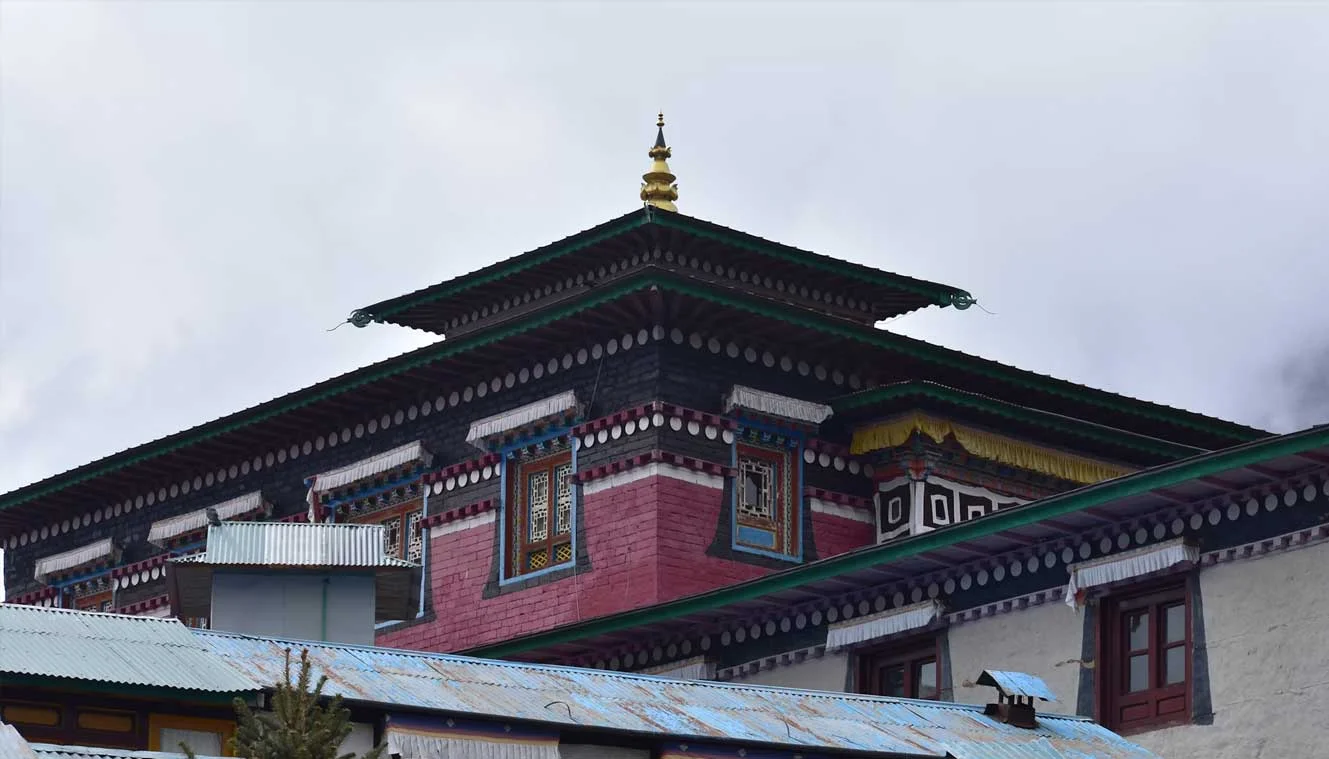
Tengboche To Dingboche | Stunning Views Of Ama Dablam
- Altitude: 4,350 m/ 14,250 ft.
- Altitude Gain: 500 m/ 1,600 ft.
- Trek Distance: 9 km | Duration: 6-7 hrs.
- Gradual descend and little bit of ascent after Lobuche River to Dingboche.
- The trail passes through lush forests of birch, conifer, and Rhododendron trees.
- The route offers amazing views of Ama Dablam standing over you.
- The trail crosses the Imja River to reach Pangboche.
- Continue along the Imja Valley and Lobuche River before ascending to Dingboche.
Today, we will begin our trek towards Dingboche. From Tengboche, cross bridges and rivers accompanied by beautiful mountain views all the way to Dingboche. Stone steps will lead you through forests of Rhododendrons, conifers, and birches, and at the bottom of the forest lies the Deboche village. From here, the trail rises up and enters into the alpine meadows and Dingboche. Dingboche is the only place in the entire Khumbu region where barley is grown. The views of the Himalayas are amazing from Dingboche. Start your trek from Tengboche and walk towards Pangboche Village, you will get to see some beautiful views of Mt. Ama Dablam and from Pangboche we will trek towards Pheriche and to Imja Valley. The beautiful Lobuche River passes through Imja Valley and from here a steep hike will take you to Dingboche. The trek takes about 6 to 7 hrs and for the most part, the difficulty is moderate.
At the beginning of the trail, you will first descend into a forest trail passing the small settlement of Deboche. As you trek from Tengboche to Dingboche, the scenery changes as you gain altitude, greenery slowly giving way to barren landscapes, and the trails gradually becoming more rugged and it will also start getting cold and windy. In the initial part of the trek, you will pass by a wall with stone inscriptions and a small stream will keep you company along the trail. You will have to cross the stream to the left-hand side of the valley. The majestic Ama Dablam dominates the skyline ahead of you. About two hours into the trek, you will arrive at Pangboche, a mountain village, where you get beautiful views of Mt. Everest. From Pangboche, you will hike upwards towards the valley and throughout the trek, you will slowly gain elevation. Although the trek is mostly uphill, the slope is relatively easy without extremely steep inclines. Ama Dablam continues to stay in view, however, you will only get to see a tiny silver of the top of Mt. Everest. Lhotse and Nuptse become quite prominent now.
Soon you will arrive at the village of Shomare, your last village before Dingboche. Ama Dablam still remains in view but now you will get to see a different angle of the mountain from what you have seen before. The trail continues winding to the valley side and you will cross another river before entering Dingboche village. Dingboche is a lovely Himalayan hamlet and you will see agricultural fields protected by stone walls. Once at the village, we will check into a guesthouse and we will stay the night in the guesthouse.
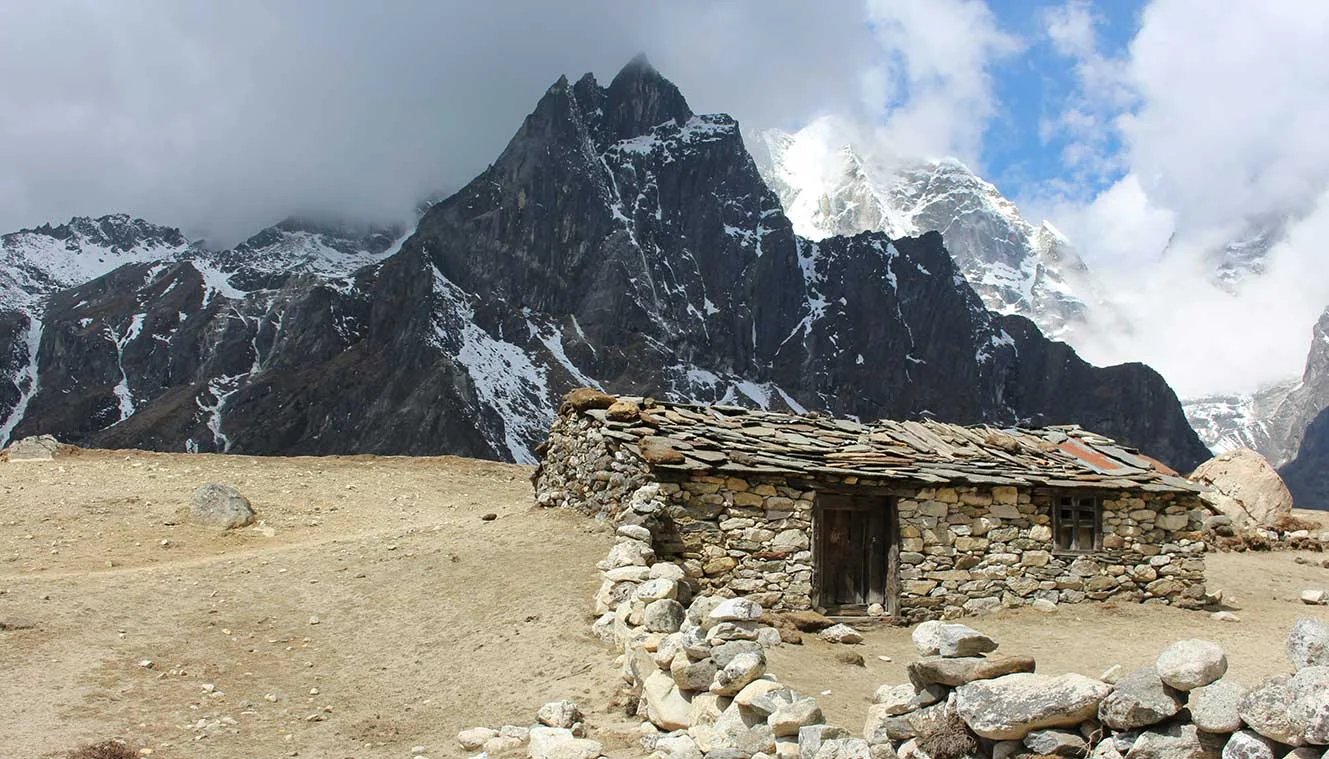
Dingboche (Rest Day) | Acclimatize To Higher Altitudes
Today is a rest day at Dingboche, which will help us acclimatize to the high altitude. As we exert a good deal of energy on the trek, our body needs to get accustomed to less oxygen at higher elevations. So instead of taking a rest day, if continue to gain elevation it can result in altitude sicknesses like dizziness, nausea, and headache or potentially even more dangerous conditions like cerebral or pulmonary edema. To prevent these issues, we start our acclimatization process at the 11,500 ft mark. Since Namche Bazaar is quite near that elevation, we start our acclimatization process from Namche Bazaar itself.
For acclimatization, you can walk around the village. Dingboche village has many farms and crop fields sparse across the village, native crops include barley, potatoes, and buckwheat. You can also do a short hike around the village to Chukung. Its a 3 - 5 hrs trek that takes you to an altitude of 4,730 m. Chukung lies in the Imjatse Valley towards the east. Although the trek is gradual you can feel the effects of thinning air. Chukung has a couple of teahouses as well and you get a superb view of the surrounding areas from here. Some of the views are exceptionally beautiful as you continue to climb higher and higher. Explore the valley and the surrounding areas, return back to the guesthouse. This hike will prepare your body for the next few days at higher altitudes.
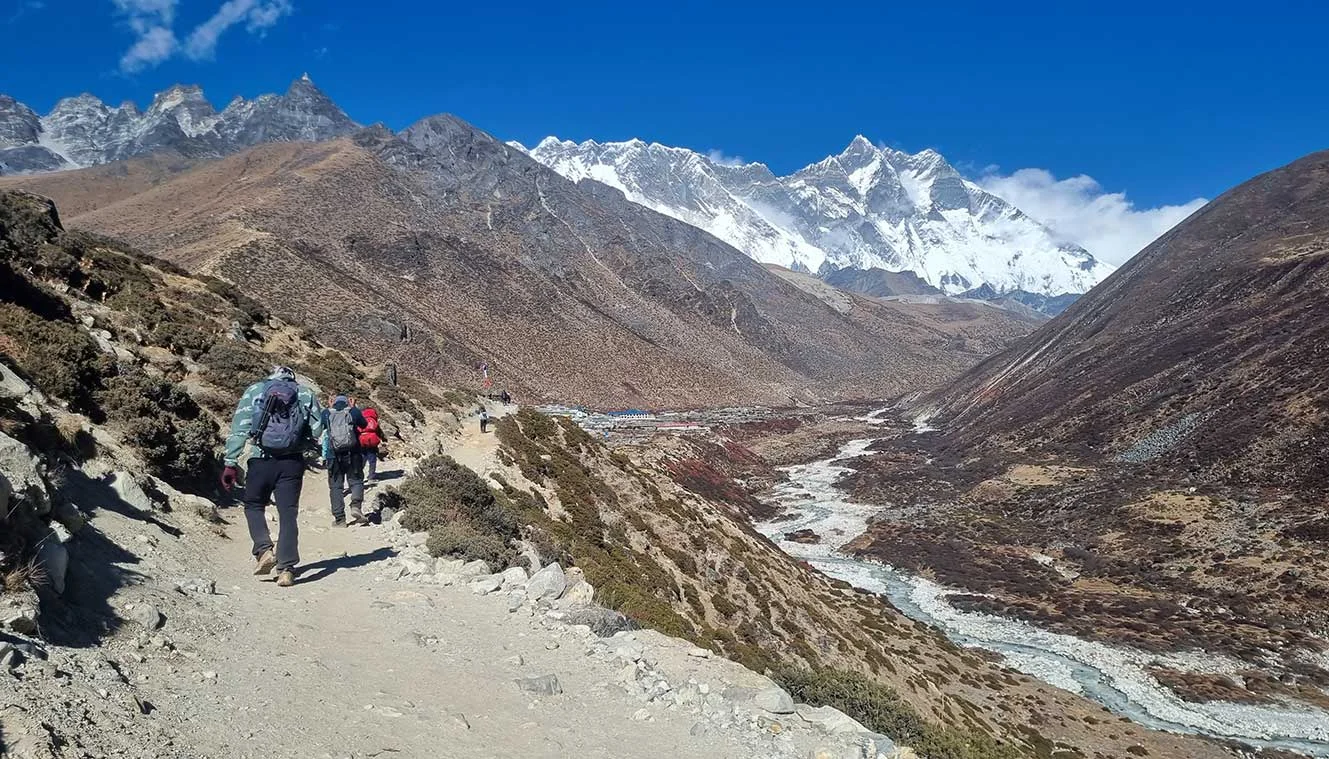
Dingboche To Lobuche | Pay Your Respects In Everest Memorial
- Altitude: 4,950 m/ 16,200 ft.
- Trek Distance: 7 km | Duration: 6 hrs.
- Altitude Gain: 600 m/ 1,950 ft.
- Tricky climb on moraine and rocky terrain.
- You can visit the memorial shrine.
- The top of the ridge is filled with prayer flags and stones which are memorial shrines for climbers who lost their lives on Mt. Everest.
- As you cross Khumbu Glacier, you will see Mt. Nuptse (7,861 m).
Today’s walk will take you from Dingboche to Lobuche through alpine pastures and in the summertime, you can see Yaks grazing in these pastures. You will trek towards the end of the moraine of the Khumbu Glacier offering spectacular views of Mt. Nuptse. At the moraine, you will see stone monuments, these are dedicated to six Sherpas who died in an avalanche along with monuments dedicated to other mountaineers. From here, it’s a steep climb towards Lobuche where you will get a magnificent view of Mt. Nuptse and the sunset over this mountain peak is even more spectacular. From Dingboche, you will have to ascend a small ridge behind the village, towards the north you can see Lobuche Peak (6119 m) and the snowfields of Cho La. Later you will cross Khumbu Khola, the huge glacier moraines of the Khumbu Glacier flowing from Everest. Crossing the memorial cairns, and following the valley stream, you will arrive at Lobuche in the early afternoon. The 6 hrs trek covers 7 km and brings us much closer to the Everest Base Camp.
Start the hike from Dingboche along the inclined path running alongside the mountain’s wall and go further into the valley. As you make your turn along the path and inside the valley, you arrive at the village of Pheriche, we will be staying here on our way back from the base camp. For the next 2 to 2.5 hrs, you will follow into the valley, while the incline is not very difficult but you are at a high altitude, so take it slow and steady and avoid using too much energy too quickly. A river lies in front of you and crossing the river, you will arrive at the village of Thukla. This is a great spot to rest for a couple of minutes, refuel yourself and continue on the trek.
The next part is going to be the toughest part of the trek today as you climb to Lobuche. The climb takes you along a zig-zag path all the way to the Thukla Pass and it becomes steeper and steeper as you climb until you reach the edge of the Khumbu Glacier and the Everest Memorial. The oxygen gets less and less from here and the temperature also starts to get lower. The remaining part of the trek follows the left side of the glacier as you reach the village of Lobuche and you will also gain a little elevation from the glacier as you arrive at Lobuche. In front of you, you get to see a beautiful view of Nuptse in front of you. Lobuche is a small Himalayan village with only a handful of teahouses. We will stay the night here before we head out to the last village on the trek tomorrow.
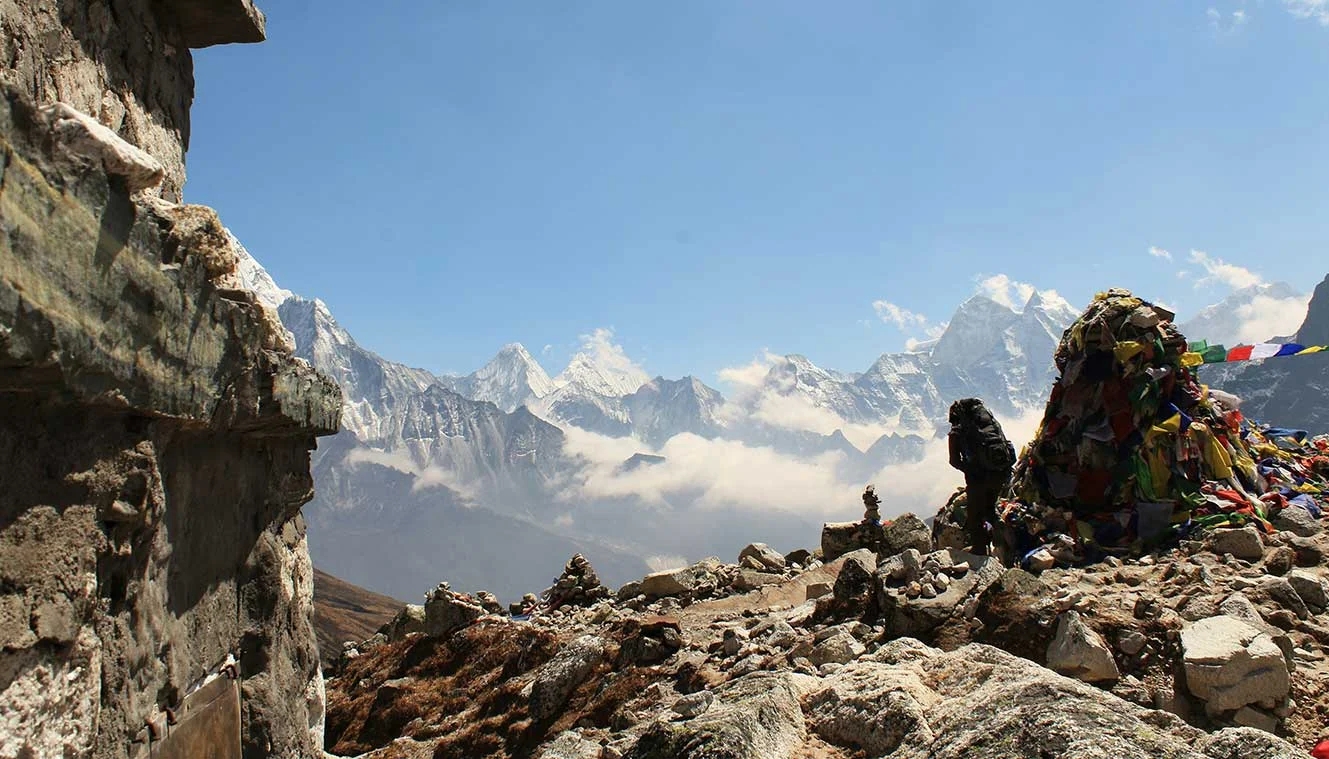
Lobuche To Gorkhashep | Excursion To Everest Base Camp
- Altitude: Gorakshep - 5,150 m/ 16,900 ft & highest point - 5,350 m/ 17,750 ft.
- Altitude Gain: 200 m/ 700 ft.
- Lobuche To Gorakshep: 6 km | Duration: 4 hrs.
- Gorakshep To EBC: 3 km away each.
- It’s Everest Base Camp Day Today.
- Good steep climb to Gorakshep.
- It takes about 3 to 4 hrs to reach Gorakshep.
- Lunch is at Gorak Shep.
- A steeper climb to Everest Base Camp.
- The trek to Everest Base Camp is not very difficult.
- Trekker\\\\\\\\s stop point is just below the actual base camp.
- Most tour groups are not allowed to enter or stay in EBC.
- Make sure you carry your day pack since you will need water.
- You can enjoy amazing views of Nuptse, Khumbutse, and Pumori mountains from the base camp.
- Overnight stay in Gorakshep.
Note: Drinking water in Gorakshep is chargeable. We don’t include drinking water on the trek which you can buy from a number of places between $1 to $3 a bottle (it gets more expensive towards the base camp). The better alternative is to buy water tablets in Kathmandu/Pokhra for around $2 and treat the water.
Today is the most exciting day of the trek as you make an excursion to the Everest Base Camp. An adventurous journey and a great trekking experience await you. Waking up early, have your breakfast, and gear yourself up. We will follow the trail from Lobuche through narrow gaps in the mountains and glacial moraines along the Khumbu glacier to Gorak Shep, the last village on the trek. Post lunch in Gorak Shep, we begin our trek to the Everest Base Camp, the ultimate adventure of this entire journey. We follow the lead of Sherpas as the trail changes every season as the glaciers move. It takes about 7 hrs of walking to reach Everest Base Camp. Spend some time at the base camp, celebrate your victory, capture some stills and descend back to Gorakshep. Overnight stay will be at Gorakshep.
The trek today can be broken down into two parts, the first part is the trek from Lobuche to Gorak Shep and the second part is an excursion to EBC and back to Gorak Shep. After breakfast at Lobuche campsite, we begin our trek towards Gorak Shep. It is a 6 km hike that takes about 4 hrs. Walking along the sandy and rocky parts, you will gradually gain elevation as you walk alongside the Khumbu Glacier. Mt. Nuptse looms on the horizon in front of you. Some sections of the trail are a little steeper than others. On the way, you will pass Sherpa flag monuments indicating that you are getting closer to the Everest Base Camp.
The last section of the trail directs into a glacier before you reach Gorak Shep. the terrain is rocky and uneven with inclines and declines. Be cautious and watch your step in this part and always pay heed to the trek leader\\\\\\\\s advice to complete the patch safely. You can see a sliver of the top of Mt. Everest from here, right behind Nuptse. Soon the village of Gorak Shep comes into view guarded by Kala Patthar and Pumori in the back. Make your way into the guest house have some lunch, reenergize yourself and get ready for the next part of the trek.
From Gorak Shep, you will walk right along the Khumbu Glacier, the Everest Range lies right behind it. It is a vast glacier and as you continue walking along the side of the glacier, you will constantly gain elevation until you reach the base camp. The incline is not very steep and is slightly moderate. A technical terrain lays ahead of you with a mixture of sand and rocks and it can get pretty slippery at some points as well. As long as you watch your steps, you will be good. Continue on and you will reach a point where the Khumbu icefall comes into better view as it winds down from the mountain to the valley. More Sherpa prayer flags mark the way to the base camp. In the final stretch of the trail, you will see numerous prayer flags flowing in the wind and the popular Everest Base Camp Rock. You have made it to the Base Camp, congratulations! While this is not the actual base camp, it is a trekker’s base camp. Most tour groups are not allowed to enter or stay in EBC. Once you have had enough time to enjoy the area around EBC, it is time to head back to Gorakshep. Follow the rocky trail back to Gorak Shep. We will stay the night in Gorak Shep.
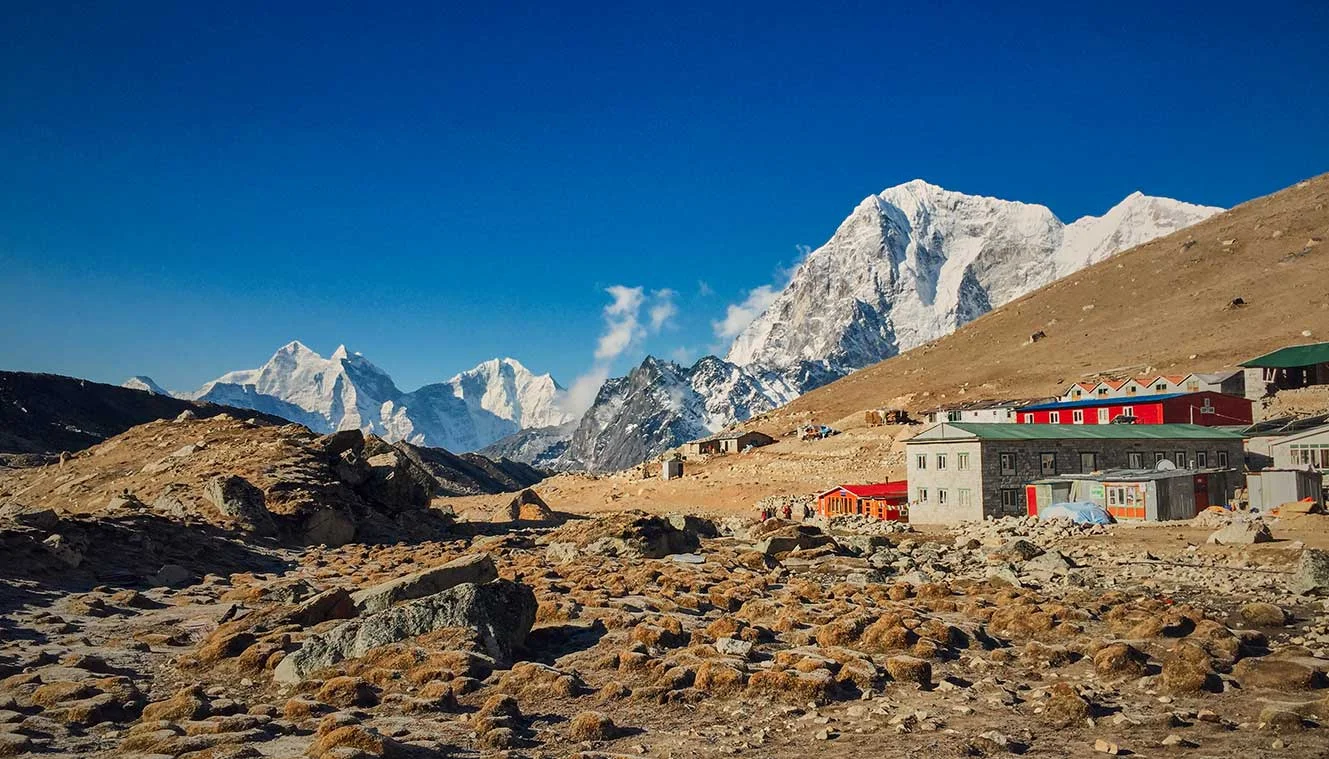
Hike To Kalapatthar And Retreat Trek To Pangboche | Enjoy Arresting Views Of Mt. Everest
- Altitude: Kalapatthar - 5,550 m/ 18,200 ft Pangboche - 4,300 m/ 14,100 ft.
- Gorakshep To Kalapatthar: 2 km each way | Duration: 3 to 4 hrs.
- Gorakshep To Pangboche: 25 km | Duration: 6 hrs.
- Altitude Loss: 850 m/ 2,800 ft
- Steep climb to Kalapatthar (difficult).
- Gradual descent to Pangboche.
- Start early in the morning to avoid early morning clouds.
- Kala Patthar is the rocky hilltop below Pumori.
- Views from the summit: Everest, South Col, Lhotse, Makalu, Khumbu Glacier & icefall, Pumori & Everest Base Camp.
- Breakfast at Gorakshep after Kalapatthar hike.
After your trek to EBC and back to Gorakshep, you are now ready to climb Kala Patthar. Gorakshep is also a good place to roam around, it has a couple of teahouses and it also used to be the base camp for climbing Mt. Everest in the 1950s. The trek starts with an easy walk from Gorakshep and you will be walking on sandy fields. After this, there is a steep climb of 45 minutes. After the strenuous climb, you will come to level fields and the walk is easy and gradual. You will have the comfort of walking for the next one hour, post which there is another steep climb to Kalapatthar for about half an hour. Mt. Everest from this point looks closer than you can imagine. From here, you will trek down to Pangboche.
Start your day early and leave your stuff at Gorakshep, only carry a daypack with the essentials as you will return to Gorakshep. As you cross the sandy trail and begin ascending, you will notice the Gorakshep village and Khumbu Glacier behind you including Ama Dablam. The top of Mt. Everest begins to peek out above the surrounding mountain ranges. The more you gain altitude the more Mt. Everest will come into view. The best part of today’s trek is that all along the trek you can enjoy the landscape of the surroundings and not just on the summit. The higher you get, the rockier and trickier the trail gets. Be mindful and watch your steps. The last patch is especially rocky.
The summit is a little difficult to navigate as well. You will know you are near the summit when the Sherpa prayer flags and weather reading device come into view. Take your time and dont rush to the summit to avoid any accidents. Once you reach the summit, you will get to see the breathtaking views of the entire Sagarmatha National Park but the main attraction is of course Mt. Everest itself. You will get the best view of Mt. Everest from here. Below Everest lies the Khumbu icefall that feeds into the Khumbu Glacier and to the right is the face of Mt. Nuptse. On the opposite side of the lake, you will see even more glaciers, lakes, and mountains, as far as your eyes can see. After spending some time at the top, descend the same path that you came in. When you are back in Gorakshep have a nice meal and refuel yourself as we will descend to Pangboche.
On the trek down, the first village will be Lobuche and throughout the trek, you will again be alongside the Khumbu Glacier. You have already completed this section while ascending up so you now have an idea of what to expect. The trek is a little tricky till Sagarmatha National Park sprawls out in front of you and the rest of the part is manageable. You can have some snacks at Lobuche before heading down to Pangboche.
As you descend, you will come to the intersection where one path diverges towards Dzonghla village, Cho la pass, and Gyoko Ri, and the one on the left heads towards Pangboche. Stay on the left side of the trail and you will come across another difficult patch of the trek. You will head down from the moraine wall of the Khumbu Glacier and descend to the Thukla Pass. Crossing the Everest Memorial, begin a tricky hike down to the river below and soon you will arrive at Pangboche.
Pheriche lies just below Dingboche so after crossing Thukla, you can take the lower path towards Pheriche instead of taking the higher path towards Dingboche. Once we arrive at Pangboche, you will check into a teahouse, have your dinner, and rest for the night before heading down to Namche Bazaar the next day.
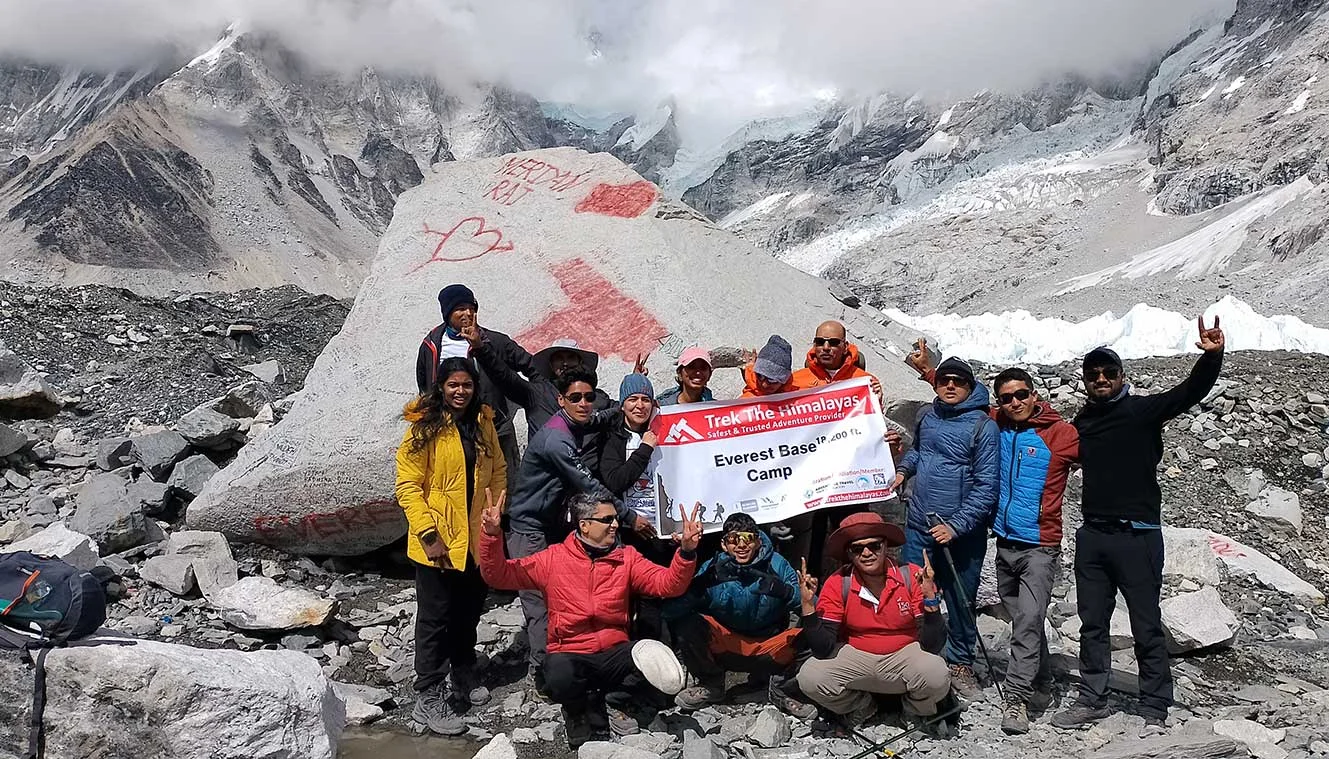
Pangboche To Namche Bazaar | Buy Some Souvenirs
- Altitude: 3,450 m/ 11,300 ft.
- Trek Distance: 15 km | Duration: 6 to 7 hrs.
- Altitude Loss: 850 m/ 2,800 ft.
- Moderately, continuous descent and short ascent just before Namche Bazaar.
After your descent to Namche Bazaar, the cumbersome part of the trekking is almost over. From here on the descent will be easy after having the Everest Base Camp trek. But we recommend starting early as it is a long walk. Start the journey by heading down to the village, across the river, and again climbing back up the valley wall. You can rest here for some time, catch your breath before resuming your decline down the valley.
Once you have declined the path, you will cross a suspension bridge followed by a 2 km incline along the valley wall. As you zig-zag up towards the trail, it becomes forested and once you have completed the uphill ascent, it is a fairly smooth walk for the remaining 5 km to Namche Bazaar. The path to Namche Bazaar is etched on a valley wall and there’s the river below. Soon the path bends inwards and you are welcomed with views of Namche Bazaar. Descend down to the village below and check into a teahouse. Rest well. Tomorrow will be the last day of your trek.
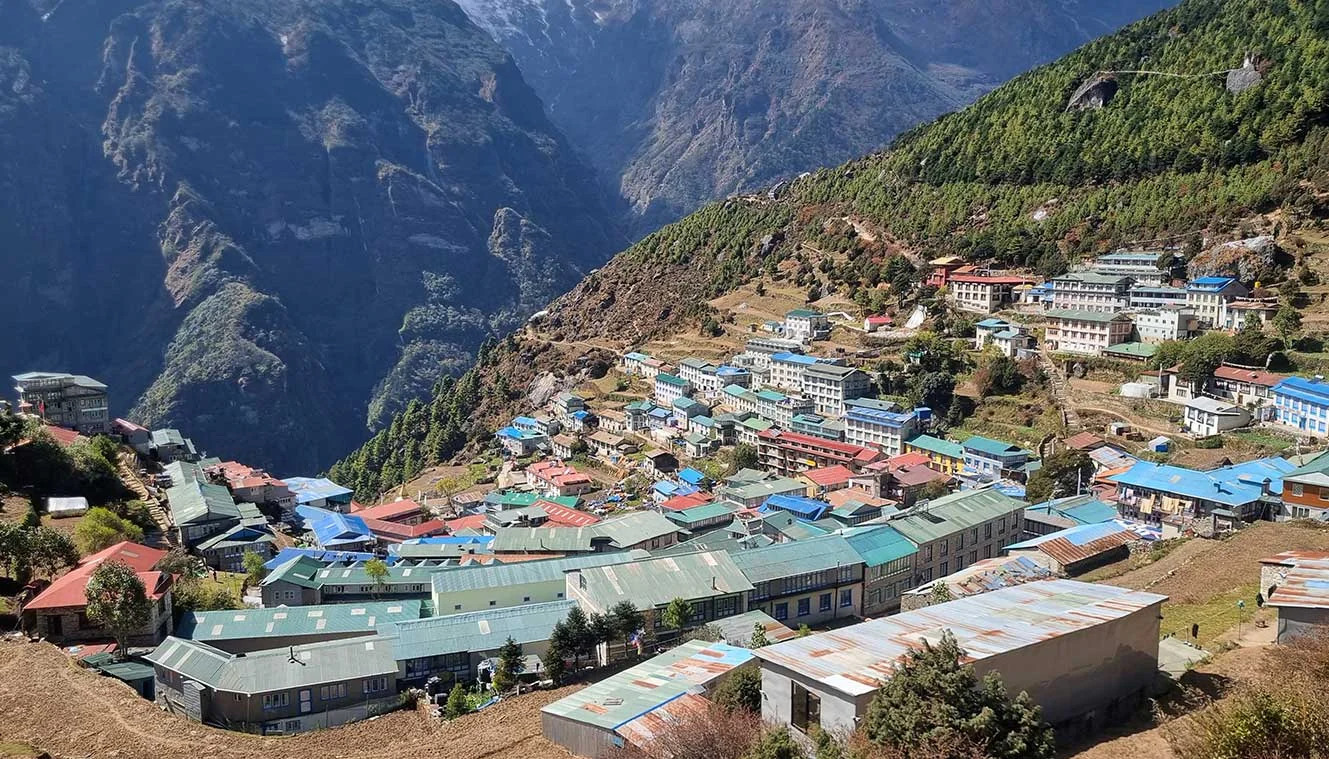
Namche Bazaar To Phakding To Lukla | Last Day Of Trekking
- Altitude: Phakding - 2,600 m/ 8,500 ft, Lukla - 2,850 m/ 9,350 ft.
- Altitude Loss: 600 m/ 1,950 ft.
- Trek Distance: 19 km | Duration: 7 to 8 hrs.
- Moderate, continuous descent till Phkading and gradual ascent to Lukla.
- Start your trek early in the morning as it is a long day trek.
- Stop at Phakding for lunch.
- Stay in Lukla.
Waking up to the lovely weather at Namche Bazaar, you can visit the place and roam around a little bit. You can explore the market and buy souvenirs from your trip to the Everest Base Camp and buy gifts for your friends and family. There are several local handicraft stores in Namche Bazaar as it is the biggest trade hub in the Khumbu region. You can also take a small walk-in around the Sagarmatha National Park and enjoy the local cuisine as well. Post which treks down to Phakding, it is an easy trek down to the village. The beauty of the distant mountains with several waterfalls adds to the beauty of your journey. This is the beauty of Nepal trekking, there will be a few uphill climbs but you will manage it very easily. The lush green beauty and forests will take your pain away. After this easy walk, you will reach Lukla. This will be your last day with the Sherpas and other crew members, so you would like to enjoy the day with a delicious dinner and a few drinks.
Right at the beginning of the trek, you will begin to lose elevation, after about 45 minutes of walking, you will arrive at a rest stop, the same that you came in on when ascending towards the basecamp. This is where you will get the last glimpses of Mt. Everest. After this point, there are no mountain views anymore only little peeks from behind the forest covers. You will cross a few suspension bridges and continue alongside the river as the initial steep decline eases into a more moderate decline. While most of the trek is downhill, there are a few uphill climbs as well. Pass by Sherpa stones into the village of Phakding. You are more than halfway to Lukla by now. We will stop at Phakding for lunch before descending further down the valley with river views, mountain ridges, and suspension bridges. You will also have several stair sections and an incline path all the way through. Passing by a few more villages, you will arrive at Lukla, your final stop for the day.
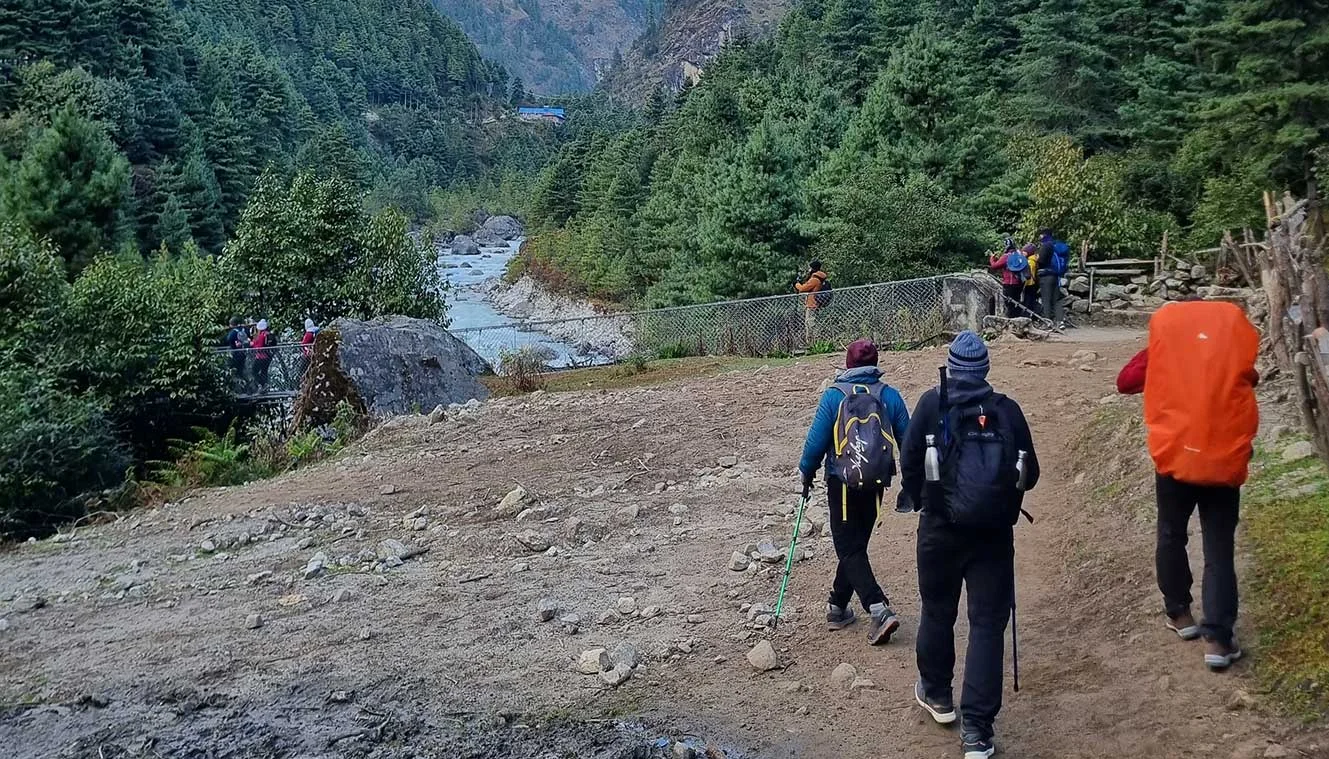
Fly Back To Kathmandu | Bid Adieu To The Mountains
Today you will have to wake up early as flights to Kathmandu are generally scheduled in the morning. This is because during the daytime, the weather is generally windy and there might be a delay in the flight timings. However, you can expect a slight delay in your early morning flight as well if the weather is not suitable. As you make your way through the security checks and your flight takes off from Lukla airport, you will have a magnanimous view of the surroundings. Drive back to Kathmandu from Ramechhap Airport and overnight stay in a hotel. You can book your further journey from here. We wish you a great journey towards your home with lots of memories.
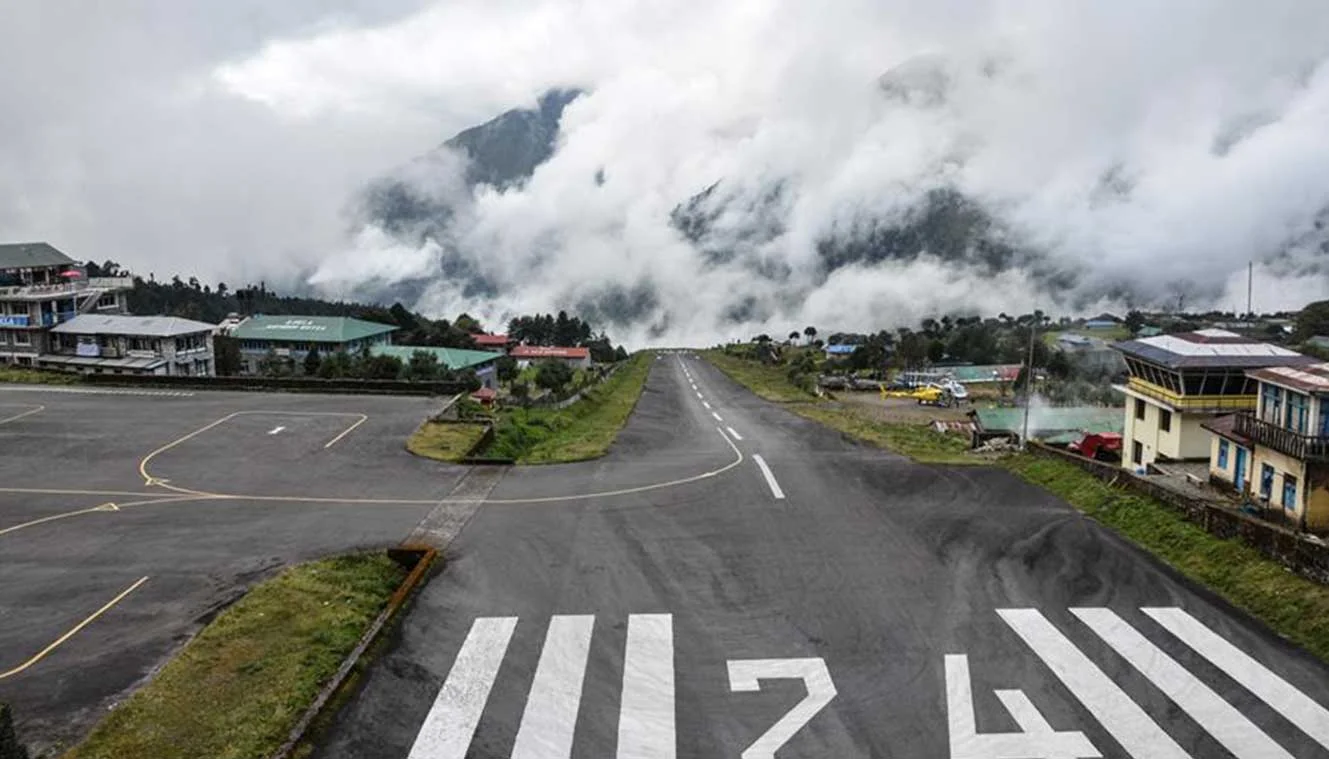
Day-1: Arrive At Kathmandu
Day-2: fly to lukla, trek to phakding | enjoy a scenic flight journey.
Note: Flights to Lukla are prone to delay due to weather, keep one or two buffer days in your plan.
Day-3: Phakding To Namche Bazaar | A Major Trading Hub In Khumbu
Day-4: acclimatization day | explore namche bazaar.
- Today is acclimatization day.
- You can hike up to Sherpa Cultural Museum to get a view of Everest and Ama Dablam.
- It’s worth exploring the town, a good place to buy trekking gear.
- ATMs, internet cafes, shops, and restaurants are available at extra cost.
- Stay in the guesthouse.
Day-5: Namche Bazaar To Tengboche | Visit The Largest Buddhist Monastery Of Khumbu
Day-6: tengboche to dingboche | stunning views of ama dablam, day-7: dingboche (rest day) | acclimatize to higher altitudes.
- Rest Day helps you acclimatize well to high altitudes.
- A small hike today will show you the world’s six tallest peaks including Lhotse (8,516 m), Makalu (8,463 m), and Cho Oyu (8,188 m).
- From another location, you can see the Imja Khola Valley and Dingboche Valley.
Day-8: Dingboche To Lobuche | Pay Your Respects In Everest Memorial
Day-9: lobuche to gorkhashep | excursion to everest base camp, day-10: hike to kalapatthar and retreat trek to pangboche | enjoy arresting views of mt. everest, day-11: pangboche to namche bazaar | buy some souvenirs, day-12: namche bazaar to phakding to lukla | last day of trekking, day-13: fly back to kathmandu | bid adieu to the mountains.
- Morning flight to Kathmandu.
- Your trek to Everest Base Camp is over.
- Spend the day in Kathmandu or fly back to your onwards destination.
- Hotel accommodation in Kathmandu is included in the cost.
Note: Weather conditions may cause flight cancellations. Delays are possible any time of the year but are more typical on summer departures. Keep one or two buffer days.
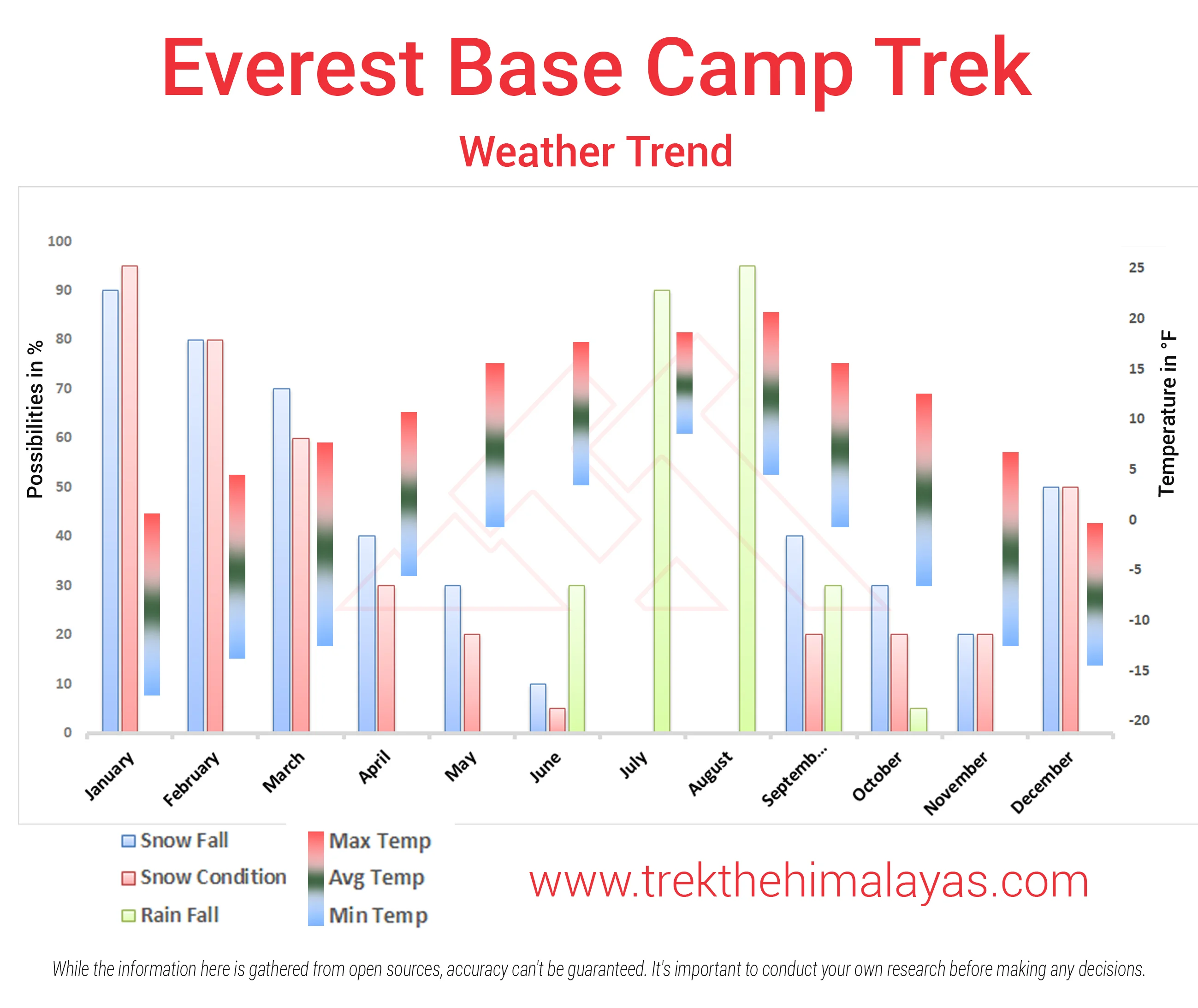
Medical & Disclaimer Form (Mandatory Documents) Click Here.
How To Reach
It is essential for everyone to arrive at Kathmandu (1:00 pm).
Upon booking the trek, you are required to come to our hotel. Your trek coordinator will provide you with details such as the name of the Kathmandu hotel, its location, and the contact person's number.
Options to reach Kathmandu.
The best way is to fly to Kathmandu Tribhuvan International Airport, which receives airlines mostly from South-east Asia and Europe. A number of direct flights fly from Delhi, Mumbai, Kolkata, Bangalore and Varanasi to Kathmandu. Popular airlines that operate regularly are Jet Airways, Air India, IndiGo and Nepal Airlines.
Delhi to Kathmandu by train + bus :-
Day 1: Take a train from Delhi to Gorakhpur. The Vaishali Express leaves Delhi at around 19:45 and arrives at Gorakhpur Junction at 09:10 next morning, or there's another train from New Delhi at 17:20 arriving Gorakhpur at 06:35 next morning. The fare is around Rs. 2440 (£35 or $54) in AC1, Rs. 1240 (£18 or $27) in AC2, Rs. 785 (£12 or $18) in AC3 or Rs. 315 in Sleeper Class - check current times and fares at www.indianrail.gov.in or www.irctc.co.in.
Day 2: Take a bus or jeep from Gorakhpur to the Nepalese frontier at Sunauli (Indian side) and Bhairawa (Nepalese side, often also called Sunauli). Journey time about 3 hours, Rs. 55 (£1 or $2).
Walk across the frontier, it's then a few minutes’ walk to the Bhairawa bus station. Take a bus or jeep on to Kathmandu. Buses take 9 to 12 hours, cost about 120 Nepalese Rupees or 230 Indian Rupees (£1 or $2). There are many buses daily, either daytime buses leaving regularly until about 11:00 or overnight buses leaving regularly from about 16:00 until 19:00. Indian rupees may be accepted here in Bhairawa, but not further into Nepal.
It's also possible to travel via Varanasi An overnight train links Delhi & Varanasi. Buses link Varanasi with the Nepalese border.
For your return journey from Kathmandu, you have the flexibility to choose between road or air transport options. Please note that our services extend only to the hotel, and the standard hotel check-out time is 11:00 am.
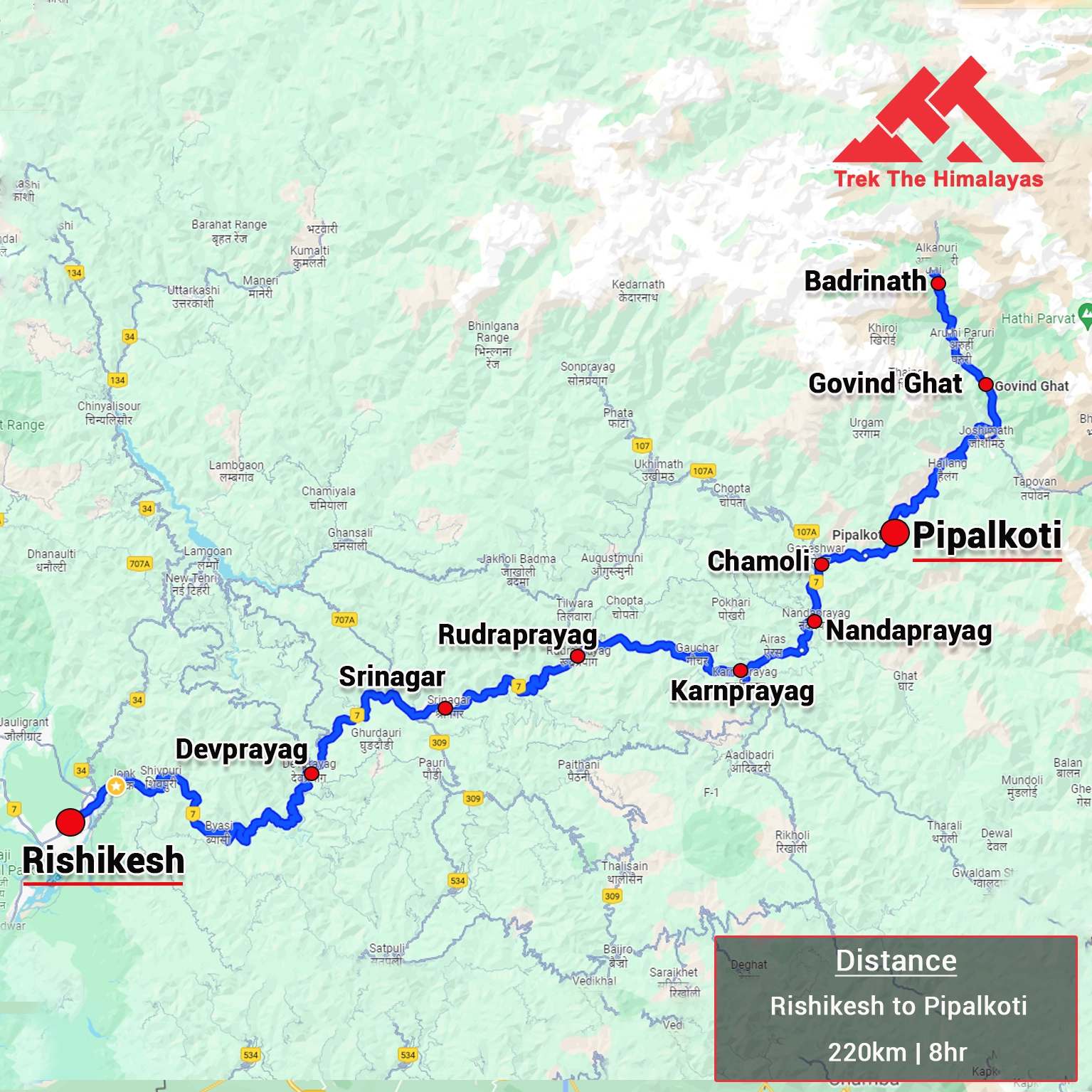
1. Accommodation (as per the itinerary):
- Day 1 and Day 13 Hotel Accommodation in 3 Star Hotel in Kathmandu with Bed & Breakfast.
- Day 2 to Day 12 Accommodation in Teahouse.
2. Meals (Veg + Egg):
- All meals Lukla to Lukla from Day 2 Lunch to Day 13 Breakfast
- Fresh fruit after dinner every day.
3. Support:
- 1 Versatile base camp manager: handles communication and deploys extra manpower in emergencies.
- 1 Mountaineering & First aid qualified professional trek Leader.
- 1 Experienced high altitude chef.
- Local experienced guides (Number of guides depending on the group size).
- Enough support staff.
4. Trek equipment:
- Sleeping bag, Sleeping liners (if required), Mattress, Utensils.
- 3 men all season trekker tent (twin sharing), Kitchen & Dining tent, Toilet tent.
- Camping stool, Walkie talkie.
- Ropes, Helmet, Ice axe, Harness, Gaiters & Crampon (if required).
5. First aid:
- Medical kit, Stretcher, Oxygen cylinder, Blood pressure monitor, Oximeter, Stethoscope.
6. Transportation (as per the itinerary):
- Arrival Departure Airport Transfer as per itinerary.
- Domestic airport transfers for Lukla.
- Kathmandu to Ramecchap /Lukla, and back.
7. Mules/porters to carry the central luggage.
8. Clock room facility available at the base camp for additional luggage.
9. All necessary permits and entry fees, Upto the amount charged for Indian.
10. Services from Kathmandu to Kathmandu .
11. TIMS card.
12. EBC Map.
13. Farewell Dinner in Kathmandu.
14. Trek Completion Certificate
15. Complementary Trekking Kit Bag (Duffle bag if opted for Porter facility).
1. Insurance (Mandatory).
2. Food during the transit.
3. Any kind of personal expenses.
4. Mule or porter to carry personal luggage.
5. Emergency evacuation, hospitalization charge or etc.
6. Anything not specifically mentioned under the head Inclusion.
8. Extra Expenses.
- Porters for the personal bag*.
- Wifi, charging batteries and hot showers.
- Customary gratuities for guides & porters.
9. Nepal entry visa (approximately $40 USD, Bring Two Passport Size photos) only for foreigners (Not for Indians).
10. Unforeseen costs due to flight cancellation, weather conditions etc.
11. Extra night accommodation Kathmandu.
Things can be provided on demand and availability (participant has to pay extra for these things).
1- Satellite phone/set phone - is a type of mobile phone that connects via radio links via satellites orbiting the Earth instead of terrestrial cell sites like cellphones. Therefore, they can operate in most geographic locations on the Earth's surface.
2- Gamow/PAC HAPO Bag (Portable Hyperbaric Bag) - is a unique, portable hyperbaric chamber for the treatment of acute mountain sickness (AMS), also known as altitude sickness.
3- AEDs (Automated External Defibrillators) - are portable life-saving devices designed to treat people experiencing sudden cardiac arrest, a medical condition in which the heart stops beating suddenly and unexpectedly.
Cancellation terms:
Cancellations prior to 25 days from the start of the Trip
Refund options
- 5% deduction of trek fee
- 100% cash voucher for any trip till one year
- Transfer your trek (any trek, any date) to your friend
Cancellation between 24 days and 15 days to the start of the Trip
- 30% deduction of trek fee
- 100% cash voucher for same trip till one year
- 85% cash voucher for any trip till one year
- Transfer your trek (same trek, any date) to your friend
Cancellation between 14 days and 10 days to the start of the Trip
- 50% deduction of trek fee
- 80% cash voucher for same trip till one year
- 70% cash voucher for any trip till one year
- Book the same trek, in the same season, with any other batch
Cancellation less than 9 days to the start of the trek
- No cash refund
- 20% cash voucher for the same trip till one year
- 10% cash voucher for any trip till one year
- Transfer your trek (same trek, same date) to your friend
Note- If a booking is made using a voucher or discount code, the policies related to vouchers and discounts cannot be modified.
In the unlikely event that TTH cancels a trek prior to the scheduled departure date:
While it is extremely rare for TTH to cancel a trek, we understand that unforeseen circumstances or natural disasters may occasionally require us to do so before the scheduled departure. These circumstances could include continuous rain or snow, thunderstorms, snowstorms, landslides, floods, earthquakes, or any other natural calamity that poses a risk to the safety of our trekkers. Additionally, unforeseeable events such as local riots, curfews, pandemics, lockdowns, government orders, or any similar situations that compromise the safety of the trekking experience may also necessitate a cancellation.
In the event of such a cancellation, TTH will provide you with a voucher equivalent to the amount you paid for the trek. This voucher can be redeemed for any of our treks within the next year, allowing you to still enjoy an adventure with us at a later date.
The issuance of a voucher is not applicable in situations where you are required to descend from the trek for any reason. The trek leader may make the decision to send you down from the trek due to factors such as insufficient fitness level, symptoms of Acute Mountain Sickness (AMS), high blood pressure, exceeding the designated turn-around-time, health concerns, or if you are found smoking, drinking, or violating the rules set for the trek. In such cases, the provision of a voucher does not apply.
In the rare event that TTH shifts a trek:
We would like to emphasize that weather conditions in high-altitude areas are highly unpredictable and can undergo sudden changes at any time, irrespective of the day. Additionally, circumstances beyond our control, such as natural disasters, political unrest, pandemics, and lockdowns, may impact the feasibility of conducting a trek. In cases where we are unable to proceed with an event due to such circumstances that are beyond our direct control, we will make every effort to provide you with an alternative trek that is safer and more suitable.
In such situations, we will issue a voucher to offset the cost difference between the originally scheduled trek and the alternative trek. This voucher can be redeemed at any time within one year from the date of issue. Please note that a refund fee or reimbursement of the cost difference is not applicable in these cases.
- Change of trek batch is dependent on the availability of seats in the batch
- In case of transferring a trek to a friend, he/she should satisfy all the mandatory requirements put forward by TTH
- TTH holds the right to change/cancel the policies, without prior notice
- Cash refund is applicable only in case of bookings made without using any promotional offer code or vouchers
Cash Voucher Terms:
- This is a non-transferable voucher
- The voucher cannot be merged with any other offer of Trek The Himalayas
- The voucher is valid for Trek booked directly with Trek The Himalayas in India
- To avail the voucher please use your register phone number or e-mail id
- All the other Terms of booking a trek with Trek The Himalayas are applicable to the voucher
- Trek The Himalayas holds rights to add/remove any of the Terms and Conditions without prior notice
Itineraries are based on information available at the time of planning and are subject to change. "Trek The Himalayas" reserves the right to change expedition dates, people or itineraries as conditions warrant. If a trip must be delayed or the itinerary changed due to bad weather, road conditions, transportation delays, government intervention, airline schedules, sickness, or other contingency for which TTH or its agents cannot make provision, the cost of delays and/or other changes are the responsibility of the participant. TTH reserves the right to decline, or accept, any individual as a trip member for any reason whatsoever.
Trek Essentials
PDF Of Trek Essential Download
Frequently Asked Questions(FAQ)
How to register/create an account with tth.
To register with TTH, visit our website - www.trekthehimalayas.com and create your account. To create your account you will need to use your email address and fill in all the details, set your unique password and your account is ready to use.
How to book a trek?
- To book a trek with TTH, you first need to register with us and create an account.
- Choose the trek that you want to do and click on available dates.
- You will land at the login page, fill in the required details.
- Add Participants, choose add-on services click on the Pay now button, choose your preferred payment method, and make the payment. TTH accepts multiple payment options, including credit/debit cards, net banking, and UPI.
- You will receive a confirmation email from TTH with all the necessary details about the trek, including the meeting point, transportation, accommodation, and other important instructions.
Made a payment but did not receive any confirmation.
please send an email to us at [email protected] or reach out to the numbers provided in the Help and Support section of your Trek Page. We will ensure that your issue is promptly resolved.
How to book off-load luggage and transportation?
To book services such as off-load luggage and transportation, you can find them listed as add-ons. These additional services can be booked at the time of your initial booking. If you miss booking add-ons during the initial reservation, you can log in anytime and easily book 4 days before the departure date add-ons through the platform.
If I have booked the wrong trek or date, how can I make changes?
In such a situation, please log in to your account and transfer your trek or date to the desired one within 12 hours or drop us an email at [email protected] 10 days before the departure date of the trek. After the initial 12-hour period, any changes will be processed according to the cancellation policy.
I am a beginner and confused which trek to book.
We recommend visiting our "Suggest Me a Trek" page. By filling out the form, our experts will contact you with the best possible trek options based on your preferences and experience level. Alternatively, you can reach out to us via email at [email protected] or give us a call using the numbers provided on our website for personalized assistance and recommendations.
How is family trek different from regular trek?
Family treks differ from regular treks by focusing on ease of difficulty, offering shorter durations for younger participants, Kid-friendly and easily digestible foods, child-friendly activities, maintaining a higher guide ratio for diverse age groups, and implementing additional safety measures for families.
Ideal treks for children.
Family Trek with Kids recommendation Only Dayara Bugyal and Chopta Chandrashila Trek.
Minimum age for children to trek with TTH.
Minimum age for TTH treks is typically 7 years, though this may vary depending on the specific trek.
Can we take children to high altitudes with their guardian?
Yes, you can take a kids to a high-altitude trek with a parent. Discuss with a trek expert before booking a trek.
Can we send kids without Parents/guardian?
Medical & Disclaimer Form (Mandatory Documents) Click here to download medical and disclaimer form
How to prepare a child for a high altitude trek?
Physical Fitness: Ensure your child is physically fit. Engage them in regular exercise, outdoor activities, and hikes to build stamina and endurance. Hydration: Emphasize the importance of staying hydrated at high altitudes. Encourage your child to drink water regularly, even if they don't feel thirsty. Proper Nutrition: Provide a well-balanced diet with sufficient carbohydrates for energy and foods rich in iron to prevent altitude sickness. Adequate Sleep: Ensure your child gets enough sleep in the days leading up to the trek. Quality rest is crucial for altitude adaptation. Educate on Altitude Sickness: Teach your child about the symptoms of altitude sickness, such as headache, nausea, and dizziness. Encourage them to communicate any discomfort immediately. Appropriate Clothing and Gear: Dress your child in layers to adjust to changing temperatures. Ensure they have appropriate trekking gear, including sturdy footwear. Positive Mindset: Foster a positive mindset. Encourage your child, and let them know it's okay to take breaks when needed. Medical Check-Up: Schedule a medical check-up before the trek to ensure your child is fit for high-altitude activities. Consult with a healthcare professional about any potential health concerns.
Kind of food will be served during the trek for children.
TTH takes special care to provide wholesome and nutritious food for children on treks. Here are some of the foods that are typically served for children: Breakfast: For breakfast, TTH serves a variety of options like porridge, cornflakes, bread, butter, jam, honey, boiled eggs, omelettes, and pancakes. Children can choose from these options to fuel themselves for the day's trek. Lunch: For lunch, TTH serves lunch which includes rotis, vegetables, rice, dal, and salad. The rotis are usually made fresh on the trek and are a good source of carbohydrates. The dal and vegetables provide protein and other essential nutrients. Snacks: TTH provides healthy snacks like fresh fruits, dry fruits, energy bars, cookies, and biscuits to keep the children energized throughout the day. Dinner: For dinner, TTH serves a hot and wholesome meal which includes soup, rice, dal, vegetables, and a non-vegetarian dish (if requested in advance). Children can also choose from a variety of desserts like custard, jelly, and fruit salad. Dietary requirements: If a child has any special dietary requirements, TTH can cater to those needs as well. For example, if a child is lactose intolerant or allergic to nuts, the kitchen staff can make arrangements to accommodate those requirements.
How to choose the right trek?
Choosing the right trek for a beginner can be a bit overwhelming as there are many factors to consider such as distance, elevation gain, terrain difficulty, weather, and time of year. Here are some tips that can help you choose the right trek for a beginner:
1. Determine fitness level: Assess the fitness level of the beginner to understand their physical capabilities. This will help you select a trek that is challenging but not too difficult.
2. Choose a well-traveled trail: A well-traveled trail will have more amenities such as signposts, water stations, and shelter. It is also safer as there will be other hikers on the trail.
3. Consider the length of the trek: For beginners, it is recommended to start with a shorter trek that can be completed in a day or two. This will help them get acclimatized to trekking and build their confidence.
4. Look for gradual elevation gain: Choose a trek with a gradual elevation gain rather than steep ascents. This will make the trek easier and more enjoyable.
5. Check the weather: Check the weather forecast before selecting a trek. Avoid treks during the monsoon season or winter when the trails can be slippery or dangerous.
6. Research the trail: Read about the trail to get an idea of the terrain, altitude, and difficulty level. This will help you select a trek that is suitable for the beginner.
7. Consult with an expert: If you are unsure about which trek to choose, consult our trek expert Mr. Nitin (+91 70600 59773) between 10 AM to 6 PM (Tuesday - Friday). Mr. Nitin will provide you valuable advice and guidance.
Overall, it is important to choose a trek that is enjoyable, challenging but not too difficult, and suitable for the beginner's fitness level and experience.
Can a beginner choose a tough trek?
It is not recommended for a beginner to choose a difficult Himalayan trek. Trekking in the Himalayas can be physically and mentally challenging, especially if you are not used to the high altitude, steep slopes, and rugged terrain. Choosing a difficult trek without the proper experience, fitness level, and preparation can be dangerous and put you at risk of altitude sickness, injury, and other hazards.
If you are a beginner, it is recommended to start with an easier trek and gradually build up your skills and experience. This will help you understand the challenges of trekking in the Himalayas, and also prepare you physically and mentally for a more difficult trek in the future. It is also important to choose a trek that matches your fitness level, experience, and interest.
What is the age limit for a beginner trekker?
There is no specific age limit for a beginner trekker. However, it is important to consider your physical fitness, health condition, and personal interests before embarking on a trek. Trekking in the Himalayas can be physically and mentally demanding, and requires a certain level of physical fitness and endurance.
If you have any pre-existing medical conditions or are above a certain age, it is recommended to consult with a doctor before embarking on a trek. It is also important to listen to your body and take breaks as needed during the trek to prevent exhaustion or injury.
If I am solo, can I join the trek in a group?
Yes, you can join the trek. We have fixed departure groups where you can simply book your trek and we will take care of curating a group.
How does my family get updated about my Trek?
Before you start the trek, it is recommended that you make all the necessary phone calls as during the trek you may or may not receive network coverage, once you come back to the Base Camp, you can reconnect with your family via phone once again. You can share your trek coordinator contact detail with your family members to get the latest updates about your trek batch.
What food can I expect?
At TTH, we provide wholesome and nutritious meals during the trek. The food is vegetarian and includes a variety of dishes such as rice, dal, vegetables, chapati, paratha, pasta, noodles, and soup. We also offer snacks such as biscuits, and salty, and dry fruits during the trek. Special dietary requirements such as vegan, gluten-free, or Jain food can also be arranged if informed in advance.
I am allergic to some foods.
If you are allergic to some foods, you need to let us know in advance so that we can make arrangements accordingly.
How safe is trekking with TTH?
TTH is a trekking company that prioritizes the safety of all its participants, including women trekkers. They have a comprehensive safety system in place, which includes a dedicated team of experienced and trained trek leaders and support staff who are equipped to handle emergency situations and provide first aid.
TTH also takes specific measures to ensure the safety and comfort of women trekkers. They have a separate tent accommodation for women trekkers, female trek leaders, and support staff. They also provide separate toilet facilities for women and encourage a safe and respectful environment for all trekkers.
Moreover, TTH has a strict policy against any kind of harassment and has a zero-tolerance policy towards such incidents. They have a designated Internal Complaints Committee (ICC) to investigate and address any complaints related to harassment or misconduct. Overall, TTH has a good reputation for safety and responsible trekking practices, and women can feel comfortable and safe while trekking with them.
How TTH will manage if I am the only woman in the group?
In case you are the only women in the group, we provide a single sleeping arrangement. Also, during the trek, the trek leader will always remain by your side to provide optimum safety and reassurance.
How can I know that other women are in the batch?
You can reach out to the trek coordinator to inquire about the number of female trekkers and their respective states who have booked the trek. Please note that the trek coordinator cannot disclose personal details of any trekker. Once you've confirmed your booking, a WhatsApp Group will be created for all the trekkers in your batch. This allows you to connect with fellow trekkers before the trek begins.
Can I know in advance, which trek is led by a women Trek Leader?
While many of our treks are led by female trek leaders, however, it is not possible to know which trek leader is assigned to which group. But nonetheless, whether the trek leader is male or female you can be completely assured of your safety and security with us.
Can I trek with periods? If yes, then where can I dispose of the sanitary pad?
Yes, it is possible to trek with periods. However, it is important to take some extra precautions and preparations to ensure a comfortable and safe trekking experience.
Here are some tips that can help you trek during your period:
1. Use menstrual hygiene products that you are comfortable with, such as tampons, pads, or menstrual cups. It is recommended to carry enough supplies for the entire duration of the trek.
2. Pack wet wipes, hand sanitizer, and plastic bags to dispose of used hygiene products.
3. Wear comfortable and breathable clothing that allows for easy movement and reduces friction. Avoid wearing tight or restrictive clothing that can cause discomfort.
4. Carry pain relief medication, such as ibuprofen or acetaminophen, in case of menstrual cramps.
5. Stay hydrated and maintain a balanced diet to support your energy levels and overall health.
6. Take breaks as needed and listen to your body. If you feel uncomfortable or experience any unusual symptoms, seek medical attention immediately.
It is also recommended to consult with a doctor before going on a trek during your period, especially if you have a pre-existing medical condition or are taking medication. By taking necessary precautions and being prepared, you can have a safe and comfortable trekking experience even during your period.
We provide proper disposal facilities for sanitary pad disposal during the trek.
How will the accommodation be during the trek?
We offer three person tents with twin-sharing for optimum comfort. A woman trekker will share a tent with another woman trekker and if you are the only woman in the group, you will be given a single accommodation for your comfort and privacy.
Are trek poles, Jackets and other equipment available for rent from Trek The Himalayas?
Yes, we do provide gears on rent. You can book it using you TTH account directly.
Who will be with us on the trek from Trek The Himalayas?
Mountaineering qualified Experienced and first aid certified Trek Leader, First Aid Certify local guide, Cook, helpers and supporting staff.
Who can not join the trek?
People suffering from Bronchitis, Asthma, High blood pressure, Epilepsy (got faints), TB , Heart problem or on higher BMI side are strictly not allowed to go on any Himalayan trek. Apart from this if you had any medical history, please let us know.
When it gets really cold can I consume alcohol?
No. Alcohol and smocking isn’t allowed while on trek. It is totally misconception that it will keep you warm. Your body need to acclimatize properly and for that eat properly and drink enough water; these things will keep you warm.
What type of toilet facility is TTH providing at the trek?
Toilet tents provide a convenient solution for answering nature's call in the great outdoors. Dry toilets, in particular, offer a highly sanitary approach. By digging a pit and utilizing mud and a shovel, you can easily cover up your waste. This method ensures cleanliness and hygiene while camping or exploring in the forest.
Remember to pack essential toiletries to complete your outdoor bathroom kit and maintain proper personal hygiene during your adventures. With these practices in place, you can enjoy nature while also respecting it.
How do I manage the negative temperatures on the trek at higher camps? Do I need special jackets?
Layer Up From Head To Toe Eat Full Meals, never sleep empty stomach You can keep warmee (if you’re more susceptible to cold). Use sleeping bag in right way and don’t leave free space in sleeping bag.
For upper body – Thermal layer – T-shirt (full-sleeves) – Fleece T-shirt (for extreme colds) – Fleece layer – Thick Jacket/Down Jacket – Waterproof or Windproof layer (outermost layer, when it is snowing or raining) - For Lower Body – Thermal layer – Hiking pants (normal) or Winter hiking pants
Based on how warm you feel you can skip any of the above layers. Your outer later should be windproof since it is windy at high altitude. The idea behind layering is that the more insulation you have the less cold you feel, and instead of wearing a very thick jacket if you wear multiple layers, your body will be better insulated against the cold.
Do you provide crampon/micro spikes and gaiters?
Yes, we provide micro spikes and gaiters, if required.
What documents need to carry on trek?
Mandatory documents: 2 xerox of ID having address (addhar card/driving license), 2 Passport size photographs, hard copy Medical form signed & sealed by doctor, disclaimer form sign by trekker and high altitude insurance.
If we come prior the trek date, Do you provide accommodation?
No. We don’t but we can suggest you good hotel/Stay nearby pick up location.
Do we get enough water for drinking?
Yes, trekker must carry 2 water bottles 1 litre each so they can refill it at campsite for drinking and keep themselves hydrate.
What kind of shoes we should buy for the trek?
You should buy shoes which has these three features –Good grip, Ankle Support and additional water resistant layers. Generally, we advise Quechua Trek 100, MH 500 and MH 100.
How do we get back after the trek?
Your return transport is also included in trek fee if you're opting for service Dehradun to Dehradun ; we use Tempo Traveller/ Tata Sumo/Max/Boloero kind of vehicle.
What happens if some members of the team need to turn back before the summit?
No one is forced to go on. There is always enough staff to split the party according to need and regroup later at the camp. Most people have no trouble reaching the highest campsite. If some members decide not to climb the final distance they can wait for the climbers to come back down the same way or take a lateral path to the descent route.
What kind of help is available in case of emergency?
We always have a first aid kit close at hand. Serious injuries are rare. Porters will assist injured climbers to the base of the mountain and onward to a clinic or hospital. Kilimanjaro International Airport is very near Marangu Gate if evacuation to the US or Europe is advisable.
What is Everest Base Camp Trek?
Everest Base Camp Trek (EBC) is a popular trekking destination located at the base of Mount Everest in the Khumbu region of Nepal. It serves as a starting point for many climbers who aim to summit Mount Everest and offers stunning views of the surrounding Himalayan mountain range.
Where is Everest Base Camp located?
Everest Base Camp is located in the Khumbu region of Nepal, at an altitude of approximately 18,200 ft above sea level.
What is the altitude of Everest Base Camp?
The altitude of Everest Base Camp is approximately 18,200 ft above sea level.
How do I get to Everest Base Camp?
To get to Everest Base Camp, you need to first fly to Lukla from Kathmandu and then trek for around 8-12 days through the Khumbu region of Nepal.
Do I need a permit to trek to Everest Base Camp?
Yes, you need to obtain a Sagarmatha National Park Permit and a TIMS (Trekkers' Information Management System) card to trek to Everest Base Camp.
How long does it take to trek to Everest Base Camp?
It takes 13 days to complete Everest Base Camp, depending on your fitness level and the route you take.
What is the best time to trek to Everest Base Camp?
The best time to trek to Everest Base Camp is during the spring (March-May) and autumn (September-November) seasons when the weather is dry and stable.
What is the weather like at Everest Base Camp?
The weather at Everest Base Camp can be unpredictable and harsh, with temperatures ranging from -20°C to 15°C (-4°F to 59°F) and strong winds.
What type of accommodations are available at Everest Base Camp?
There are teahouses and lodges available at Everest Base Camp that offer basic accommodations and food.
What kind of food is available at Everest Base Camp?
The food at Everest Base Camp mostly consists of Nepali and Tibetan cuisine, including dal bhat (rice and lentils), momos (dumplings), and noodle soup.
Is it safe to trek to Everest Base Camp?
Trekking to Everest Base Camp can be challenging and there are risks associated with high-altitude trekking, but with proper preparation and guidance from experienced guides, it can be a safe and rewarding experience.
What are the risks associated with trekking to Everest Base Camp?
The risks associated with trekking to Everest Base Camp include altitude sickness, hypothermia, falls, and avalanches.
Do I need any special gear to trek to Everest Base Camp?
Yes, you need to bring proper trekking gear, including warm clothing, trekking boots, a sleeping bag, and a backpack.
What physical fitness level is required for trekking to Everest Base Camp?
Trekking to Everest Base Camp requires a moderate to high level of physical fitness, as you will be trekking 8 for several days at a high altitude.
What are some other popular trekking destinations near Everest Base Camp?
Other popular trekking destinations near Everest Base Camp include Gokyo Lakes, Cho La Pass, and Island Peak.
- Date and Price
Rent A Gear
Trek Articles
Trek Stories
Quick Links
Trekking & Hiking
Mountaineering
Multi Sports
Himalayan Pilgrimage
Website Privacy
Terms & Condition
Contact Info
Get in touch with us. E-mail us Monday-Saturday (10 AM to 6 PM)
Address: Trek The Himalayas, Kaintura Plaza, Badrinath Road Tapovan, Rishikesh - 249201 Uttarakhand
Phone: 8191004846
Email: [email protected]
2010 Trek The Himalayas. All rights reserved

Base Camp Adventure

- Email: [email protected]
Annapurna Base Camp Trek in March

One of the most popular, legendary and classic trek route to explore in Nepal in March is the Annapurna Base Camp Trek .
It offers everything that a trek to the land of Himalayas entails. Annapurna Base Camp trek in March offers a great chance to experience the perfect blend of diverse nature and cultural exploration.
In this magnificent trek, you can explore the diverse landscape, flora, and fauna along with the local ethnic villages.
You also get some of the best views of the surrounding mountains of the Annapurna region in March due to less humidity and stable weather.
Highlights of Annapurna Base Camp Trek in March
- Clear and spectacular view of mountains peaks like Mt. Dhaulagiri (8167 m), Mt. Annapurna 1st (8091 m), Mt. Manaslu (8163 m), Mt. Nilgiri (7041m), Mt. Fishtail or Mt. Machhapuchhre (6998 m), Mt. Hiunchuli (6441 m), Mt. Lamjung Himal (6986 m) and other surrounding mountain peaks.
- Pokhara: Annapurna Base Camp Trek starts and ends in Pokhara, the city of lakes. March is a beautiful, clear and dry month to enjoy the lakes and relax at the city.
- A 360-degree Panoramic sunrise view amidst the mountain range from Poon Hill. You can see mountains like Dhaulagiri (8167 m), Annapurna (I) II, III, IV; Annapurna South (8091 m) and Gangapurna (7455 m). You can also see Lamjung Himal (6983 m), Nilgiri (7061 m), Tukuche Peak (6920 m), Hiunchuli (6441 m), and Manaslu (8156 m).
- Diverse floras and faunas of the Annapurna region.
- The hospitality of local ethnic people in the villages along the trails including the local Gurung and Magar.
- Some of the most beautiful and blossoms of rhododendron, lush green bamboo, and alpine trees.
- Moderate temperatures and low winds- the ideal weather conditions for trekking in Nepal
- Peaceful routes and plenty of hotels to stay
- Beautiful sunrise and sunset view
- Longer days to walk freely without rushing for the final destination
- A celebration of Holi and Ghode Jatra (festivals of Nepal)
- Spectacular views of the glacier from Annapurna Base Camp
- A warm bath in the natural hot springs
- Aroma of different flowers along the trekking trail will keep you enchanted.
- Kali Gandaki- the deepest Gorge
- Full Name *
- Contact Number
- Your Message/Inquiry *
Weather Conditions and Temperature during ABC Trek in March

March is when nature comes out of its winter slumber. The local flora and fauna come into life. You can enjoy the beautiful, spring aroma in the lower regions of the trek.
The actual trek on foot for Annapurna Base Camp trek begins at an altitude of around 1900 m. The highest point you reach on the trek is Annapurna Base Camp at 4130 meters. Hence, the temperature and weather conditions you experience on the trek can be diverse.
For the most part, the temperature in March is neither too hot nor too cold. The trekking trails are clean and dry with no snow.
March offers crystal clear views. The average daytime temperature at lower altitudes is around 10 degrees Celsius during sunshine.
As you go higher, the colder it becomes. From 4000 m, you can experience freezing cold temperatures in the evenings and early mornings. At this altitude, the daily temperatures are around -4 to -8 degree Celsius. The nights are colder.
In the lower region, you will walk through red, white, pink and yellow blooms of Rhododendrons and many wildflowers. You can also see the beauty of green terraced fields, quaint Gurung villages.
In March, you get an outstanding view of Mt. Annapurna (8091m), the 10th highest mountain in the world from the base camp (4130m). You also get clear, panoramic views of Mt. Machhapuchhre (6997m), Glacier Dome, Gangapurna (7454m), the unclimbed Fang (7647m) and many more.
During early March, you may get some light snowfall. This won’t affect the views as much rather it will add beauty to your Annapurna Base Camp trek in March.
Trek Difficulty of Annapurna Base Camp Trek in March
Annapurna Base Camp trek is a moderate trek suitable for almost anyone. You don’t need an advanced physical fitness level nor any previous trekking experiences to do this trek.
Anyone who can walk 5-7 hours for the duration of the trek while carrying a light day pack can do this trek.
In March, the trails are dry with a sweet aroma of the local flowers. The trekking trails to the Annapurna Base Camp Trek are more-or-less flatlands. It does consist of ups and down but it mainly consists of crossing silvery brooks and vast woodlands.
You can enjoy the trek in dry, warm and stable weather in the Annapurna region.
The highest elevation of this trek is at 4130 meters at Annapurna Base Camp. You will not spend many days at this altitude. Hence, chances of Altitude sickness is much less than some other high altitude trek.
If you walk slowly, maintain good hydration level, stick to your acclimatization schedules, then you can do this trek with ease and comfort.
If you are new to trekking or physical fitness, then training for ABC for some weeks before the trip is a good idea. This enhances your strength and stability. It is also a good morale booster.
Past hiking experience is not a must yet, can be beneficial for this trek.
Do consult with your doctor before taking on this trek. This way, you can take any precautions and safety measures needed for the trek.
Individuals with pre-existing medical conditions should inform your guide or trekking partner. This way, they can take the necessary steps if needed.
Route/Itinerary

Accommodation during ABC Trek in March
March is one of the busiest months for treks in the Annapurna region. With beautiful weather and fabulous natural beauty, all the lodges, tea houses on the trails are open. You will not find much difficulty in getting your choice of rooms.
You will trek from one tea house to the next as you continue your trek. However, due to the popularity of trails, there are also options of homestays and lodges along the way.
The tea houses along the ABC trek are very comfortable, clean and great places to relax. You get the feeling of a home-stay in most of them.
During March, you are bound to meet other trekkers and enjoy a little warmth from the stove while you eat or chat in the evening before sleeping.
In March, you can get single rooms with ease in Kathmandu, Pokhara and the lower regions of the trek. As you trek higher, the choices will become less.
Meals and Drinks during ABC Trek in March
During the ABC trek, the locals do expect you to eat where you stay. This is true for most tea houses along the trails. More luxurious lodges may not have this expectation.
Most tea houses earn from meals and drinks they serve rather than from lodging. Hence, you will find rooms for rates as low as US$2 a night.
The tea-houses offer you a place to stay and enjoy the dinner. They will serve you anything from the lodge menu. The choices in your menu also decrease with the increase in altitude.
Being one of the popular trails, the food options are wider than some less popular trails.
For meals, you have options that include Nepali cuisine as well as some more common international dishes.
Some common dishes are eggs ( prepared the way you like it), chapati (a bread prepared in a local way), cereals with milk, and sandwiches. It also includes dishes like fried potatoes, noodles, macaroni, pudding.
The local dishes include the popular Dal-Bhat-Tarkari, Thukpa, momo, packet noodles.
For drinks, you can have tea, coffee, plain warm water, bottled water, flavored hot and cold drinks, and soft drinks.
These tea houses also sell local as well as branded alcohols. If you intend to drink, do so on the journey back. (alcohol does increase the risk of AMS).

Festivals in March
Festivals are a great way to get a glimpse into the local culture. During March, you can witness two different festivals in Nepal.
Holi : It is the festival of color to welcome spring. It is mostly celebrated by Hindus with colors and water. The lower regions of the Annapurna Base Camp trek do enjoy the festival.
Ghode Jatra : This festival mainly in the capital city and surrounding areas. The celebrations do differ from area to area. If you are in the capital during this day for your trek, be sure to enjoy the festival.
Extra Tips during ABC Trek in March
- If you order Nepali meal set of Dal Bhat Tarkari, you can take seconds and thirds for free, except for meat items. Eat as much as you like.
- Carry enough cash to last you for the duration of the trek. The ATMs on the trails are not reliable. Most tea houses and cafes don’t accept card payments.
- Set aside some money for entry fees for monasteries, museums along the way.
- The weather is unpredictable in the high altitude areas. Bad weather can hit the Annapurna region even in March. So, add some contingency days as you might need an extra day for acclimatizing, bad weather or to explore one more place.
- Packing the right essentials for your Trek in March is important. It can make your trek more comfortable and easy. Most of the trekking essentials are available for buying and renting in Kathmandu and Pokhara.
- Take proper precautions against AMS/altitude sickness.
- Spring is a busy season at Annapurna region. The trekking trails, tea house or lodges may have lots of trekkers. So, meals may take a little longer to cook. Order and book early so you get what you prefer.
- Early mornings, nights at high altitudes are cold. Make sure to pack some warm clothes and other accessories for the trek.
- Maintain your own pace during the trek. Do not rush.
- Always hydrate yourself properly. This helps to keep high altitude illnesses at bay and also improves your comfort level.
- Take some extra snacks with you. These can include energy bars, chocolates, and other instant energy providing foods. These are great for instant energy and boosting morale.
- In case you see any symptoms of Altitude Sickness, do not hesitate to notify your guide or a partner. Stop your ascent and descend down to a lower altitude.
- Always ask before clicking someone’s picture. Maintain the regular code of conduct for photography.
- For beginners and novice trekkers, standard itineraries are preferable for high altitude treks such as this. For professional and seasonal trekkers, you can try the short itineraries if you desire.
Are Hot Shower Facilities Available on the Trek?
There are hot shower facilities available for the duration of the trek. For the lower regions, it is free. On the higher trails, you may have to pay for this facility.
Do I need Special Permits for March?
The Annapurna Base Camp trek doesn’t need any extra permits to do the trek in March. You only need two regular permits.
TIMS (Trekkers Information Management System)
ANCAP (Annapurna Conservation Area entry Permit).
March with its perfect weather and temperatures is the perfect time for treks in Nepal.
Annapurna Base Camp in March offers heavenly views of the majestic Himalayas in Nepal. You can view the forests and flora of the Annapurna Base Camp in all its beauty and aroma.
Annapurna Base Camp trek is a comfortable and relatively easy trek of Nepal suitable for people of all ages.
If you have any further questions or queries regarding this trek, feel free to contact us . You can also customize your trip as per your convenience.
- 4+3=? * Solve above and submit button will appear!!!
You may also like...

Everest Base Camp Trek in Monsoon Season

Best Time To Visit Mustang Nepal

Manaslu Circuit Trek Packing List

Annapurna Base Camp Trek in March: Weather and Temperature
For beginner trekkers, the Annapurna Base Camp Trek in March can be ideal in Nepal. Given the easy grade of this trek, the gentle temperature , cheerful weather , and beautiful mountain panorama in March make this trek the best. Furthermore, vibrant rhododendron blossoms , lush bamboo forests , and serene lowland terrace farmlands can elevate your trek experience.

This blog includes everything you should know before planning the Annapurna Base Camp Trek in March 2024. We’ve briefly discussed weather, temperature, rainfall, snowfall, trekker’s volume, and major attractions in March.
Annapurna Base Camp Trek in March- Highlights
- The surreal close prospect of snow-capped Annapurna South, Annapurna I, Tharpu Chuli, Singu Chuli, Machhapuchhre, and many other peaks from the base camp.
- Vivid landscapes of the lower region, covered by rhododendrons, and the upper alpine area, covered in snow.
- Mild temperature and rain-free days for unobstructed viewing and a sweat-less hike.
- Comfortable overnights at tea houses with the best meals and hospitality.
- Comparatively less crowd in early Spring, in March, for a peaceful hike.
Why Annapurna Base Camp Trek in March?
The first thing you’ve to be clear about is why to plan Annapurna Base Camp Trek in March.
The temperature averages around 4 degrees in the daytime and drops to -16 degrees at night. The snow on the trekking trail becomes slippery and often makes the hike challenging. But some trekkers love to do this even under these conditions.
Snow capped Annapurna mountains
Everyone loves to see mountains that are significantly above 8,000 meters and blanketed with snow. And for this, Annapurna Base Camp Trek in March, in early Spring month, is the ideal time. The thick winter snowfall on Annapurna I , the 10th highest mountain in the world, at 8,091 meters, is best seen from the base camp , at 4,130 meters.
Not only Annapurna I, but you’ll also enjoy the 360-degree panoramic glimpses of Annapurna South , at 7,291 meters, Singu Chuli , at 6,051 meters, Tharpu Chuli , at 5,663 meters, and Fishtail , at 6,993 meters from the base camp of Annapurna.
The best part of being at the base camp in early Spring is that you’ll not only enjoy the snowfall but also can experience the walk to nearby glaciers.
Diverse vegetations of Annapurna Conservation Area
Whether you start Annapurna Base Camp Trek via Poon Hill or from Nayapul to Jhinu, the affluent vegetation and landscapes here surrounds and keep you in awe throughout.
The terrace farming of Birethanti, Jhinu, and Chhomrong are the first aesthetes that work as an appetizer to your Annapurna trek appetite.
The rhododendron and magnolia forest that starts from Sinuwa till Deurali with a beautiful bamboo forest of Bamboo and Dovan makes your hike serene. On top, the elegant Machhapuchhre plays hide and seek with you on your third day on Annapurna Base Camp Trek.
Besides bamboo and rhododendron, you’ll hike through the evergreen Oak forest till Dovan. Past Dovan and almost to Deurali, you’ll walk through the Brown Oak forest mixed with others like Fir and Hemlock. On top, the new leaves, buds, and fresh outlook soothe the weary legs.
And past Deurali till ABC via Machhapuchhre Base Camp, you’ll hike on an alpine landscape covered with snow.
Annapurna Base Camp Weather in March
The weather at Annapurna Base Camp in March remains stable, with relatively colder days with complete visibility. The winter rain and snowfall wash away all the dust and make the viewing unobstructed.
The days in March are also rain-free days with precipitation of just 39. But you can expect some snowfall at higher altitudes like Deurali and Machhapuchhre Base Camp, including the Annapurna Base Camp area.
Snowfall in march
March, mainly, isn’t a month for snowfall. However, in recent years, the snowfall in the mountains has been delayed.
There’s a high probability that it’ll snow at Annapurna Base Camp in March 2024 . Last year, the heavy snowfall started only after the last week of February and continued till mid-March. This year, in 2024, till the first week of February, there has been little fall at the base camps and places over 3500 meters altitude.
Hence, plan the trek here in early March if you want to experience the snowfall at Annapurna Base Camp. You’ll get to experience the snowfall in the mountains.

Rainfall in March
March is an entirely rain-free month. Hence, it won’t rain at the base camp and lower regions. However, low-altitude areas like Jhinu and Chhomrong may experience fleeting afternoon drizzles.
As it often snows at higher altitudes in March, we recommend carrying a rainproof jacket and poncho for snow showers.
Annapurna Base Camp Temperature in March
March is the first month of Spring, and it remains cold throughout. The lower regions en route to Annapurna Base Camp Trek in March start getting warmer, but the base camp remains around freezing temperature.
It’s essential to know the temperature to pack your backpack accordingly—even the daytime temperature around base camp averages around 4 ˚C , which is near freezing. The maximum daytime temperature you can expect around base camp, past Deurali to Machhapuchhre Base Camp, is 7 ˚C .

The evening and night become even colder, with the temperature dropping to -10 ˚C . For warm sleep, we recommend you carry a sleeping bag. Also, for warm day hikes against the wind, you must wear warm thermal layering and a down jacket.
This is what Annapurna Base Camp Temperature in March looks like.
Crowd and Accommodation
You’ll find it easy to get the tea houses for accommodation in Annapurna Base Camp during March, as many trekkers don’t plan this hike due to cold temperatures. March remains cold; hence, only a few trekkers plan the ABC trek this month. Otherwise, as they flood with trekkers, you’ll barely get a room in the tea houses in April and May.
Even in the cold March, the accommodations at tea houses will be warm. You’ll get comfortable beds with mattresses, clean blankets, and pillows. You’ll also get attached bathrooms at most tea houses.
Annapurna Base Camp Trek in March- Recommended Routes
Annapurna region blooms in Spring, from early March till the end of May. Everything becomes magical with the greenery, vibrant landscape, rhododendron blossom, terrace farms, hamlets, and hilltops. Thus, instead of just trekking to base camp from Jhinu, planning the Annapurna Base Camp Trek in March with longer itineraries would be best. Visiting places like Ghandruk, Ghorepani, and Poon Hill offers a pleasing cultural, natural, and panoramic walk before leaving for the base camp.
The most popular Annapurna Base Camp Trek 10 days take you to beautiful Gurung hamlet Ghandruk, the Chhomrong, and the base camp. Other popular trek routes include Annapurna Base Camp Trek via Poon Hill , and some courses are via Tadapani.
Or, if you want a short trek, you can join our Annapurna Base Camp Trek 5 days from Pokhara . Also, if you want to trek more after returning from base camp, you can trek to Ghandruk, Ghorepani, and return to Pokhara.

I'm Saroj Dahal, a Nepal government-licensed trekking guide, co-founder, blogger and SEO specialist at NepTrek Adventures, landscape photographer, travel film-maker, and musician.

Annapurna Base Camp Trek Permits- Cost, Types & Validity

Everest Base Camp Trek Itinerary- 12 Days
Related posts, nar phu valley trek- cost and itinerary for 2024 | 10 days, annapurna base camp trek in april: weather and temperature, write a comment cancel reply.
Save my name, email, and website in this browser for the next time I comment.
- Everest Region Trekking
- Annapurna Region Trekking
- Langtang Gosaikunda Trekking
- Off the Beaten Trekking
- One Day Helicopter Tour
- Luxury Tour
- Family Tours
- Pilgrimage Tour
- Jungle Safari Tour
- Short Day Hikes
- Whole day hike
- Multiple days Hike
- Travel Guides
- Gilgit-Baltistan Tourism
- Gilgit-Baltistan Hotels
- Gilgit-Baltistan Bed and Breakfast
- Gilgit-Baltistan Vacation Rentals
- Flights to Gilgit-Baltistan
- Gilgit-Baltistan Restaurants
- Things to Do in Gilgit-Baltistan
- Gilgit-Baltistan Travel Forum
- Gilgit-Baltistan Photos
- Gilgit-Baltistan Map
- All Gilgit-Baltistan Hotels
- Gilgit-Baltistan Hotel Deals
- Gilgit-Baltistan
- Things to Do
- Restaurants
- Vacation Rentals
- Travel Stories
- Rental Cars
- Add a Place
- Travel Forum
- Travelers' Choice
- Help Center
Gilgit- Hunza & Rakaposhi Base Camp trek - Gilgit-Baltistan Forum
- Asia
- Pakistan
- Gilgit-Baltistan
Gilgit- Hunza & Rakaposhi Base Camp trek
- United States Forums
- Europe Forums
- Canada Forums
- Asia Forums
- Central America Forums
- Africa Forums
- Caribbean Forums
- Mexico Forums
- South Pacific Forums
- South America Forums
- Middle East Forums
- Honeymoons and Romance
- Business Travel
- Train Travel
- Traveling With Disabilities
- Tripadvisor Support
- Solo Travel
- Bargain Travel
- Timeshares / Vacation Rentals
- Pakistan forums
- Gilgit-Baltistan forum

Plan to travel from Lahore to GB then cross border into China. Would like to do the Rakaposhi BC trek. Here, I need you guys help:
1. Travel time: I’m looking into after August, but before the border closes. What will be the best timing to reach GB for the trek?
2. Lodging - RBC trek starts in Minapin. In view of my next town is Sost, before going into China, where do you suggest for me to stay in Gilgit, Hunza or Minapin? And any recommended guest house?
3. Transport - I would like to skip Islamabad, travel directly from Lahore to Gilgit/Minapin/Hunza. Would like to know any bus operators running this (direct bus) service?
4. RBC trek - possible for me to trek independently without a guide? If a guide is needed, may i know how much shall I budget for it?
Apart from the above, any information and sharings are warmly welcome,
Thanks in advance
2 replies to this topic

Greetings from Islamabad,
so here it goes :
August is the best month of the year, to be on the trek.
The trek starts from Minapin, some 3/4 hrs to Hapakun camp, then 1.5/2 hrs to Taghaphari base camp, you better arrange your camp in advance from Minapin, if you don't want to carry all the logistics with you as there are outfitters who have their cmpsites at the above mentioned camps, you can stay and eat there.
After the trek from Minapin, Karakorum highway, take a bus/coach to Sost and you can stay there in a hotel/lodge and next day start your trip to Tashkurgano/Kashghar.
Better to take a bus to islamabad NATCO bus terminal, some 5 hrs drive and then take an afternoon bus to Gilgit that would arrive in the morning in Gilgit.
You can continue journey to Minapin, some 2 more hrs and stay there in some guest house.
Better to have a guide cum porter with you.
enjoy the beautiful Pakistan ..
Thanks for your quick input.
Looks like I need to hop-on hop-off on Lahore-Islamabad, Islamabad-Gilgit, Gilgit-Minapin, Minapin-Sost before I depart for Tashkurgan. 🥴🥴🥴
No direct bus to reach Minapin from Lahore or Islamabad ? I heard that Gilgit is very touristy thus I would like to avoid it if I could, and head to Minapin directly.
If I’m going to engage with a guide cum porter, may I have a reference for the budget I should expect?
- Gilgit- Hunza & Rakaposhi Base Camp trek 8:57 pm
- Skardu to Karimabad Apr 22, 2024
- Fairy Meadows independently Apr 21, 2024
- Islamabad to gilgit to hunza to passu and back Apr 18, 2024
- car taxi prices for hunza Apr 17, 2024
- Road conditions in skardu tourist ponts and weather in April Apr 13, 2024
- hotels booked for hunza on 15th april but no buses? Apr 06, 2024
- Gilgit Baltistan Apr 04, 2024
- Road condition from chitral to gilgit Apr 03, 2024
- Dubai to Skardu Mar 05, 2024
- Skardu car rental situation Mar 01, 2024
- Need Gilgit Hunza advice suggestions Feb 25, 2024
- Gilgit Baltistan visit in February Feb 12, 2024
- Travelling from India Feb 04, 2024
Gilgit-Baltistan Hotels and Places to Stay
- Today's news
- Reviews and deals
- Climate change
- 2024 election
- Fall allergies
- Health news
- Mental health
- Sexual health
- Family health
- So mini ways
- Unapologetically
- Buying guides
Entertainment
- How to Watch
- My Portfolio
- Stock Market
- Biden Economy
- EV Deep Dive
- Stocks: Most Actives
- Stocks: Gainers
- Stocks: Losers
- Trending Tickers
- World Indices
- US Treasury Bonds
- Top Mutual Funds
- Highest Open Interest
- Highest Implied Volatility
- Stock Comparison
- Advanced Charts
- Currency Converter
- Investment Ideas
- Research Reports
- Basic Materials
- Communication Services
- Consumer Cyclical
- Consumer Defensive
- Financial Services
- Industrials
- Real Estate
- Mutual Funds
- Credit Cards
- Balance transfer cards
- Cash-back cards
- Rewards cards
- Travel cards
- Personal Loans
- Student Loans
- Car Insurance
- Morning Brief
- Market Domination
- Market Domination Overtime
- Opening Bid
- Stocks in Translation
- Lead This Way
- Good Buy or Goodbye?
- Fantasy football
- Pro Pick 'Em
- College Pick 'Em
- Fantasy baseball
- Fantasy hockey
- Fantasy basketball
- Download the app
- Daily fantasy
- Scores and schedules
- GameChannel
- World Baseball Classic
- Premier League
- CONCACAF League
- Champions League
- Motorsports
- Horse racing
- Newsletters
New on Yahoo
- Privacy Dashboard
Yahoo Finance
Himalayan masters celebrate successful season guiding teams to everest base camp.
Himalayan Masters celebrate successful season guiding teams to Everest Base Camp.
Bhaktapur,Nepal, April 21, 2024 (GLOBE NEWSWIRE) --
Himalayan Masters
The Himalayan region has witnessed yet another triumphant season as seasoned guides and mountaineers commemorate their successful endeavors leading teams to the illustrious Everest Base Camp. Among the array of expeditions, both traditional treks and modern helicopter tours have left an indelible mark on the landscape and the spirits of adventurers. The allure of the Everest Base Camp trek remains as potent as ever, drawing enthusiasts from across the globe to traverse its rugged terrain and immerse themselves in its breathtaking vistas. Guided by expert Sherpas and seasoned mountaineers, teams navigated the challenging trails with determination and resilience, forging unforgettable memories along the way. Each step taken was a testament to the human spirit's unwavering quest for adventure and exploration.
Himalayan Masters, renowned for their expertise in Everest Helicopter tour through the majestic landscapes of the Himalayas, are celebrating a successful season of guiding teams to the Everest Base Camp. As the climbing season for the Everest Base Camp trek reaches its peak, Himalayan Masters have once again demonstrated their unparalleled skill and dedication in leading adventurers through this iconic journey.
March, April, and May mark the prime season for climbing Everest and undertaking the Everest Base Camp trek. During this period, nearly 15,000 tourists have embarked on the EBC trek, seeking to immerse themselves in the awe-inspiring beauty of the Himalayas. Another significant trekking season occurs in October, November, and September, attracting a multitude of trekkers eager to experience the breathtaking vistas of the Everest region.
This season, Himalayan Masters have achieved remarkable success, guiding over 15 teams to the Everest Base Camp, ensuring their safe passage through the rugged terrain and challenging conditions. With their extensive knowledge of the region and years of experience, Himalayan Masters have proven instrumental in facilitating a memorable and fulfilling trekking experience for adventurers from around the globe.
The Everest Base Camp trek is a once-in-a-lifetime journey that offers unparalleled opportunities for adventure and exploration. Trekkers embark on a challenging yet rewarding expedition, traversing through picturesque villages, dense forests, and rugged mountain trails, all while soaking in the breathtaking panoramas of the world's highest peaks.
For those seeking an elevated experience, the Everest Base Camp helicopter tour provides a unique opportunity to witness the majesty of Everest and its surrounding peaks from a bird's-eye view. This exhilarating journey offers unparalleled views of the Himalayan landscape, including towering peaks, cascading glaciers, and serene valleys, making it a truly unforgettable experience.
As Himalayan Masters continue to lead trekkers on their journey to the Everest Base Camp , they remain committed to providing exceptional guidance and support, ensuring the safety and satisfaction of every adventurer. With their unwavering dedication and expertise, Himalayan Masters empower trekkers to conquer their goals and forge unforgettable memories amidst the awe-inspiring beauty of the Himalayas.
As the sun sets on another remarkable season in the Himalayas, we extend our heartfelt gratitude to the guides, Sherpas, and mountaineers who have made it all possible. Their unwavering dedication and tireless efforts have transformed dreams into reality, inspiring countless individuals to embrace the spirit of adventure and embark on their own journey to Everest Base Camp.
In the coming seasons, Himalayan Masters look forward to welcoming an even larger number of adventurers, guiding them through the epic landscapes of the Everest region and sharing in the joy of exploration and discovery. Whether embarking on the iconic Everest Base Camp trek or opting for the exhilarating Everest Base Camp helicopter tour, trekkers can trust Himalayan Masters to provide a transformative and unforgettable Himalayan experience.
Media info,
Contact Person Name: Shobita Neupane
Company:Himalayan Masters
E-mail: [email protected]
Phone: +977 9861178947
Website: https://himalayan-masters.com
Adress: Bhaktapur,Nepal
- Edit source
- View history
World on April 28th, 2022 from the ISS
On April 28th, 2022, the deadliest war on human history would happen. After 2 months of tension, the world finally broke to war. With the frontlines stuck and Ukraine getting state-of-the-art weapons, Russia launched a nuclear missile towards Kyiv, killing The Ukrainian President, the Cabinet of Ministers of Ukraine & the Mayor of Kyiv. NATO responds by destroying St. Petersburg just as Russia responds with fury, by destroying all cities & army bases in the East Coast, West Coast & Western Europe. China, following Taiwan's capture of Hainan on March 15, fires a nuke towards Taipei, Manila, Seoul, Tokyo & Osaka. This would be known as Extinction Hour. In the aftermath of Extinction Hour, only groups of regions remained unscathed: The Balkans, Switzerland, Central, East & West Africa, Hawaii alongside Alaska, the Falkland Islands & Andes, the South Pacific, as well as Caribbean, alongside Siberia and Okinawa.
- 1.1 Russo-Ukrainian War
- 1.2 Taiwan's Independence & Annexation of Hainan.
- 2.1 Yet Another Statistic
- 3 Aftermath
- 4.1.1 Canada
- 4.1.2 Panama
- 4.1.3 Mexico
- 4.1.4 United States
- 4.2.1 Austria
- 4.2.2 Belgium
- 4.2.3 Czechia/Slovakia
- 4.2.4 Denmark
- 4.2.5 Estonia
- 4.2.6 Germany
- 4.2.7 France
- 4.2.8 Russia
The Spark [ ]
Russo-ukrainian war [ ].
On February 24th, 2022, the Russian Federation invaded Ukraine in a steep escalation of the ongoing Russo-Ukrainian War. The campaign had been preceded by a Russian military buildup since early 2021, and numerous Russian demands for security measures and legal prohibitions against Ukraine joining NATO. This enraged the West, who punished Russia severely. The West & U.N united and formed the United Nations Coalition For Ukraine (UNCFU). UNCFU also gained help from the #StandWithUkraine movement. Zelensky became an icon in the west for his Patriotism and refusal to leave the country.
However Russia had a trick up their sleeve: China. China was the world's 2nd biggest economy rivaled only by the U.S. That was going to change. Predictions then claimed China would overtake the U.S as the world's biggest economy. On February 26th, 2022, Premier Xi Jinping announced to side with Russia, by providing "unlimited support against the fascism & hatred of the Ukrainian regime led by Zelensky". Zelensky addressed the West & called China's allegiance with Russia diabolical and called for China to be sanctioned too. Immediately after Russia's reserve money in the national Swiss Bank account was frozen, China offered economic support towards the Russian government, who was severely impacted by this. China also said they would give Russia "virtually every weapon they wanted to help topple Ukraine's fascist regime"
Taiwan's Independence & Annexation of Hainan. [ ]
In response to continued COVID-19 lockdowns (which were made to keep the people of Taiwan under control) instated by the CCP, on March 13th, 2022, the people of Taiwan revolted. Armed only with mere guns, Molotov Cocktails & firecrackers, they headed towards the Taiwan Parliament, also attacking several PLA posts on their way, as the parliament voted for Taiwanese independence. And with just 93 votes supporting independence and 20 against, on 12:00 AM, March 14th, 2022, Taiwan declared independence as the Republic of Taiwan.
The very same day, Hainan Province TBD
Eruption [ ]
Yet another statistic [ ].
Kyiv, Ukraine. 10:30 AM. April 28th, 2022.
It's an average day is Ukraine. For the past 2 months, Ukraine has been at war with Russia. It's been a month since the Bucha Massacre happened, and the haunting imagery surely shocked the world. But Ukrainians were not prepared for what was coming. All of a sudden - without warning - a nuclear missile explodes in Kyiv.
Aftermath [ ]
In the end, Extinction Hour almost destroyed the world and caused human extinction. The World Economy was impacted by Extinction Hour. Huge stock exchange markets like the New York Stock Exchange, Boston Stock Exchange, Philadelphia Stock Exchange and others were destroyed. NASDAQ said in their 2023 report about Extinction Hour that the destruction "essentially killed the world economy".
By July 2022, the New World Order had fallen - organizations like the North Atlantic Treaty Organization, United Nations, European Union, International Monetary Fund & World Economic Forum had fallen
Impact Sites [ ]
As of February 2023, For primary-documentary information, the Global Survivors Committee reports from that infamous day are available.
Strikes in North America [ ]
- Calgary, AB
- CFB Gagetown, in New Brunswick
- CFB North Bay (North Bay, ON)
- Edmonton, AB (Strikes over both the city itself and CFB Edmonton)
- Halifax, NS
- Hamilton, ON
- Montreal, QC (PQ) (Strikes over Laval and Montreal itself)
- Ottawa (Federal Capital)
- Québec City, QC (PQ)
- Toronto, ON (Strikes over the downtown core and the suburb of Mississauga)
- Vancouver, BC (Strikes over the suburb of New Westminster and the city itself)
- Windsor, ON (Destroyed by strikes in and around Detroit)
- Winnipeg, MB
- Howard Air Force Base (Panama City)
- Mexico City
- Guadalajara
- Ciudad Juarez
United States [ ]
- Aberdeen Proving Grounds (Aberdeen, MD)
- Abilene, TX
- Albuquerque, NM
- Alexandria, LA
- Alexandria, VA
- Anaheim, CA
- Annapolis, MD
- Andrews Air Force Base (Camp Springs, MD)
- Atlanta, GA
- Arlington, VA
- Augusta, GA
- Baltimore, MD
- Bakersfield, CA
- Barstow, CA
- Bath Iron Works (Bath, ME)
- Baton Rouge, LA
- Beale Air Force Base (Marysville, CA)
- Bethlehem, PA
- Birmingham, AL
- Blytheville, AR
- Boulder, CO
- Bremerton, WA
- Briggsdale,
- Brownsville, TX
- Buckley AFB (Aurora, CO)
- Buffalo, NY
- Burlington, IA
- Camp David, MD
- Camp Lejuene (Jacksonville, NC)
- Camp Roberts (San Miguel, CA)
- Cannon AFB (Clovis, NM)
- Cedar Rapids, IA
- Chanute Air Force Base (Rantoul, IL)
- Charleston, SC
- Charlotte, NC
- Chattanooga, TN
- Chicago, IL
- Cincinnati, OH
- Cleveland, OH
- Colorado Springs, CO
- Columbia, SC
- Columbus AFB (Columbus, MS)
- Columbus, GA
- Columbus, OH
- Concord, CA
- Corpus Christi, TX
- Crane Army Ammunition Activity (Crane, IN)
- Davis-Monahan AFB (near Tuscon, AZ)
- Decatur, IL
- Del Rio, TX
- Des Moines, IA
- Des Plaines, IL
- Detroit, MI
- Dover Air Force Base (Dover, DE)
- Duluth, MN (and nearby Superior, WI)
- Edwards Air Force Base (North Edwards, CA)
- El Paso, TX
- Elizabeth, NJ
- Ellsworth Air Force Base (Rapid City, SD)
- Elmendorf Air Force Base (Anchorage, AK)
- Fairbanks, AK
- Fairchild Air Force Base (Spokane Co., WA)
- Fayetteville, NC
- Flagstaff, AZ
- Fort Benning, GA
- Fort Carson, CO
- Fort Detrick (Frederick, MD)
- Fort Dix-McGuire Air Force Base (Burlington Co., NJ)
- Fort Drum, NY
- Fort George Meade (Odenton, MD)
- Fort Fisher, NC
- Fort Huachuca (Sierra Vista, AZ)
- Fort Hunter Liggett, CA
- Fort Irwin, CA
- Fort Lauderdale, FL
- Fort Leonard Wood (Pulaski Co., MO)
- Fort Monmouth (Monmouth Co., NJ)
- Fort Morgan, CO
- Fort Ord, CA
- Fort Polk (Leesville, LA)
- Fort Sill (Lawton, OK)
- Fort Smith, AR
- Fort Stewart, GA
- Fort Wayne, IN
- Fort Worth, TX
- Francis E. Warren Air Force Base (Cheyenne, WY)
- Franklin Township, NJ
- Galveston, TX
- Goldsboro, NC
- Griffis AFB (Rome and Utica, NY)
- Grissom Air Force Base (Kokomo, IN)
- Groom Lake AFB (Area 51, Groom Lake, NV)
- Gulfport, MS
- Hackensack, NJ
- Harrisburg, PA
- Hartford, CT
- Havelock, NC
- Hawthorne Army Depot (Hawthorne, NV)
- Hempstead, NY
- Hollomon AFB (Alamogordo, NM)
- Homestead AFB (Homestead, FL)
- Houston, TX
- Huntsville, AL
- Indiana Army Ammunition Plant (Charlestown, IN)
- Indianapolis, IN
- Jackson, MS
- Jacksonville, FL
- Jefferson City, MO
- Joint Base Elmendorf–Richardson
- Joint Base Pearl Harbor–Hickam
- Joint Base McGuire–Dix–Lakehurst
- Joint Base Charleston
- Joint Base San Antonio
- Joint Base Langley-Eustis
- Joint Base Myer-Henderson Hall
- Joint Expeditionary Base–Little Creek
- Joint Base Lewis-McChord
- Joint Base Anacostia-Bolling
- Joint Base Andrews
- Jersey City, NJ
- K. I. Sawyer Air Force Base (Marquette, MI)
- Kansas City, MO
- Kansas City, KS
- Kennedy Space Center (Cape Canaveral, FL)
- Key West NAS, FL
- Killeen, TX
- Kingsport, TN
- Kirtland AFB, NM
- Lake Charles, LA
- Lakehurst Naval Air Station (Lakehurst, NJ)
- Lancaster-Palmdale, CA
- Langley Air Force Base (Hampton, VA)
- Las Cruces, NM
- Las Vegas Valley, NV (including Nellis AFB, Las Vegas, North Las Vegas, and Henderson)
- Little Rock AFB (Little Rock, AR)
- Louisville, KY (includes the Indiana Army Ammunition Plant between nearby Charlestown, IN and Jeffersonville, IN)
- Longview, TX
- Loring Air Force Base (Limestone, ME)
- Los Angeles, CA
- Lubbock, TX
- Luke AFB (Sun City, AZ)
- Malmstrom Air Force Base (Cascade Co., MT)
- Mammoth, AZ
- Mare Island Naval Shipyard (Vallejo, CA)
- Marietta, GA
- Memphis, TN
- Mercury, NV
- Michigan City, IN
- Middletown Township, NJ
- Milwaukee, WI
- Minneapolis-St. Paul, MN
- Minot Air Force Base (Minot, ND)
- Modesto, CA
- Moffett Naval Air Station (Mountain View, CA)
- Montgomery, AL
- Morristown, NJ
- Myrtle Beach, SC
- Nashville, TN
- Naval Air Station Brunswick (Brunswick, ME)
- Naval Air Station Glenview (Glenview, IL)
- Naval Air Station Joint Reserve Base Willow Grove (Willow Grove, PA)
- Naval Air Station Lemoore (Lemoore, CA)
- Naval Air Weapons Station China Lake (China Lake, CA)
- Naval Station Great Lakes (North Chicago, IL)
- Naval Submarine Base Bangor (Bangor Base, WA)
- New City, NY
- New London, CT
- New Orleans, LA
- New York City (include all five boroughs, all of Long Island except for an area from Hampton Bays up to Hither Woods and the Yonkers/Mount Vernon/New Rochelle/Pelham/White Plains area)
- Newport, RI
- Nogales, AZ
- Norfolk-Newport News, VA
- Norton Air Force Base (San Bernardino, CA)
- Oakland, CA
- Oak Ridge National Laboratory (Oak Ridge, TN)
- Oceana Naval Air Station (Virginia Beach, VA)
- Offutt Air Force Base (Omaha, NE and Council Bluffs, IA)
- Oklahoma City, OK
- Orlando, FL
- Pacific Missile Range, Kauai, HI
- Panama City, FL
- Parris Island, SC
- Paterson, NJ
- Perth Amboy, NJ
- Phenix City, AL
- Philadelphia, PA
- Phoenix, AZ metropolitan area
- Pittsburgh, PA
- Plattsburgh Air Force Base (Plattsburgh, NY and Burlington, VT)
- Portland, ME
- Portland, OR
- Portsmouth, NH
- Providence, RI
- The Pentagon
- Raleigh, NC
- Raven Rock Mountain Complex
- Richmond, KY
- Richmond, VA
- Rochester, NY
- Rockford, IL
- Russellville, AR
- Sacramento, CA
- Saint Louis, MO (East St. Louis destroyed as well)
- Salinas, CA
- Salt Lake City, UT
- San Angelo, TX
- San Antonio, TX
- San Bernardino, CA
- San Diego, CA
- San Francisco, CA
- San Jose, CA
- San Luis Obispo, CA
- Santa Fe, NM
- Savannah, GA
- Schenectady, NY
- Scott Air Force Base (Belleville, IL)
- Scottsdale, AZ
- Scranton, PA
- Seattle, WA
- Sedgewick, CO
- Seneca Army Depot, NY
- Shreveport, LA
- Springfield, IL
- Springfield, MA
- Sterling, CO
- Stewart International Airport (Newburgh, NY)
- Stockton, CA
- Syracuse, NY
- Tallahasse, FL
- Tampa Bay, FL
- Texarkana, AR-TX
- Travis Air Force Base (Fairfield, CA)
- Trenton, NJ
- Universal City, TX
- Vandenberg Air Force Base (Santa Maria, CA)
- Warner-Robins SAC (near Macon, GA)
- Washington D.C.
- Walker AFB, (Roswell, NM)
- Watervliet Arsenal (Watervliet and Troy, NY)
- Wheeling, WV
- Whiteman Air Force Base (near Warrensburg, MO)
- White Plains, NY
- Wichita, KS (McConnell AFB)
- Wichita Falls, TX
- Wilkes-Barre, PA
Austria [ ]
Belgium [ ].
- Kleine-Brogel
- Florennes Base
Czechia/Slovakia [ ]
- Bruntal Site
Denmark [ ]
Estonia [ ], germany [ ].
- Braunschweig
- Bremerhaven
- Furstenberg/Havel
- Frankfurt am Main
- Köln (Cologne)
- Sprangdahlem
- Afrikanda, RU
- Alakurtti, RU
- Andreapol, RU
- Arkhangelsk, RU
- Astrakhan, RU
- Balaklava, UK
- Balakovo, RU
- Baltiysk, RU
- Baku, AZ (Several strikes in the vicinity)
- Baranovichi, BZ
- Belaya Tserkov, UK
- Belushya Guba, RU
- Berdychiv, UK
- Berezniki, RU
- Bezhetsk, RU
- Borisoglebsk, RU
- Bryansk, RU
- Cheboksary, RU
- Cherepovets, RU
- Cherkasy, UK
- Chernigov, UK
- Chernogolovka, RU
- Chernyakhovsk, RU
- Chişinău, MO
- Chuhuiv, UK
- Daugavpils, LV
- Derazhnia, UK
- Dombarovsky, RU
- Dnipropetrovsk, UK (Several strikes in the vicinity)
- Donetsk, UK (Several strikes in the vicinity)
- Dudinka, RU
- Dzerzhinsk, RU
- Elektrostal, RU
- Fryazino, RU
- Gudauta, GE
- Gvardeysk, RU
- Ivanovo, RU
- Ivano-Frankivsk, UK
- Izhevsk/Ustinov, RU
- Jēkabpils, LV
- Kaliningrad, RU
- Kamensk-Uralsky, RU
- Kamyshin, RU
- Kapustin Yar, RU
- Kėdainiai, LT
- Kharkiv/Kharkov, UK (Several strikes in the vicinity)
- Kiev, UK (Several strikes in the vicinity)
- Kilpyavr, RU
- Kirov/Vyatka/Khlynov, RU
- Kirovohrad, UK
- Kizlyar, RU
- Khmelnytskyi, UK
- Klaipėda, LT
- Kolomyia, UK
- Komunarsk, UK
- Korolyov, RU
- Kostroma, RU
- Kozelsk, RU
- Kramatorsk, UK
- Krasnoznamensk, RU
- Kremenchuk, UK
- Kronstadt, RU
- Kubinka, RU
- Kuntsevo, RU
- Kuybyshev, RU
- Lebyazhye, RU
- Leningrad/St. Petersburg, RU (Several strikes in the vicinity)
- Liepāja, LV
- Lipetsk, RU
- Lyubertsy, RU
- Magnitogorsk, RU
- Makhachkala, RU
- Mariupol, UK
- Marneuli, GE
- Melitopol, UK
- Metsamor, AR
- Migalovo, RU
- Millerovo, RU
- Minsk, BY (Several strikes in the vicinity)
- Molodyozhny, RU
- Morozovsk, RU
- Morshansk, RU
- Moscow, RU (Several strikes in the vicinity)
- Mount Yamantau/Mezhgorye, RU (Several strikes in the vicinity)
- Mukachevo, UK
- Murmansk, RU
- Myrhorod, UK
- Mytishchi, RU
- Naberezhnye Chelny, RU
- Nalchik, RU
- Nizhny Novgorod, RU
- Nizhny Tagil, RU
- Novofedorivka, UK
- Novohrad-Volynskyi, UK
- Novorossiysk, RU
- Novosibirsk, RU
- Novouralsk, RU
- Obninsk, RU
- Omutninsk, RU
- Orenburg, RU
- Paldiski, ES
- Pavlohrad, UK
- Pechenga, RU
- Pervomaisk, UK
- Petrozavodsk, RU
- Podolsk, RU
- Poltava, UK
- Polyarny, RU
- Pryluky, UK
- Pushchino, RU
- Ribnita, MO
- Rostov-on-Don, RU (Several strikes in the vicinity)
- Rybinsk, RU
- Salavat, RU
- Saransk, RU
- Saratov, RU
- Serpukhov, RU
- Sevastapol, UK (Several strikes in the vicinity)
- Severodvinsk, RU
- Severodonetsk, UK
- Severomorsk, RU
- Shakhty, RU
- Shatalovo, RU
- Shaykovka, RU
- Shikhany, RU
- Šiauliai, LT
- Simferopol, UK
- Skalisty/Gadzhiyevo, RU
- Smolensk, RU
- Snezhinsk, RU
- Star City, RU
- Staraya Russa, RU
- Stavropol, RU
- Sterlitamak, RU
- Sukhumi, GE
- Sverdlovsk, UK
- Syktyvkar, SK
- Taganrog, RU (Also causing Tsunamis in the Sea of Asov)
- Tatischevo, RU
- Tbilisi, GE
- Ternopil, UK
- Teykovo, RU
- Tiraspol, MO
- Tolyatti, RU
- Totskoye, RU
- Tver/Kalinin, RU
- Ulyanovsk, RU
- Uzhhorod, UK
- V'yuzhnyy/Snezhnogorsk, RU
- Valmiera, LV
- Vasylkiv, UK
- Vidyayevo, RU
- Vilnius, LT
- Vinnytsia, UK
- Vladimir, RU
- Vladivostok, RU
- Vlasikha, RU
- Vologda, RU
- Volgorgrad, RU
- Volodymyr-Volynskyi, UK
- Volzhsky, RU
- Voronezh, RU
- Voskhod, RU
- Yaroslavl, RU
- Yekaterinburg, RU
- Yerevan, AR
- Yoshkar-Ola, RU
- Zaporizhia, UK
- Zaozyorsk, RU
- Zarechny, RU
- Zelenograd, RU
- Zhytomyr, UK
- Zlatoust, RU
- Znamensk, RU
An archive of Star Trek News
Star Trek Into Darkness Moscow Premiere
- Cast & Crew
- Star Trek Into Darkness
Yesterday was the Moscow premiere of Star Trek into Darkness and in attendance were J.J. Abrams, Chris Pine, Zachary Quinto , and Alice Eve .
It was a rainy day in Moscow, but that didn’t deter the stars or the fans waiting to see them.
Click on thumbnails for larger-sized photos from the event.
About The Author
T'Bonz
See author's posts
More Stories

Cruz Supports Rapp’s SAG-AFTRA Candidacy

- Star Trek: Discovery
Jones: Creating Your Own Family

Burton Hosts Jeopardy! This Week
You may have missed.

Several S&S Trek Books On Sale For $1 This Month

- Star Trek: Lower Decks
Another Classic Trek Actor On Lower Decks This Week

Classic Trek Games Now On GOG

- Star Trek: Prodigy
Star Trek: Prodigy Opening Credits Released

IMAGES
VIDEO
COMMENTS
The clouds do not obstruct your view because of the March breeze. Everest Base Camp Trek. The Everest Base Camp Trek is a 15-day trek. It is the world's most popular trekking destination. The highest point of the trek is Everest Base Camp (5,364m). Everest Base Camp Trek via Jiri. The Everest Base Camp Trek via Jiri is a 24-day trek. If you ...
The Ama Dablam Base Camp trek is also a great way to visit a place that most people miss when trekking in this region. Trekking peaks are generally accessible again in March, so if you want a greater challenge than a simple trek and have high-altitude climbing experience, a trekking peak is a good introduction to Himalayan climbing.
Everest base camp trek in March . Trek to Everest Base Camp during the March month is the ultimate time for high altitude walkers in Nepal Himalaya kingdom.March month is the beginning of spring in this season everything invigorates a new life of nature, the trekking trail will be quiet and offer you an amazing experience of the Everest base camp trek.
Best time to trek Everest Base Camp. There are two main seasons for trekking to EBC. The best months to trek to Everest base camp are in the pre-monsoon season through March, April, and May or in the post-monsoon season from late September, October, and November. It is not pleasant and can be dangerous to hike in bad weather.
Everest Base Camp Trek in March is an excellent month to visit the Everest region. The weather starts to get warmer, but it is still comfortable for trekking. Temperatures. The average high temperature in March is about 15°C during daytime. At night, it can drop to around -5°C. So you need to carry warm clothes.
Weather Conditions and Temperature in March. In March, the Everest Base Camp Trek welcomes adventurers with a fascinating blend of weather conditions. This month marks the transition from the harsh winter season to the rejuvenating spring, known as "Bashant Ritu" in Nepal. During the day, temperatures are relatively warm, reaching ...
The Mt Everest region has 4 different trekking seasons: March - May: High season. Best weather, with stable temperatures and bright sunny days, but the trails can get crowded. ... Everest Base Camp Trek Cost. For a 13 day trek, I paid about $21 USD per day for food, drinks, and room. Porter/guide was an extra $25 per day, although it's not ...
The Ama Dablam Base Camp trek is also a great way to explore a place that many people seem to miss when trekking in this area. Trekking peaks are usually accessible again in March, so if you want a more difficult challenge than a simple trip and have prior high-altitude climbing experience, a trekking peak is a suitable beginning to Himalayan ...
During your Everest Base Camp Trek in March, you will be greeted with the most favorable climatic conditions in the spring season. Due to bits of winter still lingering around during the first part of the month, the freshness is simply outstanding. The temperature of the trekking region in Everest hovers around during the month of March.
The weather in March is perfect for trekking to Everest Base Camp. It is so because the temperature just begins to rise after the chilly winters. It is also a favorable time of the year because it is still not overcrowded with trekkers. In March, the temperature can be 12 to 15 degree during the day and 5 to -10 degree at night.
The routes of Everest Base Camp Trek are full of various tea-houses and lodges. You can find any type of accommodation on this trek. And rooms ranging from high to low prices. You will be getting basic facilities on food and accommodation in this Everest Base Camp Trek in March. Most of the rooms have two separate beds, a warm blanket, and a ...
During March, the daytime temperature in Nepal usually stays at 24 degrees but can reach 34 degrees and drop to 10 degrees at night. But you cannot find the same temperature as you trek to Everest Base Camp. Due to the high altitude, the temperature is still low but will remain mostly above 15 degrees.
The nighttime temperature remains close to -7˚C till the end of the month. The snowfall till mid-March makes upper Everest regions like Dingboche, Lobuche, and Gorak Shep cold. The average daytime temperature here averages around -6˚C to -2˚C. Likewise, the average nighttime temperature remains between -18˚C to -13˚C. Place.
Trekking to Everest base camp in march (or Everest base camp trek in march) is here to offer you the most amusing trek experience.March is the month where spring season starts. In this season everything revitalizes to a new life. Nacked dried forests transfigure to green lush jungles, flowers bloom, the fragrance of wile plants twirl in the air, and nature is absolutely painted with diverse ...
Annapurna Base Camp trek holds secret treasures for mountain lovers. March is the best time for trekking and to enjoy the magnetic mountain peaks. Starting in March, the ABC trekking trail will be crowded with a lot of trekkers.. March, the month of Rhododendron, is the time of spring season in the Annapurna region.While trekking in March, you will collect the fondest memories in a pleasant ...
Along your trek, you will get to witness 4 of the 6 highest mountain peaks in the world — Cho Oyu (8,201 m), Mt. Makalu (8,470 m), Mt. Lhotse (8,516 m), and Mt. Everest (8,848 m). Everest Base Camp is a teahouse trek, which means you will stay at some of the highest villages in the world and get a close look at their cultures and traditions ...
The actual trek on foot for Annapurna Base Camp trek begins at an altitude of around 1900 m. The highest point you reach on the trek is Annapurna Base Camp at 4130 meters. Hence, the temperature and weather conditions you experience on the trek can be diverse. For the most part, the temperature in March is neither too hot nor too cold.
The Annapurna Base Camp Trek in March and April offers a picturesque view of the elegant Annapurna mountain range beneath the clear blue sky. At this time of the year, the trail takes you through lush green forests with blossoming red Rhododendrons and Magnolia. Annapurna Base Camp Trek is one of the classic treks of Nepal that offers a perfect ...
The maximum daytime temperature you can expect around base camp, past Deurali to Machhapuchhre Base Camp, is 7 ˚C. Annapurna Base Camp Temperature in March (Source: Ventusky) The evening and night become even colder, with the temperature dropping to -10 ˚C. For warm sleep, we recommend you carry a sleeping bag.
August is the best month of the year, to be on the trek. The trek starts from Minapin, some 3/4 hrs to Hapakun camp, then 1.5/2 hrs to Taghaphari base camp, you better arrange your camp in advance from Minapin, if you don't want to carry all the logistics with you as there are outfitters who have their cmpsites at the above mentioned camps, you ...
March, April, and May mark the prime season for climbing Everest and undertaking the Everest Base Camp trek. ... The Everest Base Camp trek is a once-in-a-lifetime journey that offers unparalleled ...
March, April, and May mark the prime season for climbing Everest and undertaking the Everest Base Camp trek. ... The Everest Base Camp trek is a once-in-a-lifetime journey that offers unparalleled ...
On April 28th, 2022, the deadliest war on human history would happen. After 2 months of tension, the world finally broke to war. With the frontlines stuck and Ukraine getting state-of-the-art weapons, Russia launched a nuclear missile towards Kyiv, killing The Ukrainian President, the Cabinet of Ministers of Ukraine & the Mayor of Kyiv. NATO responds by destroying St. Petersburg just as Russia ...
Men could easily be replaced, but not horses. Tens of thousands of soldiers had died in Russia, but it was because of his lack of cavalry that Napoleon was eventually defeated by Austria, Prussia ...
Yesterday was the Moscow premiere of Star Trek into Darkness and in attendance were J.J. Abrams, Chris Pine, Zachary Quinto, and Alice Eve.. It was a rainy day in Moscow, but that didn't deter ...
Semeon Tchernetsky / Semjon Tsjernetski / Семён Александрович Чернецкий (Odessa, 24 october 1881 -- Moskou, 13 april 1950) was a russian composer, conductor,...